The best travel tripod in 2024: from full-size sticks to bag-sized mini-tripods
The best travel tripods have to be small enough to pack, light enough to carry, and sturdy enough for shake-free photos!
- Our top picks
- Best tripod overall
- Best for versatility
- Best budget tripod
- Best for low angle
- Best for selfies
- Best for hybrid use
- Best small but stiff
- Best for compact use
- Best for full frame
- Best for serious shooting
- Best for vlogging
- Best looking
- Best for video
- Best unusual design
- Best for monopod mode

TABLETOP TRIPODS
- Best tabletop tripod
- Best phone tripod
How do the best travel tripods differ from any other set of sticks? Well we all like to travel light, and conventional full-sized tripods tend to be big, heavy, and unwieldy – so we often leave them at home, which is a surefire way of making them completely useless.
1. Best tripod overall 2. Best for versatility 3. Best budget tripod 4. Best for low angle 5. Best for selfies 6. Best for hybrid use 7. Best small but stiff 8. Best for compact use 9. Best for full frame 10. Best for serious shooting 11. Best for vlogging 12. Best looking 13. Best for video 14. Best unusual design 15. Best for monopod mode 16. Best tabletop tripod 17. Best phone tripod
By contrast, the best travel tripods literally take a load off. They’re made to be compact and lightweight but, in the past, they’ve often been notorious for being flimsy, relatively unstable, and too small to offer a useful operating height. The new breed of travel tripods aims to give you the best of both worlds.
The vast majority have legs that swing upwards for storage, so that the head is encircled by the feet. This typically reduces the folded height by as much as 4" / 10cm. Some also include as many as five sections in each leg, and a two-section extending center column, reducing the folded height even further, while still enabling reasonably lofty shooting. The downside is that setup takes longer, at least for taller operating heights, as there are more clamps to release and refasten.
Most travel tripods are sold as kits, complete with ball heads. Again, there’s a space-saving advantage with ball heads, as they bypass the need to have multiple locking levers that stick out from the head or need to be removed to pack the tripod away. Even so, they’re not short on sophistication – and many feature independent panning locks and adjustable friction dampers, in addition to the main locking knob. Here are some of the best buys on the market right now…
Best travel tripods: Our top picks
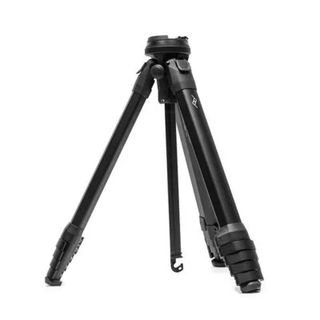
It's the first tripod Peak Design has ever made, but it's the best travel tripod I've ever seen! There is an aluminum version that's a massive 40% cheaper, however, which has all the same design features but just a little less vibration resistance. Read more below
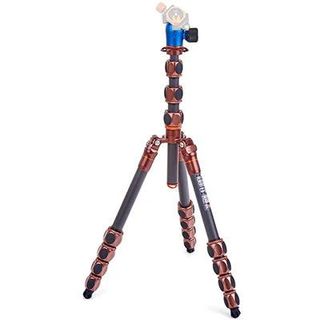
This is no ordinary tripod; it folds down to just 35cm, opens to a height of 146cm, and has a huge 30kg payload. Its detachable monopod leg can be used as a mic or camera boom, and it has a Tri-Mount system for adding accessories. Read more below

The Benro's 6-in-1 billing could fool you into thinking that it's all about versatility, but it's a very good travel tripod. Even at full height, it's impressively stable, and it packs extra features that could come in handy whether shooting on a camera or a phone. Read more below

If you love shooting at low angles then this will give you the flexibility you need to make dramatic shots without the fuss. Read more below

If you love taking selfies as much as you do shooting landscaped this all-in-one kit could be right up your street. Read more below
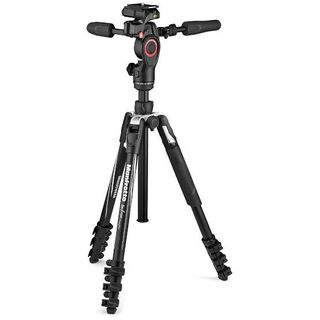
If you love taking stills and videos of stunning landscapes while out hiking this is your best bet with a built-in three-way video head. Read more below

Matthew Richards is a photographer and journalist who has spent years using and reviewing all manner of photo gear. He is Digital Camera World's principal lens reviewer – and has tested more primes and zooms than most people have had hot dinners!
His expertise with equipment doesn’t end there, though. He is also an encyclopedia when it comes to all manner of cameras, camera holsters and bags, flashguns, tripods and heads, printers, papers and inks, and just about anything imaging-related.
In an earlier life he was a broadcast engineer at the BBC, as well as a former editor of PC Guide.
The best travel tripods
Why you can trust Digital Camera World Our expert reviewers spend hours testing and comparing products and services so you can choose the best for you. Find out how we test.
Best travel tripod: Best tripod overall
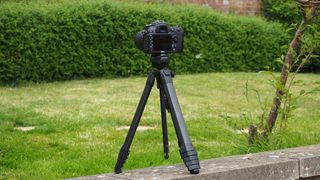
1. Peak Design Travel Tripod
Our expert review:
Specifications
Reasons to buy, reasons to avoid.
The Peak Design Travel Tripod may be the first tripod that Peak Design has made, but it's hands-down the best travel tripod that I've ever used! There is an aluminum version that's a massive 40% cheaper, however, which has all the same design features but just a little less vibration resistance. A couple of the other tripods here will go higher, but the Peak Design will still go to eye level for an average-height person, and it packs down to just 39cm in length.
It's designed to cut out the dead space between the legs and the column when packed, which means it's not just short when folded but very slim too – you could put this IN your camera bag or cabin bag as well as strap it to the outside. The low-profile ball head is simple but brilliant, there's a phone holder hidden inside the center column, and best of all this tripod feels seriously rigid.
Read our full Peak Design Travel Tripod review for more details
Best travel tripod: Best for versatility
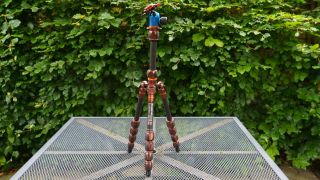
2. 3 Legged Thing Leo 2.0 + AirHead Pro Lever kit
The 3 Legged Thing Leo 2.0 is no ordinary tripod. It folds down to just 35cm in length but opens out to offer a maximum height of 146cm and a huge payload capacity of 30kg.
It has a detachable monopod leg which can also be used as a microphone or camera boom, a Tri-Mount system for adding accessories, and an innovative two-section center column. You can buy the legs on their own but we’d recommend getting it as a kit with 3 Legged Thing’s new and improved AirHed Pro Lever ball head.
The Leo 2 is not the smallest travel tripod you can get, and not the cheapest, but its ratio of folded length to maximum height, combined with its all-around versatility, make it one of the best.
Read our full 3 Legged Thing Leo 2.0 + AirHead Pro Review for more details
Best travel tripod: Best budget tripod
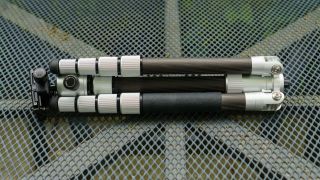
3. Benro MeFoto RoadTrip Pro Carbon Fiber
The 6-in-1 billing of the Benro MeFoto RoadTrip Pro could fool you into thinking that it's all about versatility, but it's also a very good travel tripod. Even at full height it's impressively stable for its build, and it packs a few extra features that could come in handy whether you're shooting with a camera or a phone.
It's an excellent travel tripod, and the built-in monopod and mini tripod are genuinely valuable additions. It's great that things like the hex key, small tripod legs, and smartphone clamp are contained within or attached to the tripod, because you're unlikely to forget or lose them – but it does mean that the tripod is a little heavier than it needs to be.
Read our full Benro MeFoto RoadTrip Pro Carbon Fiber review for more details
Best travel tripod: Best for low angle

4. 3 Legged Thing Punks Corey 2.0
All of the Punk tripods from 3 Legged Thing are travel-friendly, but the Corey 2.0 is the smallest and easiest to pack for the journey. It has swing-up legs with five sections in each, plus a two-section head, enabling a decent maximum operating height but a very small stowage size.
It ticks another two boxes on our wish list by easily converting to a monopod, and enabling ultra-low-level shooting with the option of attaching the ball head directly to the canopy (leaving the center column out of the equation). All three legs are removable, and Vanz footwear (sold separately) transforms the Corey 2.0 into a stylish tabletop tripod.
Read our full 3 Legged Thing Punks Corey 2.0 review for more details
Best travel tripod: Best for selfies
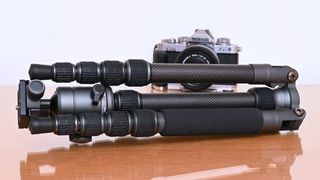
5. Vanguard VEO 3GO 235CB
With five sections in each swing-up leg and a two-section center column, this Vanguard folds down to just over a foot long yet gives a reasonable maximum operating height. It’s also very lightweight although, as expected, the alternative aluminum version is a little heavier. The bottom leg sections are quite spindly, with a diameter of just 11mm, but stability is pretty good even at full stretch.
As well as giving a typically quick and easy change to monopod configuration, the Vanguard is more unusual in coming complete with a smartphone adapter. This enables the monopod mode to double up as a selfie stick.
Read our full Vanguard VEO 3GO 235CB review for more details
Best travel tripod: Best for hybrid use

6. Manfrotto Befree 3-Way Live Advanced tripod
The Manfrotto Befree 3-Way Live Advanced is a lightweight photographer’s travel tripod paired with a three-way video head. The fluid head uses a hydraulic damping system to make it easy for smooth, fluid camera movements. The tripod, meanwhile, provides a good balance between capacity, weight, and price. It’ll take 6kg of kit and only weighs 2kg itself. We’ve tested lighter and stronger tripods, but they tended to be more pricey than this one.
It’s not as tall as some of the other tripods on this list, and we did find during testing that sometimes the design interfered with routine operations like changing the camera battery. But, for the vast majority of purposes, this is an impressive all-around package and merits serious consideration for any traveling photographer or videographer.
Read our full Manfrotto Befree 3-Way Live Advanced tripod review for more details
Best travel tripod: Best small but stiff
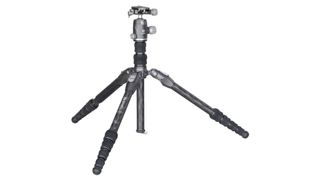
7. Benro Rhino FRHN05CVX20
The Benro Rhino FRHN05CVX20 is the smallest of Benro’s four new Rhino travel tripods, but we found that it’s remarkably stiff for such a compact tripod – and Benro’s new VX ball heads and their secondary pan axis just under the camera plate are a triumph. Travel tripods have limitations, such as a lower working height and longer ‘unfolding’ time, but this goes with the territory and we can’t criticize the Rhino for this.
This Benro doesn't extend that high, and it soon gets wobbly if you use both center column sections, but with a single column extension or no center column it's as rigid as much bigger tripods.
Read our full Benro Rhino FRHN05CVX20 review for more details
Best travel tripod: Best for compact use
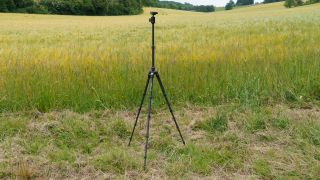
8. Vanguard VEO 3T 235CBP
The Vanguard VEO 3T 235CBP has an 8kg payload rating and a compact 41cm closed length, while carbon construction keeps total weight down to a reasonable 1.6kg. The included head has a removable pan handle to allow greater control while filming, and a new Arca-compatible quick-release plate can hold a camera or smartphone up to 85mm wide.
It packs down quickly and neatly for easy transport, the leg locks feel great and do their job perfectly, you get spikes to swap out for the standard rubber feet, plus there's even a Bluetooth remote control for iOS or Android .
Read our full Vanguard VEO 3T 235CBP review for more details
Best travel tripod: Best for full frame

9. Manfrotto Befree Advanced Twist
The Befree Advanced Travel Tripod Twist is all about travel but offers extra support compared to most similar products. Its safety payload tops out at 9kg, though in our tests we found that it was able to take an awful lot of gear – we’re talking full-frame cameras with heavy lenses. Still, its key feature is that it weighs a mere 1.49kg, and when packed up it's just 40 cm long (though its ball head adds another 14cm). That’s compact enough to fit into most luggage.
The Befree Advanced Travel Tripod Twist comes bundled with Manfrotto’s compact Advanced 494 aluminum center ball head, which has three independent ergonomic controls. Factor in the super-sturdy center column – complete with a locking mechanism – and this travel tripod has an excellent ability to remain solid and steady.
Read our full Manfrotto Befree Advanced Twist review for more details
Best travel tripod: Best for serious shooting
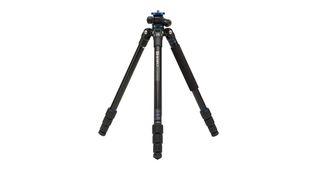
10. Benro GoPlus Travel FGP18A
Ticking just about every conceivable box on our wish list, the Benro GoPlus has a modest folded length and generous operating height, coupled with a hefty maximum load capacity. It’s one of a handful of tripods to feature a pivoting center column, enabling a range of locking angles in small increments, through a complete 180-degree arc.
Bubble levels are fitted to the tripod platform for easy leveling, and interchangeable rubber feet and spikes are supplied, along with a padded soft case. One leg can be unscrewed to use as a standalone monopod. However, while it was once sold as a kit with a head, you'll now need to order a ball head to go with it (if you don't have one already). The Benro B0 or IB0 would be a good match.
Best travel tripod: Best for vlogging
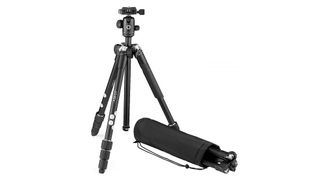
11. Joby RangePod Smart
For vloggers and content creators, choosing the right tripod can be a real minefield. Unless you're well versed in photography accessories (and even if you are!), the sheer volume of tripods and heads can be overwhelming. Enter Joby , maker of the GorillaPod range, to provide creators with a straightforward solution that ticks all the right boxes. The Joby RangePod Smart is the manufacturer's first full-size tripod and is a worthy travel offering in its own right.
However, this aluminum number is ideal for those who shoot on their phones; it includes a phone clamp with a pair of quarter-inch attachment points to mount your phone horizontally or vertically, so you can quickly switch between regular recording and upright shooting for Instagram or TikTok . With a quick-release Arca-Swiss plate, it's just as adept if you're using a DSLR or mirrorless camera – and its 8kg payload means it can handle chunky lenses with no problem. With a maximum 160cm height, it's also taller than many travel tripods – making it perfect for presenting to the camera at near head height.
Best travel tripod: Best looking

12. Gitzo GT1545T Series 1 Traveler with ball head
Gitzo tripods are the Rolls Royce of camera supports, and the Traveler series combines light weight, superb build and design, and disarmingly simple operation. The GT1545 Series 1 model has 4-section legs, but there is a GT1555 version with 5-section legs – it all depends on whether you favor a speedy setup (fewer sections) over a shorter folded length (more sections).
The prices don't look too bad until you factor in the cost of the admittedly brilliant Gitzo 82TQD center ball head. It's an excellent travel tripod, but its price stops the Gitzo from getting to the top of our list – especially since there are a number of equally good tripods that don't have the glamor of the Gitzo brand, but are a lot cheaper to buy. But secretly we all want a Gitzo, right?
Best travel tripod: Best for video

13. 3 Legged Thing Jay with AirHed Cine
It's not just stills photographers that need travel tripods! The Jay and AirHed Cine are a pretty specialized combination, but they cater to a growing population of serious videographers and one-person filmmakers who don't need a massive professional video tripod but still require proper, portable support.
The 3 Legged Thing Legends Jay has no center column (this is video, not eye-level stills photography), but it does have a leveling base – a huge time-saver for setting up panning shots and keeping the camera level. The AirHed Cine is as compact as the Jay and feels like the perfect partner. It has a firm but controllable fixed drag action and a screw-on handle for precise control. The Jay is not too pricey on its own, but if you add the AirHed Cine the price takes a leap. The combination is really compact, though, and just oozes quality.
Best travel tripod: Best unusual design
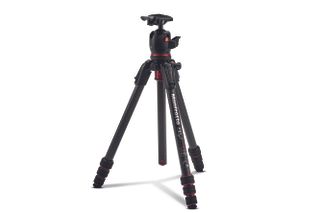
14. Manfrotto 190go!
Unlike many current travel tripods, this Manfrotto doesn’t feature swing-up legs. It also has four rather than five sections in each leg, and a single-section center column. The upshot is that it doesn’t fold down particularly small, but is relatively quick and easy to set up.
It’s also unusual for a travel tripod in featuring a pivoting center column, which you can use as a horizontal boom. That’s good news for macro photography, really low-level shooting, and for ultra-wide-angle shots. It’s generally sold as a set of legs with no heads but is available in some regions as a complete kit with a high-performance Manfrotto 494 Ball Head. Either way, both aluminum and carbon fiber versions are pricey but a top buy.
Best travel tripod: Best for monopod mode
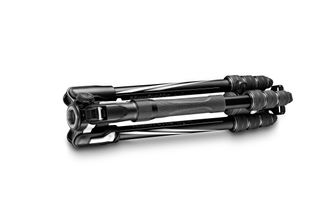
15. Manfrotto Befree 2N1
Unlike some in the Manfrotto Befree range, the 2N1 is only available in aluminum, but you can choose between clip locks and twist locks for the 4-section legs. We prefer the ‘M-lock’ clamps of the twist-action edition, which have a very simple and speedy action.
The tripod has good build quality and an appealing finish, along with a smart ball head that features an adjustable friction damper. It also boasts an Easy Link socket for attaching accessories and has a refined locking mechanism for its multi-angle legs. The quick-release plate is specially shaped to be Arca-Swiss compatible but the ball head platform isn’t, instead being designed to accept Manfrotto’s popular 200PL plate.
Best travel tripod: Best tabletop tripod

16. Benro TablePod Flex Kit
If you're looking for a versatile tabletop tripod that isn't solely confined to a tabletop, look no further than the Benro Tablepod Flex. It has flexible legs stored inside its metal legs that enable you to secure it to surfaces that aren't flat – and can also be used to simply extend the length of the legs.
It packs down really small, can be used as a selfie stick or monopod, and is suitable for either a small mirrorless camera a compact or a smartphone (a phone mount is included). If you like to shoot video it also comes with two accessory arms, which means you could attach an additional light or microphone. It's more expensive than most tabletop tripods but it does so much more – so we think it's worth it.
Read our full Benro TablePod Flex Kit review for more details
Best travel tripod: Best phone tripod

17. Manfrotto Pixi Evo
The Pixi Evo is an advanced version of the original Manfrotto Pixi model and is just as fast to use – you flip out the legs to use it as a tripod or push them back together to make a camera grip – with a ball head that’s released and locked with a simple push button. It's one of the best phone tripods .
What the EVO adds is two-section legs (yes, really) and two leg angles for low-level shooting. You can get an optional smartphone clamp but its ball head fits directly into regular camera tripod sockets, and it can support compact cameras and small DSLRs, and mirrorless models. Yes, the maximum height is restricted, but it’s super-fast to set up and you can keep it in a jacket pocket! This, or a mini-tripod like it, is the best travel tripod for those who don't want to carry a full-size version.
How to choose the best travel tripod
It’s good to be choosy when picking your perfect travel tripod for your needs and budget. Here’s a few things to bear in mind…
Carbon fiber is pricier than aluminum, but is it worth the extra?
Up-market tripods are usually made from carbon fiber instead of aluminum. They have a more luxurious feel, a smarter looking finish, and can be slightly more resistant to vibrations. Carbon fiber can also feel less cold to the touch. But the main advantage of carbon fiber is that it’s more lightweight than aluminum, giving it a clear advantage when you’re trying to shed weight. However, there can be diminishing returns. Although the weight-saving can be substantial in full-sized tripods, it’s much less noticeable in relatively small tripods. For many travel tripods that are available in both aluminum and carbon fiber options, the latter typically only saves around 200g in weight, little more than 10 per cent. Considering that the carbon fiber editions are often about 50 per cent more expensive to buy, aluminum travel tripods can be more cost effective.
How small is the tripod when folded?
A decade ago, the Giotto’s company launched a series of Vitruvian tripods, named after Leonardo da Vinci’s drawing, ‘The Vitruvian Man’. As in the drawing, the legs swing upwards but, in the case of the Giotto’s tripods they swung up completely, adopting a vertically upright orientation for stowing away. The trick was that, by fully extending the center column before swinging the legs up, the tripod head no longer extended beyond the length of the legs, making the carrying size much smaller. Many recent travel tripods fold down small enough to fit inside a bag or backpack, rather than needing to be tethered to the outside.
Can I save space by using a tripod as a monopod as well?
A neat trick of many recent travel tripods is that you can unscrew one of the tripod legs, detach the center column, and join the two together for use as a monopod, complete with ball head. That can be a real space saver if you like using a monopod as well as a tripod, as you only have to carry one bit of kit.
What’s so good about multi-angle legs?
Pretty much all travel tripods these days have legs that can be locked at multiple angles to the center column. Typically either two or three alternative angles are available, in addition to the legs being able to swing up vertically. This can help when you’re shooting on uneven terrain, or when there are obstacles in the way. For example, you might need to use one or two legs in a near-horizontal orientation and place the feet on a wall or table to get into your desired shooting position. Another bonus is that, by splaying the legs to a wider angle when shooting at low operating heights, you can increase stability and reduce the risk of the tripod toppling over if knocked.
How low can you go when shooting with a tripod?
Multi-angle legs help to reduce the minimum shooting height but the limiting factor is generally the point at which the center column touches the ground. The minimum height is therefore the height of the center column plus the ball head. A two-section extending center column can help to further reduce the minimum operating height, as well as the carrying height. Some tripods are supplied with a short, stubby ‘low angle adaptor’. You can attach this to the tripod head and use it instead of the center column. The center column is also removable in most tripods, so you can invert it and shoot from between two of the legs with the camera upside down, right down at ground level.
What’s best for feet, pads or spikes?
Rubber pads are the normal footwear for tripods these days. They work well on solid ground as well as on grass and sandy areas. For soft surfaces like carpet, spikes can offer a more assured footing. Some tripods are supplied with both rubber pads and metal spikes, so you can swap between them as needed. Another option that used to be more common in the past is rubber pads on a threaded mount, so you can screw them in to reveal metal spikes beneath.
How we test travel tripods
We measure the maximum operating height of each tripod and its folded height for carrying, complete with head attached. We also measure the combined weight of each set of tripod legs and head, using electronic scales, and measure the diameter of all leg sections, from the widest to the thinnest, using digital calipers.
We check the ease of use, smoothness and precision of all available adjustments in each set of tripod legs and heads. This ranges from adjusting leg sections and pivot facilities (where available), to the locking mechanisms of the head, as well as independent pan and friction damping adjustments, where fitted.
To check overall stability, we shoot with a range of camera bodies fitted with wide-angle, standard, telephoto and macro lenses. We look for good resistance to flexing and vibrations throughout the whole range of operating heights, including the tallest available settings with the legs and center column fully extended.
Get the Digital Camera World Newsletter
The best camera deals, reviews, product advice, and unmissable photography news, direct to your inbox!
- James Artaius Editor
Related articles

The 12 Best Travel Tripods for Your Next Adventure
No matter where your wanderlust takes you, you’ll capture the moment better with this essential piece of gear.
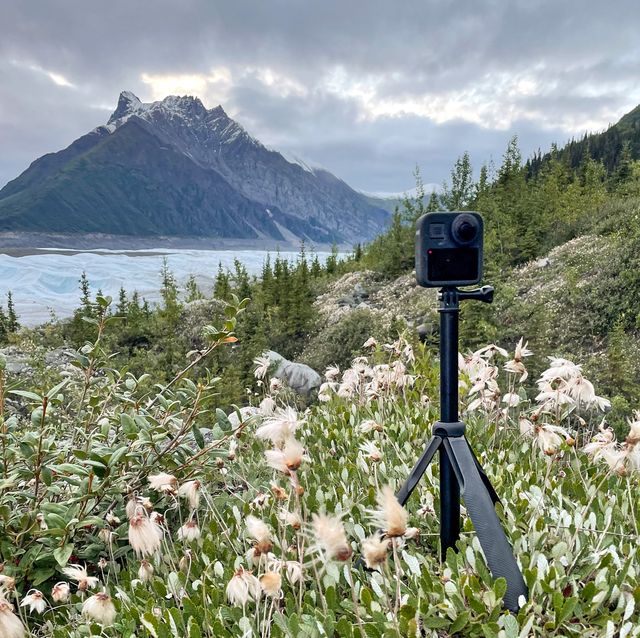
Gear-obsessed editors choose every product we review. We may earn commission if you buy from a link. Why Trust Us?
However, that premise goes out the window as soon as the shooting conditions change. If you want to shoot with a long exposure time, shoot in low-light or nighttime conditions, shoot video , or just want to take nice solo photos when you're traveling alone, you'll want a travel tripod.
While tripods are useful, they also tend to be bulky and heavy, so having a specific tripod for travel makes a big difference. Compared to standard tripods, travel tripods are usually smaller when collapsed, weigh less, and have smaller secondary parts like hinges, feet, and handles.
Not all travel tripods are created equal, though. Some are better suited to large DSLR cameras , while others may only work with smartphones. Here are the best travel tripods to consider for your upcoming vacation to suit all budgets, camera types, and experience levels.
Best Travel Tripods
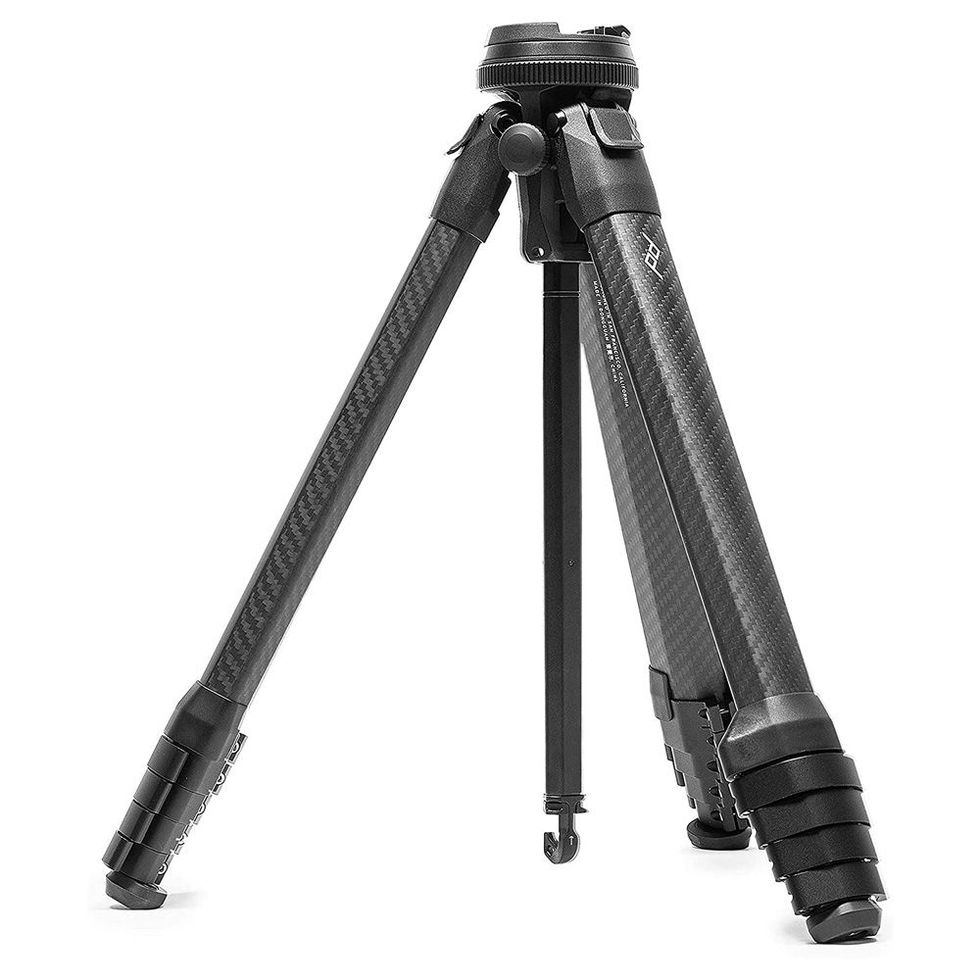
Best Overall
Peak design carbon fiber travel tripod.
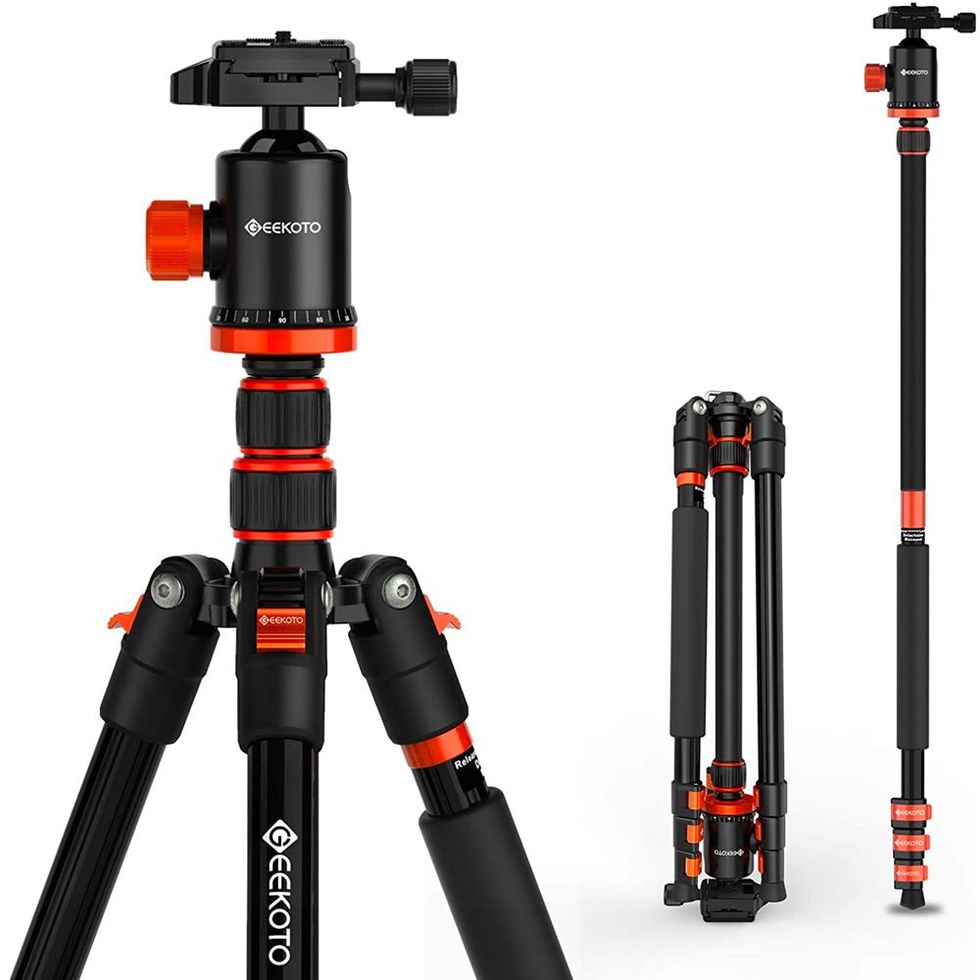
Geekoto Tripod, Camera Tripod for DSLR AT24EVO

Best Travel Tripod for Professionals
Dji osmo mobile se intelligent gimbal.

Best for Smartphones
Atumtek selfie stick tripod.
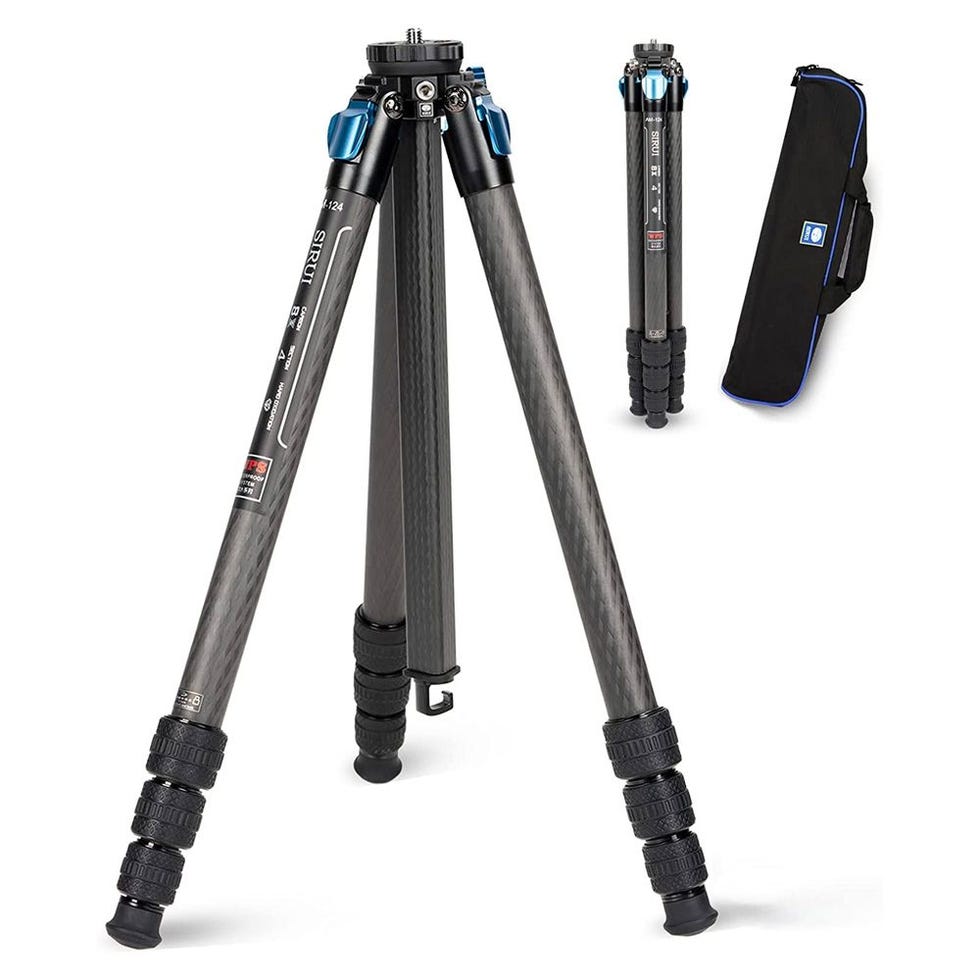
Best Travel Tripod for Heavy Cameras
Sirui am124 carbon fiber tripod.
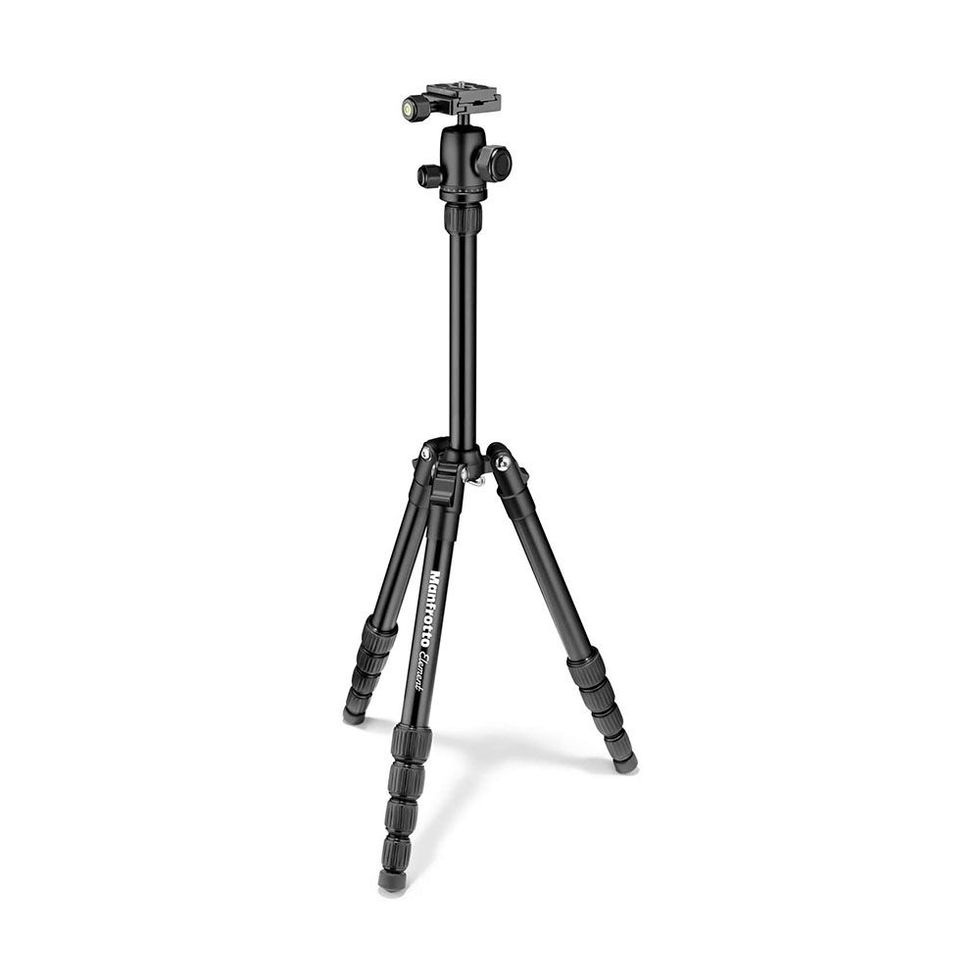
Best Ball Head
Manfrotto element traveller 5-section tripod kit.

Best for Action Cameras
Gopro max grip + tripod.
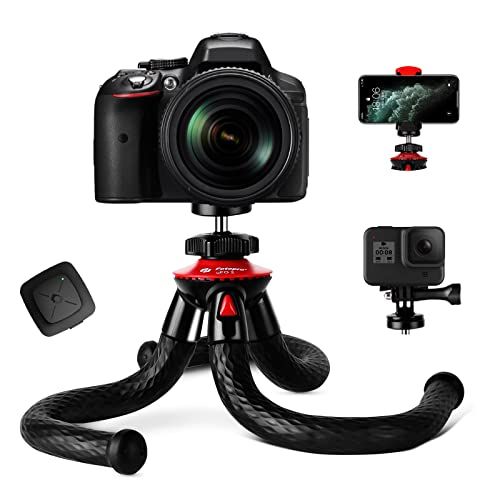
Best Flexible
Fotopro flexible camera tripod.
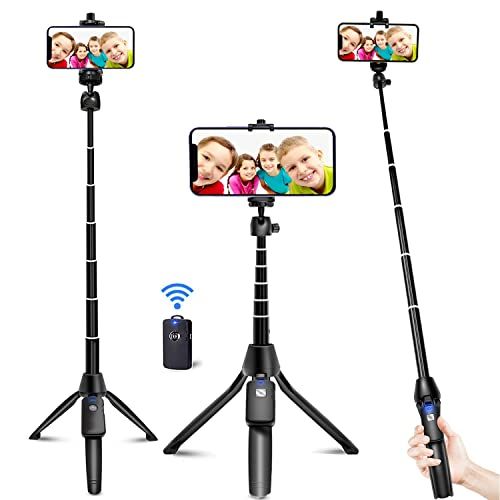
Most Compact
Bze selfie stick.
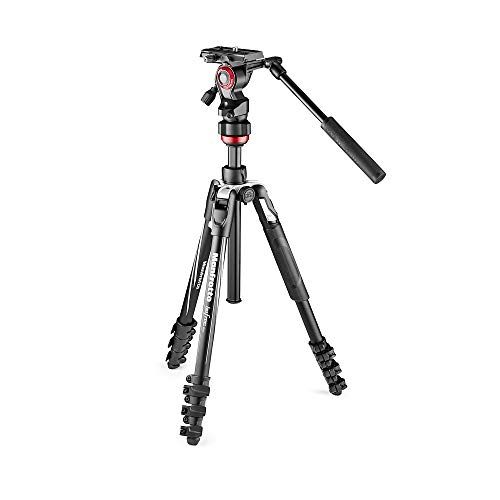
Best for Video
Manfrotto travel video tripod.
The Expert: I'm a freelance travel writer and editor who focuses primarily on adventure travel, which means I often take photos for stories in challenging conditions. While landscape photos may seem easy, I often shoot scenes with moving water, night sky, and time-lapse shots, which all require a tripod. I've used many tripods while traveling and am very conscious of weight and size as I often come close to airline weight limits with my bags, especially if I'm already carrying a heavy camera and lenses.
What to Look for in a Travel Tripod
Not every travel tripod will be marketed as a travel tripod, so when selecting one to use during travel, there are a few specific factors to consider.
One of the two most important considerations is weight. Every pound counts when you're working against airline baggage weight limitations, especially on smaller planes or airlines with lower-than-normal weight limits. Sturdy studio tripods can easily weigh into the 15-plus-pound range, but for a travel tripod, you'll likely want to keep it somewhere around 4 pounds or less—roughly the weight of a pair of boots. Plastic travel tripods will probably be the lightest but potentially the least durable. Carbon fiber is extremely strong and lightweight, but much pricier.
Our Pack-and-Go Picks: Best Travel Accessories | Best Travel Bags | Best Travel Gifts
The second most important factor is size. Traditionally, tripods have (as the name belies) three telescoping legs. Travel tripods still have that feature, though many have uniquely shaped legs or modified center columns and handles to make them thinner and shorter when compressed, at least compared to a tripod not designed for travel.
Next, consider the weight capacity/limit: If you find an inexpensive tripod with small measurements, look at the weight rating before you buy it, especially if you have an SLR camera with heavy lenses. Every travel tripod should say the maximum weight it can hold. Keep in mind there are risks to exceeding the weight rating. Either the tripod will break or, more likely, the weight of your camera and lenses will cause it to tip forward, potentially damaging your camera.
Finally, look at the device that attaches your camera to the tripod (called a mount, or mounting plate) and make sure the mount will work with your camera. If you're buying a smartphone travel tripod, get one with a smartphone mount (usually a spring-loaded hook that grips across the back of your phone). If you're looking for a travel tripod for a DSLR, make sure your camera has a threaded hole on the bottom.
Look for a tripod with a quick-release plate to make mounting and removing your camera much. Quick release plates stay screwed into the bottom of your camera and snap onto your tripod, so you don't have to thread your camera in each time.
Note: You can buy tripod mount adapters, but you'll still have to deal with weight limitations—so you can usually mount lighter cameras to smaller tripods, not the other way around.
How We Selected These Travel Tripods

To choose the best travel tripods, I relied on my personal experience using travel tripods and talking with other photographers on their preferred brands and tripod features. From there, I narrowed down my potential picks, then researched user reviews, materials, and features for each.
Once I had a roundup of the top travel tripod options, I finalized my selections based on the best for each superlative below, intentionally choosing from a variety of brands, price points, and photography experience levels.
Peak Design doesn't make dozens of products within each category, but the ones it does make are incredibly well designed and engineered, and very intentional—there’s a reason behind every material and feature selection.
That seems true of the brand’s highly awarded travel tripod, which packs features like a hidden phone mount, a ball head with a twistable lock, extra clips for straps and attachments, and legs that can lower into an almost-flat position into a very lightweight package.
It may look like a standard tripod from the outside, but what makes Peak Design Travel Tripod so great for travel is its compact circumference. When packed, the tripod’s legs, ballhead, and adjustable central column fit together like puzzle pieces, allowing it to be much thinner than most travel tripods. Peak Design is also a B-Corp, is a member of 1% for the Planet, is climate neutral, and has a gear resale program to keep used gear out of landfills.
If you’re not hung up on name brands or particularly care about having a tripod that’ll be able to handle extremely tough conditions, consider the Geekoto AT24Evo. It may not be made with ultralight, ultra-durable materials like higher-end travel tripods, but you get features of much more expensive options in a relatively inexpensive package. That includes a ballhead for a full range of angles, a tall maximum height, a detachable monopod (akin to a selfie stick), and a quick-release plate.
This is an ideal budget tripod for tall shooters as it has an impressive maximum height of 77 inches, though that does come with a relatively long (19 inch) packed length.
Tripods with gimbals—weight-balanced devices that allow cameras to smoothly pan and rotate even while moving—were once solely the provenance of big-time Hollywood videographers. But now, with so many travelers making their living as professional content creators, travel tripods with gimbals have become much more common—and much more affordable.
This unit moves on three axes and the DJI app has built-in templates for easy shooting and editing. Features include motion stabilizing, single-finger controls, snap-on phone connectivity, and gesture control so you can stay in charge even when you’re in front of the camera.
The only downside is that the actual tripod part is fairly short, but that’s a fair trade-off considering it’s a travel tripod, camera gimbal, and selfie stick in one package small enough to fit in a jacket pocket.
For those who mostly take pictures on their smartphone, this unit has a convenient 2-in-1 design that’s ideal for traveling. It weighs less than 1 pound and folds down into a compact 12 inches, yet as a tripod, it reaches 51 inches tall. It can also be held as a selfie stick for those times you want a group photo.
This tripod is compatible with most popular smartphones, including iPhones, Samsung Galaxy, Google Pixel, and more. It comes with a rechargeable Bluetooth remote—a big bonus—that you can use for self-portraits while traveling solo.
It’s possible to find travel tripods that hold more than 26 pounds—but unless you’re a Hollywood cinematographer shooting on a massive video camera, they’re likely going to be overkill. The weight rating on the SIRUI AM124 Carbon Fiber Tripod is more than enough for heavy cameras with massive lenses, and I love that it has extra stability-focused features like retractable spikes on the feet and a central hook to add extra weight for counterbalancing the camera.
Aside from the price, the biggest downside is that photographers will have to make due with just a til-and-pan mount, or pay nearly $100 extra for the ball-head version .
The aluminum ball head on this travel tripod allows you to easily adjust your camera’s angle to capture any shot, with an independent 360-degree pan. It weighs less than 1 pound and extends to more than 56 inches, thanks to its five-section telescopic legs, which can also be positioned independently to accommodate any terrain.
The travel tripod has a maximum weight capacity of 8.8 pounds, making it best suited for small DSLR cameras, and a spring-loaded hook at the bottom of the center column to add weight for extra stability. It also comes with a carrying case for easy transport.
One of the reasons action cameras are great for travel is they can be mounted on almost anything—helmets, chest straps, underwater handles, and even the tips of skis and snowboards. But having multiple mounting options is useless if what you really need is a way to hold it still for time lapses or on-camera video recording.
Fortunately, the GoPro Max Grip + Tripod is both an extendable selfie stick and a tripod in one, and its compact size is one of the smallest I’ve seen. I keep my action cam mounted to it throughout my travels as the twist-locks are easy to deploy and the magnetic legs keep the tripod secure when I’m using it as a selfie stick.
The slim design is ideal for keeping the tripod mostly out of the frame on 360-degree action cameras, but it’ll work with any type of action camera that uses a similar mount.
This tripod doesn’t offer the height of a standard model, but its unique flexible (and waterproof!) legs can be wrapped around any surface—including trees, fences, poles, and more—allowing you to capture unique angles. The tripod comes with attachments for a standard camera, smartphone, and GoPro, and it has a ball head that easily rotates 360 degrees.
This travel tripod weighs just a few ounces, plus there's a Bluetooth remote control included for selfies. With a reasonable price point, the package is great value for all you get.
This selfie stick is as lightweight and compact as they come, allowing you to easily take photographs of yourself and your travel companions. It’s designed to hold smartphones, including popular iPhone, Android, and Samsung models, and it extends to 40 inches for good wide-angle shots. It also comes with a small tripod base and Bluetooth remote.
Keep in mind that this selfie stick is designed for smartphones only, not a heavy DSLR camera.
Capture stunning video footage while traveling with this tripod, which extends to nearly 5 feet and offers 360-degree panning for incredibly smooth images, thanks to its fluid video head. It also supports cameras up to 8.8 pounds.
Other top features include lever-style leg locks for fast setup, as well as a leveling ball joint to ensure perfect horizontal alignment on uneven ground. It has a removable pan bar and two camera adapters, and there's a carrying case included.
K&F Concept Concept Camera Tripod
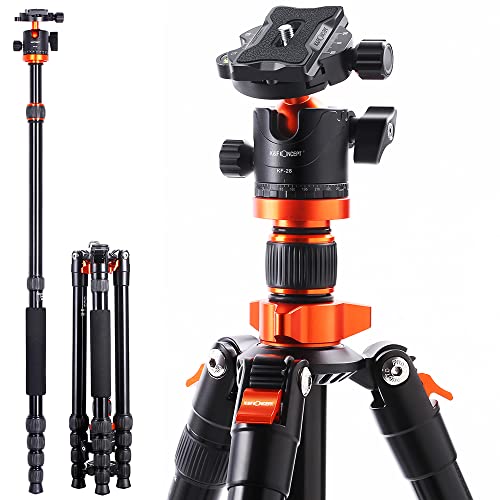
Most tripods have a maximum height around 60 inches (5 feet), but this one extends to 69 inches, allowing you to capture those high-angle shots. The tripod weighs just over 3 pounds, and it has a high, 22-pound maximum weight capacity.
The aluminum-alloy tripod features a 360-degree ball head for panoramic shooting, and one of its legs can be removed to convert it to a monopod. Its inverted central axis allows for low-angle shooting, as well.
National Geographic Travel Tripod Kit

This travel tripod is your best bet for backroad adventures. Constructed of lightweight carbon fiber, it weights less than 3 pounds and easily converts to a monopod for nature photography. Plus, it comes with a durable carrying case.
Other highlights include five-section legs with twist locks, a 360-degree ball head, and three leg-angle stops for better stability on uneven terrain. Its 90-degree column mechanism allows you to shoot from ground level or directly overhead, and there's a spring-loaded hook on the tripod's bottom to hang it.
Travel Tripods that Go the Distance. Expert Suzie Dundas Offers These Buying Tips!
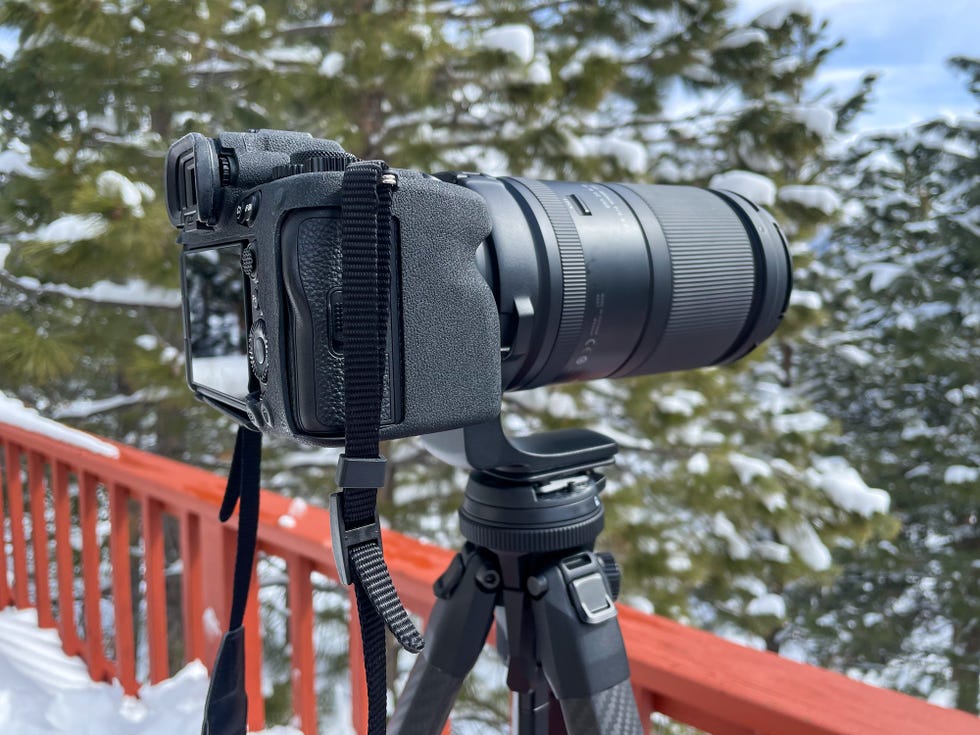
PM : What is the biggest difference between a budget travel tripod and an expensive one?
SD: The difference can vary quite a bit. Think of travel tripods as having three main points to evaluate: weight, size, and strength. You can generally have two of those without paying a lot. If you want it to be lightweight and small, it may not be very sturdy. If you want it to be sturdy and lightweight, it may not be that small.
If you want it to be small, sturdy, and lightweight, you’ll probably have to buy a more expensive one. So the biggest difference between an inexpensive travel tripod and a pricey one generally comes down to which of those qualities you’re going to sacrifice (or not).
PM : How important is thickness of a tripod?
SD : Thickness doesn't matter at all—what matters is the sturdiness. In general, it’s fair to say that thicker tripods will be more stable, but that’s not to say that there can’t be thin, stable tripods, especially if they’re made with strong materials like carbon alloys. The actual thickness of the materials is secondary.
The only exception to this may be if you choose a travel tripod with plastic legs (which will likely be an inexpensive option). You may want to go with something a bit thicker to reduce the chances of it breaking or getting bent if it accidentally gets sat on or smashed in your suitcase.
PM: Twist or flip?
SD : With telescoping legs, you’ll find two methods of locking the legs when extended: twist locks or flip locks. Twist locks are easy to use: twist the locks in one direction to lock them, twist them in the other direction to unlock (and collapse) them; It’s essentially a wringing motion.
Tripods with twist locks are generally less bulky, setup is quick, and the lack of extra levers means they’re less likely to get snagged or caught on straps and bags. However, it can be easier to think they’re locked when they’re not, and they can trap abrasive materials like dirt and sand in the mechanisms if not cleaned occasionally.
Flip-style locks have some kind of lever or tab you’ll flip to switch between locked and unlocked. These levers may add a bit of extra width or bulk to your tripod, and they’re a bit slower to set up as most tripods will have at least six of these levels on the legs.
However, buyers who are new to using travel tripods will likely benefit more from flip-style locks, as it’s much easier to tell with a glance if they’re locked or not, eliminating accidental falls. Twist locks also tend to be a feature of higher-end (i.e. more expensive) travel tripods.
PM : How much is too much to pay for one of these?
SD : How much is too much to pay for a travel tripod is an impossible question to answer, except in very broad strokes: plan to pay somewhere between $30 and $1,000.
Travel tripods designed for phones and action cameras will generally be cheaper than travel tripods for professional-level cameras. You can get a high-end, durable travel tripod for a phone for less than $100, and likely less than that.
However, if you’re shooting on a more expensive camera, you don’t want the device holding that camera to be too inexpensive or poorly made. You also want to ensure your travel tripod for a DSLR can maintain its integrity and strength even when knocked over on rough ground or airplane storage bins, banged around in your luggage, or handled roughly in transit. Cameras are expensive and you want to be able to trust your tripod to protect them.
That’s not to say you need to go much beyond the $300 range, but it does mean DSLR shooters won’t want to consider price as the most important factor. And if you’re shooting professional-level content with extremely long or heavy lenses, you’re probably looking more at the $500 range, especially if you add a DSLR gimbal attachment.
PM : What are some extra features to be on the lookout for?
SD : Travel tripods are certainly not as complicated as the cameras themselves, but there are a few features you need to consider. If you plan on shooting video, you’ll likely want a pan handle. It’s just what it sounds like—a grippy handle you can use to smoothly pan the camera.
Another feature on many, but not all, travel tripods is an adjustable center column. They allow you to adjust the camera height without adjusting the legs. They’re especially useful on travel tripods with flip-style locks that take longer to adjust or for taller photographers.
You’ll also want to look at the tripod head: the apparatus that allows you to move and swing the camera while still attached to the tripod. Many higher-end and professional travel tripods will have ballheads, which can rotate your camera at virtually any angle between 0 and 180 degrees.
The other most frequent travel tripod head is referred to as a “tilt-and-pan.” These generally allow you to move the camera to the left and right, plus forward and backward, but only at 90-degree angles. Travel tripods with ball heads offer a much wider range of flexibility for shooting and are quicker to adjust.
Originally from the East Coast, Suzie Dundas is a Lake Tahoe-based freelance writer and editor who now splits her time between enjoying the outdoors and writing about them—she's the senior outdoor editor at Matador Network and a regular adventure and travel contributor at TripSavvy.com . She has written feature stories for publications like Outside Magazine , SkyLife Magazine , Playboy , Frommers, INSIDER, and more, and contributes couples travel and honeymoon content for TheKnot.com . Suzie co-authored Lonely Planet Sustainable Travel Guide and is the author of 2021's "Hiking Lake Tahoe." She has undergraduate degrees from the University of Maryland and an M.A. in media and political communication from George Washington University. Follow her on Instagram at @HikeUpYourSkirt or find more of her work at suziedundas.com .

.css-cuqpxl:before{padding-right:0.3125rem;content:'//';display:inline;} Adventure .css-xtujxj:before{padding-left:0.3125rem;content:'//';display:inline;}
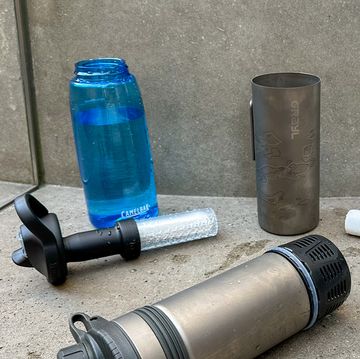
The 9 Best Lightweight Hiking Boots
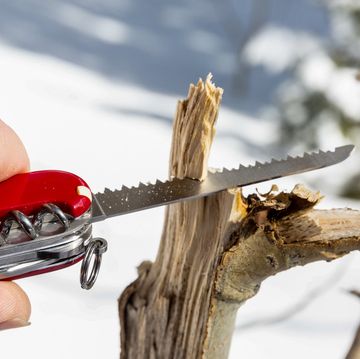
The 10 Best Swiss Army Knives for Home or Away
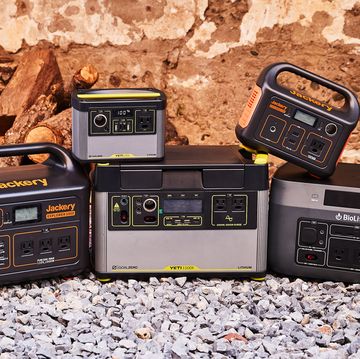
The 9 Best Solar-Powered Generators

The 7 Best Camping Lanterns to Light Up the Night
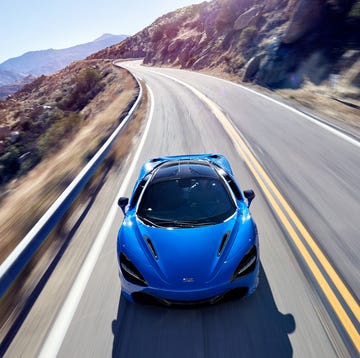
15 Countries Worth Visiting for an Epic Drive
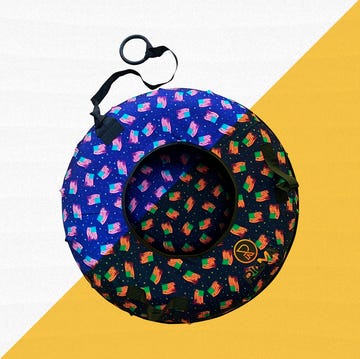
The 8 Best Snow Tubes for Speed, Safety, and Fun
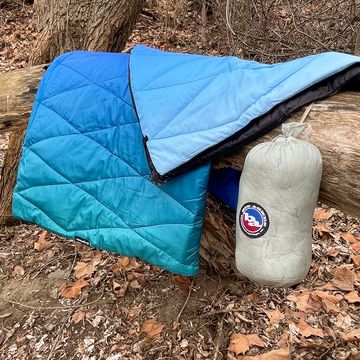
The 7 Best Ultralight Sleeping Bags
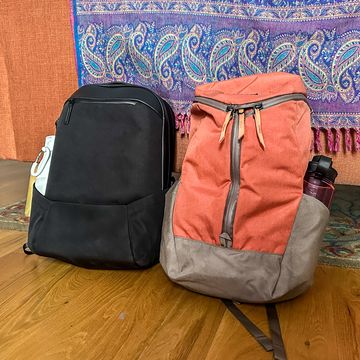
The 7 Best Backpacks for Commuting to Work
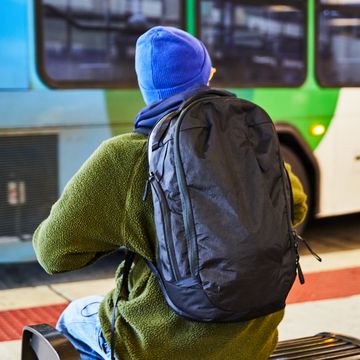
The 9 Best Travel Backpacks for Life On the Go
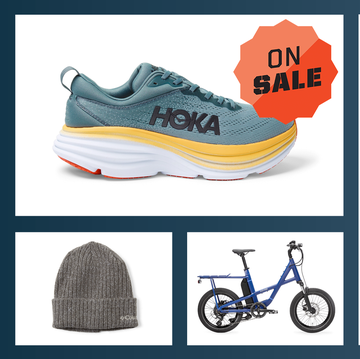
REI Presidents’ Day Sale
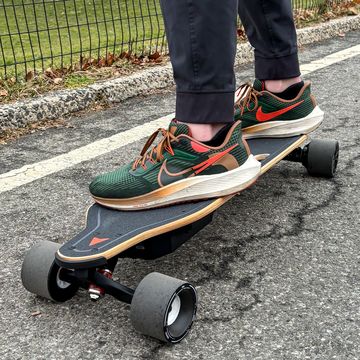
The 6 Best Electric Skateboards

Best Professional Tripod for Heavy Lenses
If your travel photography gear includes DSLR cameras and heavy lenses, use our guide to find the best tripod to meet your needs.
This list of solidly built tripods for heavy lenses will help you get sharper images when photographing in low light, capturing long exposures, panoramas, and panning shots.
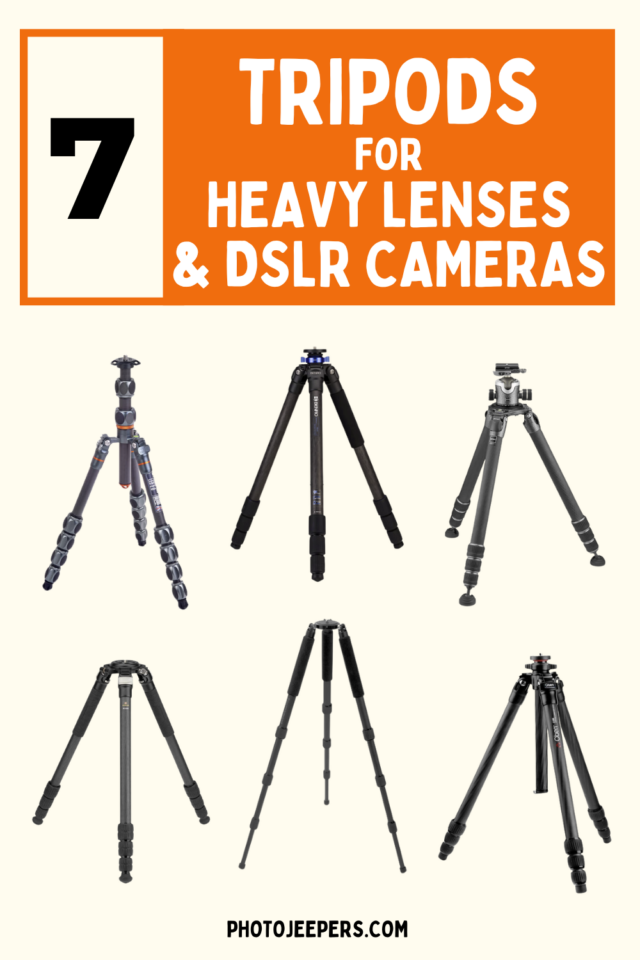
This guide also lists out HOW to choose the best tripod for heavy lenses and DSLR cameras!
For those of you with large and heavy lenses for wildlife photography , this guide will help you find a heavy-duty camera tripod that fits your needs and budget.
Here are a few resources for photographing wildlife:
- Wildlife Photo Tips and Ideas
- Best Cameras for Wildlife Photography
- Best Tripods for Wildlife Photography
- Best Lenses for Wildlife Photography
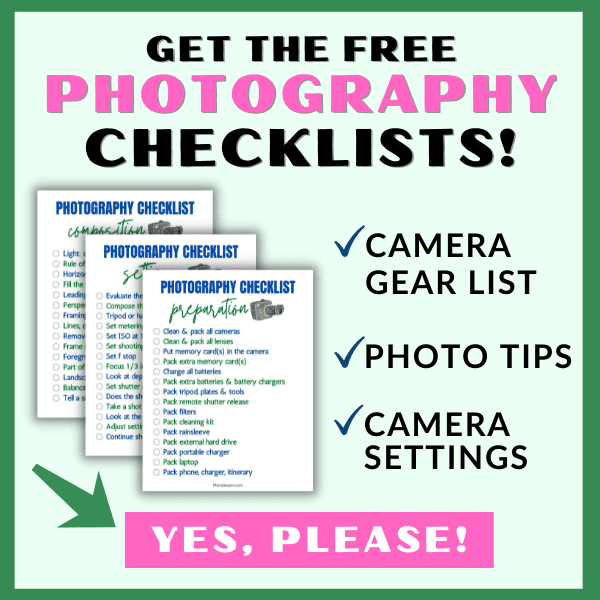
This site contains affiliate links which means WE may receive commissions for purchases made through these links. We only provide links to products we actually use and/or wholeheartedly recommend! As an Amazon Associate, we earn from qualifying purchases. Read the full Disclosure Policy.
At a glance: best tripods for heavy lenses.
Use this chart to see a comparison of tripod features. Read the full descriptions of each tripod below this chart.
Best Professional Tripods for Heavy Lenses and DSLRs
We’ve put together this list of tripods that are made to hold heavy lenses and cameras. Be sure to research the features, capabilities and price to find the one that best fits your photography style and goals.
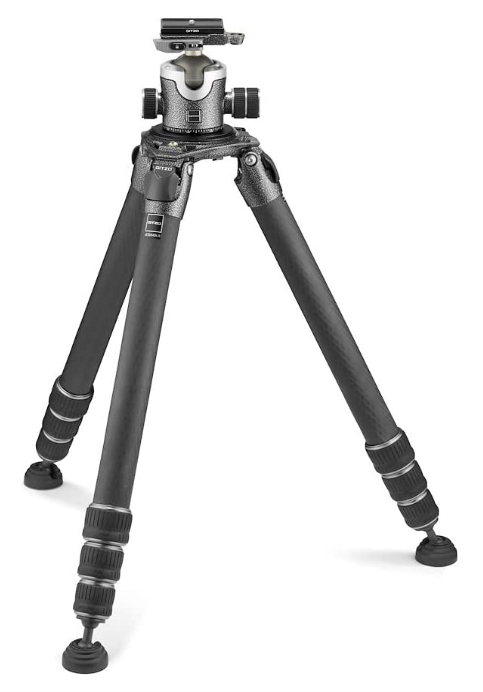
1. Gitzo Systematic Series 5 Tripod
A head-to-head comparison of the RRS TVC-45 and Gitzo Series 5 will leave you more confused than convinced on which of the two is ultimately the best!
But when you dig deeper into their features, variations, versatility, and ease-of-use, Gitzo has an upper hand. That’s why we would consider it before the RRS TVC-45.
Gitzo Systematic Series 5 Key Specs:
- Material: Carbon Fiber
- Load Capacity: 88.18 lb (40 kg)
- Weight: 6.88 lb (3.12 kg)
- Max. Height: 78″ (198 cm)
- Min. Height: 3.9″ (10 cm)
- Folded Length: 28.35″ (72 cm)
- Leg Sections: 4
- Leg Lock Type: Twist Lock
- Head Mount Thread Size: 3/8″-16 Screw
- Independent Leg Spread: Yes
- Bubble Level: Yes
- Center Column: No
The Gitzo Systematic Series 5 comes in five different versions that vary depending on their maximum working height. At the bottom is the “Standard” version with a max height of 52.8″, while at the top is the “Giant” version that towers 109.4″ high.
In between, there are two “Long” versions with 57.1″ and 61.4″ max heights, and an “Extra Long” version that extends 78″ high. We personally find the Extra Long variation the best among the five!
Why? Because the difference in maximum heights of these tripods also affects their weight, leg sections, folded length, and overall resistance to wind vibrations. But keep in mind that they all have a uniform minimum working height of 3.9”.
The Extra Long version has the perfect balance of these features. It stretches 6 feet 6 inches high, making it ideal for tall individuals. And with just 4 leg sections, it will remain steady in all kinds of weather.
- Built to last with relatively lightweight Gitzo’s patented carbon eXact tubing that is extremely sturdy.
- Supports a massive load capacity of up to 88 pounds, but only weighs 6.9 pounds making it very lightweight to carry when traveling or working out in the field.
- It folds down to 28.35” inches, a length that is quite convenient for traveling.
- Very tall but extremely rigid for rock-solid steadiness when shooting with the heaviest of photography equipment.
- The G-lock ultra twist locks offer secure and quick leg-lock operation, which gives it an upper hand on the ease-of-use compared to RRS TVC-45.
- Each leg features a wider 50mm articulating rubber feet for unbeatable stability.
- The rubber feet can be removed and replaced with optional metal spikes for enhanced stability in ice, snow, mud, dirt, and sand.
- The 3.9” minimum working height makes it a wonderful tripod for low-angle and macro photography.
- The tripod base features a 3/8″-16 Easy Link attachment thread where you can connect a variety of accessories like shoe adapters and magic arms.
- Quite pricey.
- The 28.35″ folded length won’t fit in the standard carry on luggage.
The Gitzo Systematic Series 5 is what you invest in when you want to shoot pro-quality photos. It will hold up even the heaviest of setups with excellent stability.
The extra height makes it great for professionals who want to get up high with super-telephoto zoom lenses like in architecture, wildlife, and astrophotography.
If you would like an extra height, you can go for the Giant version that extends 109.4” high. Otherwise, I would recommend the 57.1″ Long version, with 3 leg sections, if you’d like a shorter, more stable version of the same.
CHECK AVAILABILITY & PRICE:
- Amazon: Gitzo Series 5 Tripod
- B&H Photo: Gitzo Series 5 Tripod
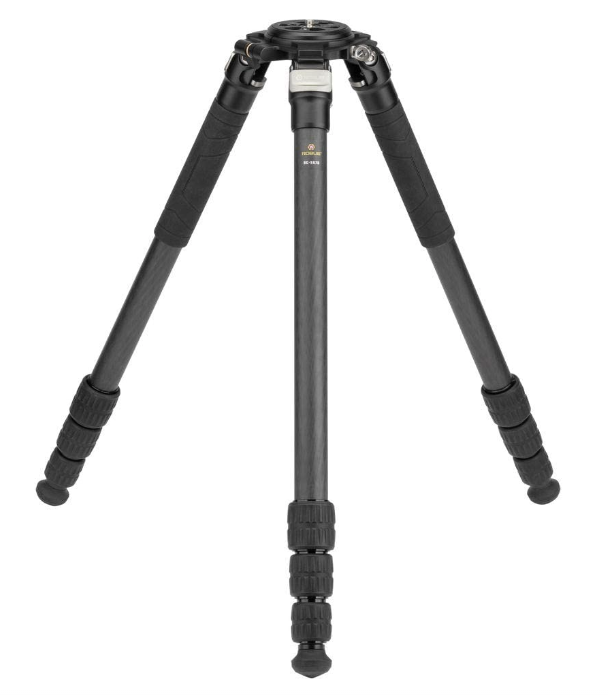
2. Robus RC-5570
The Robus RC-5570 Vantage Series 3 has the ideal balance of top-notch quality, flawless functionality, and pricing. We would say it’s the perfect Gitzo Series 5 alternative for photography enthusiasts.
Robus RC-5570 sells at less than half the price of the Gitzo Series 5 that we recommend as our best tripod for heavy lenses and DSLRs. But despite the lower price tag, this tripod still offers top of the line performance and durability.
Robus RC-5570 Vantage Series 3 Key Specs:
- Material: Aluminum Alloy, Carbon Fiber
- Load Capacity: 55 lb (24.95 kg)
- Weight: 5.6 lb (2.54 kg)
- Max. Height: 70.1″ (178.1 cm)
- Min. Height: 4″ (10.2 cm)
- Folded Length: 25.4″ (64.52 cm)
- Head Mount Thread Size: 3/8″-16 Male
The Robus RC-5570 features carbon fiber construction that delivers steady stability when working with heavy photo equipment in all kinds of weather. But at 5.6 pounds in weight, it’s relatively lightweight to carry around when traveling and shooting in the field.
The carbon fiber legs combine with the tripod’s anodized CNC-machined spider to provide rock-solid support of loads weighing up to 55 pounds. And it extended up to 70 inches high, for a seamless eye-level shooting experience for tall individuals.
RC-5570 is one of the four different versions of the Robus Vantage Series 3 heavy-duty tripods. The other versions include the smallest RC-5558 with up to 55 lb load capacity and extends up to 58” high and the biggest RC-8880 with up to 77 lb load capacity and extends up to 80” high.
There is also the RC-8860 that supports loads of up to 77 pounds and extends up to 63.8” high. All four versions have four leg sections and a minimum working height of 4” which is great for low-angle and macro photography.
The availability of this tripod in different variations is one of the reasons we recommend it as the best affordable Gitzo Series 5 alternative. And in our opinion, Robus RC-5570 has the best balance of load capacity, weight, and maximum height.
- Premium build-design that makes it the right tripod for professionals who want a more affordable Gitzo or RRS alternative.
- The 10x carbon fiber leg construction dampens vibrations even when working in very windy conditions.
- Includes a hook at the bottom where you can hook extra weight for enhanced stability
- High-quality twist locks that open with a quarter turn for a quick and very secure leg locking and unlocking operation.
- Comes with three different sets of feet, rubber, wide rubber, and spikes for optimum stability when working in different terrains.
- Two of the legs feature heavyweight rubber sleeves for a comfortable and secure grip in all types of weather.
- Interchangeable top plate and 75mm video bowl.
- Three variable leg angles of 25, 55, and 85 degrees with the ability to spread each leg independently when working in uneven terrains.
- A soft carrying case and shoulder straps included in the package.
- Folds down to 25.4” which is a little longer to fit in your carry-on.
The Robus RC-5570 stands out as the best tripod for hobbyist and enthusiast photographers. Pairing it with the Wimberley WH-200 Gimbal Head will give you the best sports, wildlife, and bird photography experience. When working with super-telephoto zoom lenses.
- Amazon: Robus RC-5570
- B&H Photo: Robus RC-5570
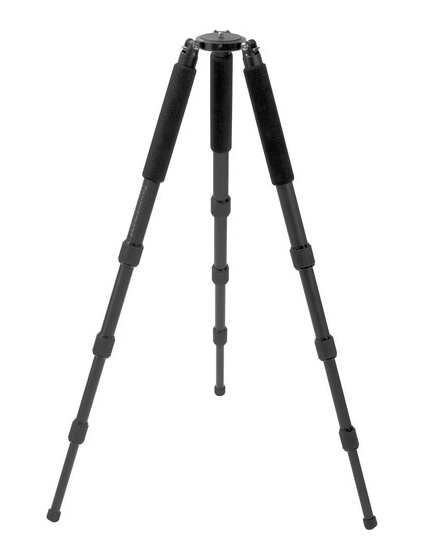
3 . FEISOL CT-3442 Tournament Rapid
The Feisol CT-3442 is the perfect definition of a super lightweight, heavy-duty tripod. It offers the optimum balance of quality, weight, folded length, load capacity, strength, and price. This is the tripod we recommend to travel bloggers and adventure photographers who shoot with heavy lenses and DSLRs.
Feisol CT-3442 Tournament Rapid Key Specs:
- Load Capacity: 55 lb (24.9 kg)
- Weight: 2.4 lb (1.1 kg)
- Max. Height: 54.3″ (137.9 cm)
- Min. Height: 7.9″ (19.6 cm)
- Folded Length: 18.9″ (48 cm)
- Bubble Level: No
The FEISOL CT-3442 Tournament Rapid tripod weighs just 2.4 pounds making it the most lightweight tripod on the list. It folds down to 18.9”, allowing it to perfectly fit in your carry-on or small backpack.
This tripod features premium carbon fiber leg construction that allows it to steadily support photo equipment loads of up to 55 pounds. And it will still maintain rock-solid steadiness when fully extended to 54.3” high.
We recommend pairing it with the affordable Sirui K-20x Ball Head that also supports 55 pounds load capacity and only weighs 0.9 pounds. It is extremely sturdy and features control knobs for pan, tilt, and tension, and two bubble levels.
- Super lightweight, compact, and very affordable for a heavy-duty tripod of its quality and performance.
- Easy to take apart and reassemble for maintenance and cleaning especially after working in the dirt.
- Uses secure twist locks for a quick operation when locking and unlocking the leg sections.
- Has 3 preset leg angles of 25, 50, and 75 degrees and goes down to just 7.9″ for low-angle photography.
- The package includes a tripod bag for storage and transportation.
- It only extends up to 54.3” high, tall individuals will be forced to stoop a little or adjust the camera screen to shoot at eye level.
The FEISOL CT-3442 Tournament Rapid carbon fiber tripod is affordable, lightweight, compact, solid, and stable. These five features make it a true companion for minimalist backpackers, hikers, bloggers, and travel photographers who shoot with heavy DSLRs and super-telephoto zoom lenses.
- Amazon: Feisol Tournament Rapid Tripod
- B&H Photo: Feisol Tournament Rapid Tripod
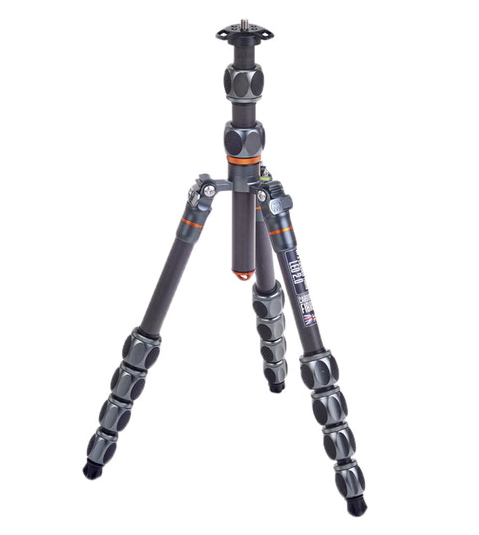
4. 3 Legged Thing Leo 2.0
At a folded length of 14.7”, the 3 Legged Thing Leo 2.0 is the most compact tripod on this list. It weighs just 3.4 pounds, making it super lightweight and easily portable for travel photography and blogging.
But despite its size, weight, and portability, this tripod will steadily support heavy lenses and DSLRs in all kinds of weather. We recommend it to minimalist backpackers and hikers who want an inexpensive, heavy-duty tripod.
3 Legged Thing Leo 2.0 Key Specs:
- Load Capacity: 66 lb (29.94 kg)
- Weight: 3.4 lb (1.54 kg)
- Max. Height: 40.6″ (103.12 cm) (54.3″/137.9 cm with Center Column)
- Min. Height: 4.9″ (12.4 cm)
- Folded Length: 14.7″ (37.34 cm)
- Leg Sections: 5
- Center Column: Yes (removable, reversible with two-column sections)
The 3 Legged Thing Leo 2.0 features a unique construction with a removable center column and three detachable legs. And like the premium tripods in this list, it is made of carbon fiber for optimal stability in all kinds of weather.
Each leg of this tripod can be configured as a monopod that extends up to 39.9″ high. Alternatively, you can combine one of the legs with the center column to make a 55.7″ monopod.
Leo 2.0 extends up to 40.6″ high while steadily supporting a maximum load capacity of 66 pounds. Keep in mind that you can extend the height to 54.3″ with the center column, but this may lead to a little vibration in windy environments.
- An inexpensive heavy-duty tripod that’s very lightweight and ultra-compact.
- A push-and-pull center column for rapid photography setup positioning.
- Twist-lock leg locking mechanism for quick and secure deployment.
- Can go down to just 4.9″ for low-angle and macro photography.
- The center column is reversible for ground-level photography.
- With the center column, it extends to 54.3″ high for seamless eye-level shooting.
- The rubber feet can be substituted with the optional 2 Legged thing spiked feet for enhanced stability on soft, uneven surfaces.
- The package includes a nice carrying bag for transport and storage convenience.
- The 5 leg sections make it less resistant to wind vibration.
The 3 Legged Thing Leo 2.0 is the ideal pro-level tripod for minimalist travel photographers, bloggers, and adventure enthusiasts. It comes at an inexpensive price but offers solid stability when working with heavy lenses and DSLRs.
This tripod makes the perfect affordable alternative to the Feisol CT-3442. We recommend pairing it with the AirHed Pro Lever Ball Head from 3 Legged Thing. The ball head supports loads of up to 88 pounds and is Arca-type compatible.
- Amazon: 3 Legged Thing Leo Tripod
- B&H Photo: 3 Legged Thing Leo Tripod
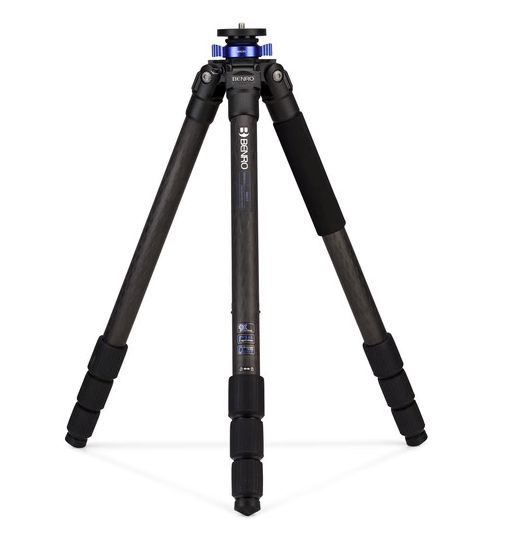
5. Benro Extra Long Series 4 Mach3
With the exemption of the Leo 2.0, all the other tripods in this list are mid-range or high-end priced. That makes sense since these are premium quality, heavy-duty tripods for powerful DSLRs and super-telephoto zoom lenses.
But this doesn’t mean you can’t find the best tripod for heavy lenses and DSLRs on a budget. The Benro TMA47AXL Extra Long Series 4 Mach3 is a wonderful choice for beginner and hobbyist photographers who are on a budget.
Benro Extra Long Series 4 Mach3 Key Specs:
- Material: Aluminum Alloy
- Load Capacity: 44.1 lb (20 kg)
- Weight: 6.8 lb (3.1 kg)
- Max. Height: 71.1″ (180.6 cm) (85.1″/216.2 cm with Center Column)
- Min. Height: 18.7″ (47.5 cm)
- Folded Length: 31.3″ (79.5 cm)
- Leg Sections: 3
- Center Column: Yes (Removable with one column sections)
Benro Extra Long Series 4 Mach3 supports loads of up to 44.1 pounds and weighs 6.8 pounds. Unlike the other tripods on the list, this one features aluminum construction.
What we really like about this tripod is its maximum working height of 71.1″ that can go up to 85.1″ high with the center column. This height offers the best eye-level shooting experience for tall individuals.
But it has two main downsides, the minimum working height of 18.7″ and the folded length of 31.3″. This folded length gives it a disadvantage during low-angle photography.
We recommend pairing it with the Sirui K-10x Ball Head which also supports loads of up to 44 pounds. This ball is very affordable and features control knobs for pan, tilt, and tension, and two bubble levels.
- A well-built, affordable tripod that steadily supports demanding photo equipment.
- Its leg movement is smooth despite the bargain price.
- Twist lock system for quick and secure leg locking and unlocking.
- Retractable rubber feet that reveal spikes for working on soft, uneven surfaces.
- The 31.3” folded length makes it a bit bulky for travel photography.
- At 6.8 pounds, it is twice as heavy as the Leo 2.0 which falls within the same price range.
- The twist locks aren’t as premium as what you would get in the other tripods on the list.
Benro Extra Long Series 4 Mach3 is one of Benro’s most advanced tripods. It combines premium aluminum material with a classic design to deliver high performance and durability.
We recommend it to beginners and enthusiast photographers who are on a budget. If you don’t mind the extra weight and bulk, then you will get the same stability and sturdiness as what the mid-range tripods in this list offer.
- Amazon: Benro Series 4 Mach3 Tripod
- B&H Photo: Benro Series 4 Mach3 Tripod
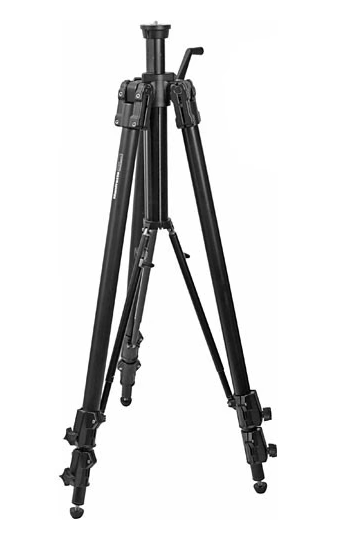
6. Manfrotto Super Professional Mk2
Manfrotto designed the 161MK2B Super Professional Tripod Mk2 for home and studio use. That explains its 17.5 pounds weight which makes it very heavy for travel photography.
But if you travel around with a truck, this might just be the perfect heavy-duty tripod for astrophotography and architecture photography, especially when shooting from the vehicle.
Manfrotto Super Professional Tripod Mk2 Key Specs:
- Weight: 17.5 lb (7.9 kg)
- Max. Height: 95.3″ (242.1 cm) (105.1″/267 cm with Center Column)
- Min. Height: 17.3″ (43.9 cm)
- Folded Length: 41.3″ (104.9 cm)
- Independent Leg Spread: No
- Center Column: Yes (with one column sections)
Manfrotto Super Professional Mk2 towers 95.3″ high when fully extended and up to 105.1″ with the center column. It supports loads of up to 44.1 pounds and will remain rock-steady regardless of the bulkiness of your photo equipment.
At 41.3” folded length and 17.5 pounds weight, it is very heavy and bulky for travel photography. But this tripod wasn’t meant for travel! Manfrotto designed it with studio and home photography and videography in mind.
Yet, some enthusiasts and professional architectural and astrophotographers find it extremely reliable for their work. It makes the perfect monster tripod that towers very high while steadily supporting serious equipment.
- Superior build quality that keeps it free from vibrations even when the center column is fully extended.
- One of the tallest and most stable tripods for studio and home use.
- Stands steady even when supporting bulky DSLRs and demanding lenses.
- Geared center column for easy and accurate adjustment.
- Includes three set screws in the camera platform that allows you to permanently secure the head to the tripod for enhanced security.
- It’s very heavy and bulky for traveling.
The Manfrotto Super Professional Mk2 is one of the best studio tripods for heavy lenses and DSLRs in the market today. It will support your heaviest studio photo equipment without even the slightest of vibrations. But it can also make the perfect companion for astrophotographers who use heavy astronomy equipment.
- Amazon: Manfrotto Super Professional MK2 Tripod
- B&H Photo: Manfrotto Super Professional MK2 Tripod
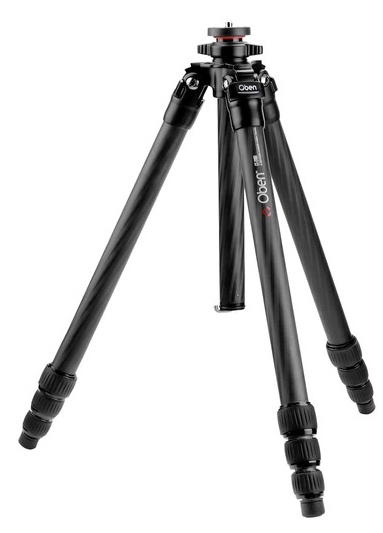
7. Oben CT-2491 Carbon Fiber
The Oben CT-2491 tripod with GH-30 gimbal head is a wonderful tripod and gimbal head pairing that we would recommend to beginners and hobbyist sports, wildlife, and bird photographers.
Oben CT-2491 Key Specs:
- Load Capacity: 39.6 lb (18 kg)
- Weight: 3.5 lb (1.6 kg)
- Max. Height: 62.5″ (158.8 cm) (72.5″/184.2 cm with Center Column)
- Min. Height: 6″ (15.2 cm)
- Folded Length: 23.3″ (59.2 cm)
- Head Mount Thread Size: 1/4″-20 Screw, 3/8″-16 Screw
- Center Column: Yes (split two-column sections)
Like all the other heavy-duty tripods on the list, Oben CT-2491 Carbon Fiber features a premium quality carbon fiber construction. And when paired with the GH-30 Gimbal Head it makes the perfect sports and wildlife photography tripod.
This pairing is extremely sturdy and remains stable even when shooting in windy environments. With a load capacity of 39.6 pounds, the combination will support your heaviest DSLRs and super-telephoto zoom lenses.
Oben CT-2491 provides a working height range of 6” to 62.5”, and 72.5” with the center column. At 6” you can shoot high-quality macro and low-angle photos, and with the extended height tall individuals will enjoy eye-level shooting without stooping or adjusting the camera screen angle.
The tripod weighs 3.5 pounds and the head 3.2 pounds. The combination is still lightweight to carry around especially if you travel or hike a lot during your photography.
- A beautiful, affordable pairing that’s very easy to set up,
- Super lightweight, and compact to travel with.
- Despite its affordable pricing, the tripod seems pretty sturdy and stable even when the height is fully extended.
- The extended tripod length is big enough for tall individuals to comfortably shoot at eye level through the viewfinder while standing.
- Rubberized feet that retract to reveal spikes for extra stability when working on soft, uneven terrain like ice, snow, and sand.
- The GH-30 Gimbal Head provides smooth, fluid movement when tracking and photographing wildlife, birds, and sporting events.
- Arca-type compatible plate with two 1/4″-20 threaded mounts, and also supplied with two 3/8″-16 bushings.
- The head supports loads of up to 44 pounds, making it ideal for long, bulky telephoto lenses like 150-600mm and 200-500mm.
- The twist locks are a bit stiffer and take a bit more force to tighten or loosen.
- The center column doesn’t lock down fully.
The Oben CT-2491 Carbon Fiber with GH-30 Gimbal Head is ideal for you if you want a complete tripod kit that extends tall but folds compact and lightweight at a budget. The pair would perfectly suit beginner to enthusiast-level sports, wildlife, and bird photographers.
- Amazon: Oben CT-2491 Carbon Fiber
- B&H Photo: Oben CT-2491 Carbon Fiber
HOW TO CHOOSE THE BEST TRIPOD FOR HEAVY LENSES AND DSLRS
The fact that you are here tells you may already know why tripods can benefit your photography. Tripods provide a stable camera and lens support. And with enhanced stability, comes endless photographing possibilities.
You can easily capture long exposures, shoot in low-light, take panning shots, or document surreal panoramas. Regardless of your type of photography, you’ll be stunned by how a tripod can make a difference!
When working with heavy lenses and DSLRs, you will need to find a heavy-duty tripod to support the extra weight and bulk. Keep in mind that such a robust tripod doesn’t need to be heavy or bulky.
In this section of the guide, we will take you through the process of choosing the best tripod for heavy lenses and DSLRs.
Load Capacity
The first step to finding your ideal heavy-duty tripod is determining the amount of load that you’ll be putting on the tripod. That includes your camera, lenses, and any other accessory that hooks on your camera setup when shooting.
In most cases, you’ll be dealing with heavier and bulky DSLRs and telephoto lenses that weigh as much as 5 pounds each. That’s especially if you’re into wildlife, wedding, professional portrait, or sports photography.
Your ideal tripod should comfortably support at least 1.5 times the total weight of your heaviest lens and camera. While most of the high-quality tripods in the market will safely hold standard DSLRs, only a few can accommodate long telephoto lenses.
If you’re going to work with greater load capacity, consider getting a premium tripod. One that has been designed with high-quality material to work in the most demanding environments like the wild.
You don’t want to shoot from a tripod shaking under the weight of your camera setup. Actually, this contradicts the initial point of getting a tripod. It not only negatively affects the quality of your shots but also risks crashing the entire setup.
Material and Durability
The performance of a tripod is hugely determined by the material that is made of. In fact, it also in some ways determines its maximum load capacity. The two main materials used in the construction of tripods are aluminum and carbon fiber.
Aluminum Tripods
Aluminum is a tough, lightweight metal. Making it the widely used material in the construction of most travel tools. Well, including aircraft! It’s also inexpensive something that allows for designing and pricing the end product affordably.
In the construction of tripods, aluminum is used to make the heavy-duty models as it adds a lot of weight to offer more load-bearing support. Its main drawbacks include getting hot in hot weather and cold in cold weather.
Carbon Fiber
Carbon fiber is extremely lightweight, durable, and flexible, making it the most preferred material for top-quality tripods. And it is essentially weather resistant. It won’t get cold in the freezing winter nor hot under the scorching summer.
Yet, while aluminum is affordable, carbon fiber will cost you more. But with it, you will enjoy a virtually indestructible sturdy tripod that is super lightweight to easily carry along with your heavy photography lenses and DSLRs.
NOTE: There are many tripods out there made of wood and plastic. Wood is mostly used by nature photographers who don’t mind carrying bulky loads with them. Plastic tripods, on the other hand, are inexpensive and terrible in outdoor environments as they can get easily warped and damaged.
Size and Weight
Notwithstanding your type of photography, you most likely want to invest in a lightweight and easily portable camera equipment. That’s especially if you’re an on-the-go photographer looking to fit all your gear in a backpack.
As such, you should consider investing in a reliable lightweight tripod that affords to bear high load capacity while maintaining stability. Such a tripod should also be durable enough to last you through your most extreme photography adventures.
TIP: Some tripods will come hooks that give you the option to add extra weight to maintain steadiness by preventing vibrations. Keep in mind that heavier tripods are usually more stable!
Apart from weight, you should also consider the size of your ideal tripod. If it doesn’t fit in your carry-on bag or backpack, how will you bring it to the scene of photography? Ensure it can fold into a length that perfectly fits in your bag.
A small, lightweight collapsed tripod is especially useful for adventure photographers who are going to trek for long distances. And even if you’re going to travel by bus, vehicle, or air, you don’t want more weight and bulk in your luggage.
Working Height
Apart from the foldable height, tripods usually have minimum and maximum working heights. Maximum working height is how tall the tripod will stand when all the legs and center column are fully extended.
We always recommend buying a tripod that can extend as tall as your height, to avoid bending when looking into the viewfinder. Keep in mind that tripods with maximum heights higher than your height are still okay since you can always adjust the legs to match your needs.
However, a shorter tripod will give you a poor photography experience. If the tripod height is much below your eye level, you will be forced to bend all the time. This can be exhausting especially if you are waiting for some kind of action that requires you to look through the viewfinder all the time.
Minimum working height is important if you’re looking to do some ground-level shooting. Some tripods allow you to get very low on the ground by extending the leg angles out so wide that the center of the tripod gets to as low as a few inches above the ground.
Some models allow you to remove the center column and then reinsert it upside down so you can lower the camera to the ground level. These tripod models are especially useful when you’re looking to shoot different angles of certain scenes.
Center Column
Some tripods come with a center column. That’s a single leg in the middle of the tripod that lets you decrease or increase the height of the camera by simply moving it downwards or upwards.
NOTE: Extending the height of the center column upwards creates some wobbling. Actually, most of the seasoned photographers widely assert that tripods with center columns don’t deliver sharper results, even when it’s not extended at all.
Some photographers find the center column a good feature that’s quite convenient. Yet, we strongly advise against buying a heavy-duty tripod that features the center column unless you really need to have it.
TIP: If for whatever reasons you can’t do without the center column, ensure that it can fully retract to the same level where the legs of the tripod meet. At this point, there should be no wobbling, especially if it’s a sturdily designed tripod.
The negative effects of a center column may go unnoticed when using wide-angle lenses. But if you’ll be working with long telephoto lenses, it causes too much vibration that severely affects the sharpness of your photos.
Legs and Feet
Just like humans, tripods have legs and feet. Tripod legs typically come in two forms, tubular and non-tubular. While all carbon fiber legs are tubular, aluminum legs will come in different shapes.
Tripod feet will either be metal spikes (for outdoor) or rubber (for indoor use). Most premium tripods will allow you to alternate the feet depending on your working conditions by just screwing back the rubber tip to reveal a spike.
TIP: Not unless you are planning to work in uneven or slippery (rainy or icy) conditions, the standard rubberized tripod feet should work just fine.
Leg Sections, Angle, and Locks
Tripods legs may have 3 to 5 leg sections. The larger the number of leg sections, the shorter the tripod folds up. That’s, tripods with more leg sections will fold up to a short length that is more portable.
TIP: More leg sections also means that you will take quite long to set up the tripod, especially when dealing with flip locks. And for the budget models, many leg sections can render them unstable when fully expanded.
Tripod leg locks come as either flip locks and twist locks. All carbon fiber legs have a threaded twist-lock system. They are quicker to use and take up less space. You can easily operate them by a single movement when setting up the tripod.
Aluminum legs come with flip locks that are a little slower to operate since they are operated individually. But keep in mind that aluminum tripods are not only more affordable but also quite heavier and hence more stable!
Most tripods feature legs that can be angled independently, which is very useful when working in cramped areas or sloping sites. For regular use, the standard leg angles will often work just fine.
TIP: Spreading one or more legs further apart will often enhance its stability while allowing you to work on a much lower angle.
A tripod head is arguably the most important part of the tripod. It’s responsible for holding the camera system securely and controlling its movements. Some tripods come with the head included, but others require you to purchase it separately.
When choosing your ideal tripod head, ensure that it can support at least the same load capacity that your tripod legs can. The most common tripod heads are ball heads and pan-and-tilt (also known as three-way) heads.
Ball heads are compact in size, easy to use, and quick to operate making them ideal for beginners. But they are also less precise especially when you’re looking to adjust a large camera with a heavier lens in small, slow movements.
Three-way heads are more accurate and feel quite solid when you are looking to adjust your camera in tiny, controlled movements. They can also be adjusted on each axis independently. But unlike ball heads, they are quite bulkier and larger.
NOTE: Depending on how you are looking to do your photography, you can always change one head for another. Keep in mind that there are other specialized heads like gimbal heads. They are useful when shooting with heavy, long telephoto lenses that would otherwise unbalance the tripod.
Which one should you buy? Well, for the simple answer, if you are looking for speed and/or a compact design for portability, buy a ball head. But if you need precision and you don’t mind an extra bulk in your gear, buy a three-way head.
A ball head will suit fast-action photography like wildlife and sports where you need to keep moving your camera quite a lot and quickly. While a three-way head will work perfectly in landscape and panoramic photography since the “land” doesn’t move and precision is very important.
Quick-Release System
Every modern camera and long telephoto lens is designed with a thread at the bottom that allows you to attach it to a monopod or tripod. The threaded system requires you to either rotate the tripod or the camera (or lens) when attaching them together.
This process can be very inconvenient, especially when you want to get them attached quickly. To make it more convenient and easier, manufacturers came up with a simple but extremely useful solution called the quick-release system.
The system works by attaching a small, removable plate on the lens or camera, and then securing it tightly on the tripod head. Budget tripods come with cheap plastic plates that will do more harm than good when working with expensive cameras and lenses.
Premium tripod heads will come with more durable plates that are more sturdy. Today, the Arca-Swiss Quick Release System has become the standard quick-release system among most manufacturers.
Arca-Swiss Quick Release system has proven to be not only durable but also quick and easy to operate. It’s made of very strong aluminum and with a simple locking mechanism that offers for attaching the camera on the tripod head without rotating anything.
Monopod Functionality
Most tripods with a center column allow you to convert them into a monopod. This can be a useful option as it offers added flexibility when you are shooting with a heavy camera and lens while moving around.
Similar Posts

Gift Guide for Vloggers: Equipment Every Vlogger Needs

List of Best Amazon Deals

12 Best Vlogging Cameras: Mirrorless, DSLR, and Action Cameras

10 Best Budget Vlogging Cameras

List of 10 Awesome Cameras for YouTube

Fun List of Gifts for Vloggers
Hello, thanks for the article, i have bought 3 Legged Thing Leo 2.0
Nice article!
This is very helpful. I’m currently looking for a new one since the one I’m using just broke after a couple of uses. I am excited to buy and try Manfrotto’s Befree Live Travel Tripod.
Stay safe and healthy!
Leave a Reply Cancel reply
Your email address will not be published. Required fields are marked *
The best travel tripod for 2024: finest lightweight tripods for your camera
The best travel tripods are super-portable camera supports

- Best overall
- Best for budget
- Best Premium
- Best Design
- Best Versatility
- Best Lightweight
How to choose the best travel tripod for you
How we test travel tripods.
1. The list in brief 2. Best overall 3. Best budget 4. Best premium 5. Best design 6. Best for versatility 7. Best lightweight 8. How to choose 9. How we test
Compact size and lightweight build are the name of the best travel tripod game, persuading you to pack one for outdoor adventures rather than leave it at home or in the studio, unlike the best tripods which can be very heavy and unwieldy.
In 2024, there's the question of whether you need a tripod in the first place. After all, today's best cameras give plenty of reasons to leave the tripod at home , such as excellent high ISO performance and in-body image stablization. But believe us, there's still plenty of reason to fork out for a decent tripod .
All of the models in this guide stand firm for long exposure photography, sharp photos and hands-free video while being small enough to be stowed in your camera bag . Most options included here are available in aluminium and pricier carbon fiber versions. Because travel tripods are quite small already, the minimal weight saved by using carbon fiber might not be worth the extra outlay of their aluminium counterparts.
We've tested more than our share of tripods over the years, utilizing them while we're testing cameras and lenses – so we know if one offers incredibly stable shooting and decent value for money. Within this guide, we have gathered the best travel tripod you can buy right now and included further buying advice at the end of the guide.

Tim is TechRadar's Cameras editor, with over 15 years in the photo video industry and most of those in the world of tech journalism, Tim has developed a deeply technical knowledge and practical experience with all things camera related. He’s also worked in video production with clients including Canon, and volunteers his spare time to consult a non-profit, diverse stories team based in Nairobi.
The quick list
Short on time? Use our quick round-up below to find the best travel tripod for you. Use the links to jump to our full write-ups for more in-depth coverage.

The best travel tripod overall
The 3-Legged Thing Punks Brian 2.0 boasts a full height of 73.2 inches / 1.86m and a stylish design. A truly impressive specification for the price.
Read more below
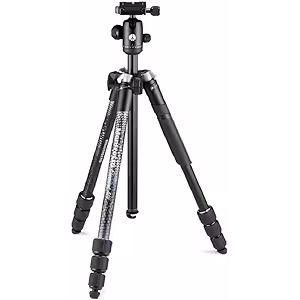
The best travel tripod for a budget
If you're looking for your first ever tripod, Manfrotto's budget friendly offering ticks all the boxes when it comes to delivering the basics at a good price.
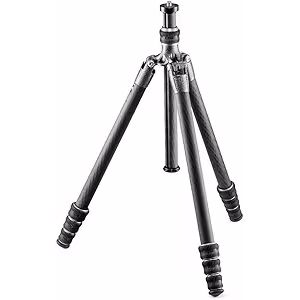
The best premium travel tripod
Smooth operation and build quality that will last a lifetime make this the best option for those who are happy to pay for the best.
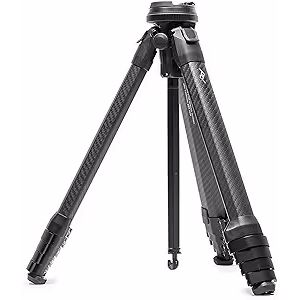
The best travel tripod design
As one of the most compact travel tripods around, the Peak Design makes for a great travel companion, albeit at quite a high cost.
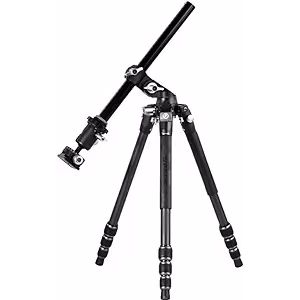
The best travel tripod for versatility
With an articulating center column, this heavy travel tripod is able to capture unique angles while providing great stability.

The best lightweight travel tripod
A basic offering from Manfrotto that is incredibly lightweight and therefore perfect for taking on your travels.
- ^ Back to the top
The best Travel Tripods in 2024
Why you can trust TechRadar We spend hours testing every product or service we review, so you can be sure you’re buying the best. Find out more about how we test.
Below, you'll find full write-ups for each of the best travel tripods in our list and a link to a full review. We've tested each one extensively, so you can be sure that our recommendations can be trusted.

1. 3 Legged Thing Punks Brian 2.0
Our expert review:
Specifications
Reasons to buy, reasons to avoid.
When it comes to price and quality, the 3-Legged Thing Punks Brian 2.0 is hard to beat. For the price, you get an incredible level of versatility with the Brian 2.0, which can transform into a standard tripod, a tall monopod, or even a tabletop tripod when combined with the separately sold Vanz footwear.
The carbon fiber frame is lightweight at 3.70lbs / 1.68kg and provides a maximum height of 73.2 inches / 1.86m. This might be too tall for some, but it's always good to have the option – you don't need to use all the leg sections. Folding away to 16.5-inches / 42cm makes it easy to attach to a bag or throw in a suitcase.
As is custom in the Punks Brian 2.0 range, the tripod is available in either orange, blue, or black, depending on how much you want to stand out.
- Read our 3 Legged Thing Punks Brian 2.0 review

2. Manfrotto Element MII
The Manfrotto Element MII is a fantastic budget option that does all the basics really well. At only $155 / £109 / AU$259 you're guaranteed to get everything that Manfrotto is known for, including great build quality and a well engineered head.
The Element MII has replaced the Element Big, a change that sees a reduction in leg sections from five to four. These changes make it easier to set up and pack down. Unfortunately, it's only available in aluminum, which makes for a heavy package considering it's such a compact design.
By offering a fairly basic specification, Manfrotto is delivering simple tripod technology at a great price. Through the Element range of tripods, Manfrotto is trying to appeal to beginners and those on a budget.
- Read our Manfrotto Element MII Aluminium review

3. Gitzo Traveler Series 1
Professional users looking for one of the best travel tripods should look no further than the Gitzo tripod Traveler series 1. All the boxes are ticked with a lightweight and excellent build, with an impressive extended height.
Oftentimes, with travel tripods, the parts don't function as smoothly as their larger counterparts. This is not the case for the Gitzo Traveler Series 1. Moving from folded to extended is a breeze, and the head is as strong and reliable as you'll ever need it to be. The ball head features separate pan locking, and its 32mm ball diameter is just about large enough to support a full-frame DSLR.
All of this premium quality comes at a price. The Traveler Series 1 costs $680 / £539 / AU$1,154 . 95. If you're in the market for a travel tripod that will last a lifetime and you're prepared to pay for it, then the Traveler Series 1 is a great choice.
- Read our Gitzo tripod Traveler series 1 review
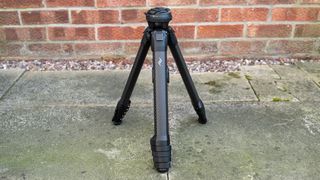
4. Peak Design Travel Tripod
The Peak Design oozes a unique design that results in it being one of the most compact and lightweight options on the market. Thanks to the shape, the legs fold neatly into each other, which provides a super slim overall diameter.
The head is integral to the tripod, which takes a little bit of getting used to, and it lacks functionality. However, ultra-low-level and tabletop shooting is possible thanks to the centre column design, so although it isn't in the 'best for versatility' category, it would easily be competing for the top overall spot.
With great design comes a high price, especially if you opt for the lighter carbon fiber frame rather than the aluminium alternative. The 5 sectioned legs are strong, delivering all the stability you could need as you're out and about.
- Read our Peak Design Travel Tripod review
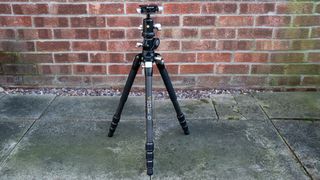
5. Vanguard VEO 3T+ 234CB
The Vanguard VEO 3T+ 234CB is heavier and bigger than most of its competitors, something that will put a lot of people off, especially if they're doing a lot of travelling by foot. But with this weight and size comes a high level of stability that is ideal if you're shooting long exposures or time lapses.
One of the main things we love about this travel tripod is the articulating arm , which makes it possible to shoot at ground level. This is great for capturing unique and creative camera angles that would otherwise be impossible without defaulting to handheld.
Thanks to the ability to unscrew one of the legs, this travel tripod is also a very capable monopod, making it a highly versatile offering.
- Read our Vanguard VEO 3T+ 234CB travel tripod review

6. Manfrotto Befree Advanced Carbon Fiber
At 1.25kg, this carbon fiber travel tripod is as lightweight as it gets, perfect for taking with you on your travels. It can also fit into small spaces, with a foldable length of just 41cm. If you're after a tripod that blends into the background and doesn't bother you on long journeys, then Manfrotto Befree Advanced will be great.
The lack of weight and size usually results in poor stability, something that isn't the case with this tripod. The legs are rigid and robust, which is not always guaranteed on a travel tripod.
There is no getting around it; this is a basic tripod with limited features. With no monopog leg option and a limited maximum height, it might be worth going for the slightly heavier 3 Legged Thing Brian 2.0 Travel Tripod. But if all simply need a basic support, which is true for most photographers moist the time, then this is a great option.
- Read our Manfrotto Befree Advanced Carbon Fiber Travel Tripod review

What to look for in a travel tripod
Choosing the best travel tripod isn't just about selecting the smallest and lightest model. Indeed, picking the lightest legs isn't always the best plan. Marginally heavier alternatives won't be a noticeable burden, but they can provide much more rigidity and versatility.
Most of these tripods use a carbon fiber construction to save weight, but this ups the price. Some models also have aluminum counterparts. Each includes a compact ball head, but check carefully: a ball that's too small for a larger DSLR will become a precarious balancing act.
What makes a travel tripod
A neat trick shared by the vast majority of current tripods is that the legs swing fully upwards for stowage. The idea is that you first extend the centre column, then swing the legs up, so that the tripod’s feet end up encircling the head. This reduces the overall carrying length by up to 10cm or 4 inches. Indeed, many of the best travel tripods shrink down to about 30-40cm, making them small enough to fit inside a camera bag or rucksack, rather than needing to be tethered to the outside causing your bag to be unbalanced.
To give them a useful operating height, despite their small carrying size, most travel tripods feature four or even five telescopic sections per leg. Some go further still, with a two-section extending centre column. This naturally enables a greater maximum operating height, so you can be sure no matter how high your camera needs to be it will be able to get the shot you want.
The drawbacks are that each telescoping joint is an area of potential weakness, reducing rigidity, and the bottom leg sections are likely to be quite thin and spindly. A large number of twist or clip locks for all the sections also demands more time for setting up the tripod and folding it down again.
Do I even need a tripod?
Today's very best mirrorless cameras and computational photography modes especially in smartphones and the OM System OM-1 that go a long way to eliminating the need for a tripod. We list 5 reasons why photographers no longer need a tripod that includes super-effective in-body image stablization for handheld shooting even with professional high-resolution cameras, in-camera HDR modes so you no longer need to do multi-shot exposure stacking, plus improved image quality at high ISOs.
However, there are times and photography effects that still require a tripod. Tripods can be crucial for studio photography and for video work in general where you can lock off the camera in position for long periods and free up your hands. The same goes for long exposure photography, staging group photos, plus the times you need free hands to attach or remove accessories from your camera, like lens filters and mics.
Significant advances in camera tech have put the once necessary photography accessory under threat, but there will still be a place for tripods for a long time yet.
Tripods only have a fairly limited number of features. Despite that, we like to make sure we've tested every single part and compared them to others to see where each one stands apart from the rest.
We make sure to test our travel tripods over a period of time using a range of different cameras and lens combinations. Some tripods will be fine with specific cameras, but not others. By testing multiple types, we're able to see how ubiquitous each one is.
The process of folding and unfolding travel tripods is something that travellers have to do all the time. We therefore go through this process numerous times to see how each one feels and functions.
Some tripods have features that are truly unique, such as the articulating center column on the Vanguard VEO 3T+ 234CB. Whatever the feature, we put it through its paces to see if it puts it above its competitors.
We do all of this while travelling around and thinking like photographers on the go. This helps us to make comments that are helpful for making informed buying decisions.
Get daily insight, inspiration and deals in your inbox
Get the hottest deals available in your inbox plus news, reviews, opinion, analysis and more from the TechRadar team.

Tim is the Cameras editor at TechRadar. He has enjoyed more than 15 years in the photo video industry with most of those in the world of tech journalism. During his time as Deputy Technical Editor with Amateur Photographer, as a freelancer and consequently editor at Tech Radar, Tim has developed a deeply technical knowledge and practical experience with cameras, educating others through news, reviews and features. He’s also worked in video production for Studio 44 with clients including Canon, and volunteers his spare time to consult a non-profit, diverse stories team based in Nairobi. Tim is curious, a keen creative, avid footballer and runner, and moderate flat white drinker who has lived in Kenya and believes we have much to enjoy and learn from each other.
- Mark Wilson Senior news editor
- Paul Hatton Freelance writer
Manfrotto Element MII Aluminium review: superb value
Gomatic McKinnon Camera Pack 35L review: one for the road
The Nintendo Switch 2 should bring back one of the 3DS's best features
Most Popular
By Barclay Ballard February 28, 2024
By Barclay Ballard February 27, 2024
By Krishi Chowdhary February 26, 2024
By Barclay Ballard February 26, 2024
By Barclay Ballard February 24, 2024
By Barclay Ballard February 23, 2024
By Barclay Ballard February 22, 2024
By Barclay Ballard February 21, 2024
- 2 TCL's new mini-LED TV is a gamer's dream, with 144Hz gaming, Dolby Atmos and 3,500 nits of brightness
- 3 The Dragon's Dogma 2 community has united under the banner of rotten food to combat the spread of Dragonsplague
- 4 IKEA's affordable new smart LED wall panel is an impressively versatile mood light
- 5 New iPad Air and iPad Pros look set to launch very soon – here’s why
- 2 Buying a new TV in 2024? Make it a Sony
- 3 Gear up for the AI gaming revolution with AORUS 16X and GIGABYTE G6X
- 4 Programmers got PSP games running on the PlayStation Portal, then “responsibly reported” the exploit so it could be patched
- 5 Apple TV Plus just added 30 more classic movies to its library – here are 7 to stream first
- Student Successes
- My Learning
Our Birthday Sale is ON! Click Here to Save 70%+ Off
9 Best Travel Tripods in 2024 (Updated)
You can also select your interests for free access to our premium training:
Designing the best travel tripod involves compromises. A sturdy tripod tends to be big and heavy. But a travel tripod needs to be small and light. We’ve selected 9 tripods that are an excellent compromise between those competing demands.
You’ll find tripods that are heavier and sturdier. And you’ll find lighter, less robust travel tripods. Our top pick is the K&F Concept Lightweight Travel Tripod . It’s light, compact, and easy to carry. Yet it’s also strong and versatile. And the affordable price tag is the cherry on top.
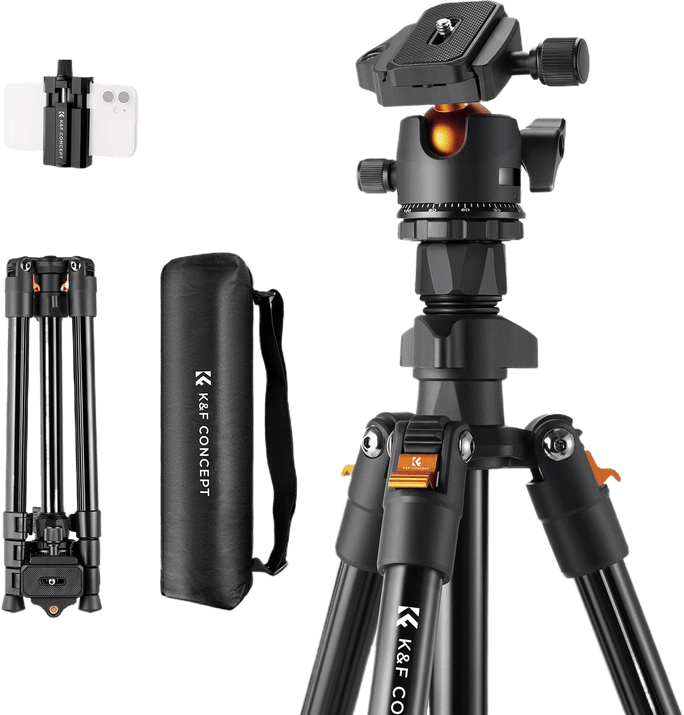
If you buy a product through one of our referral links we will earn a commission (without costing you anything). Prices last updated on .
As an Amazon Associate, I earn from qualifying purchases. Product prices and availability are accurate as of the date/time indicated and are subject to change. Any price and availability information displayed on Amazon at the time of purchase will apply to the purchase of this product.
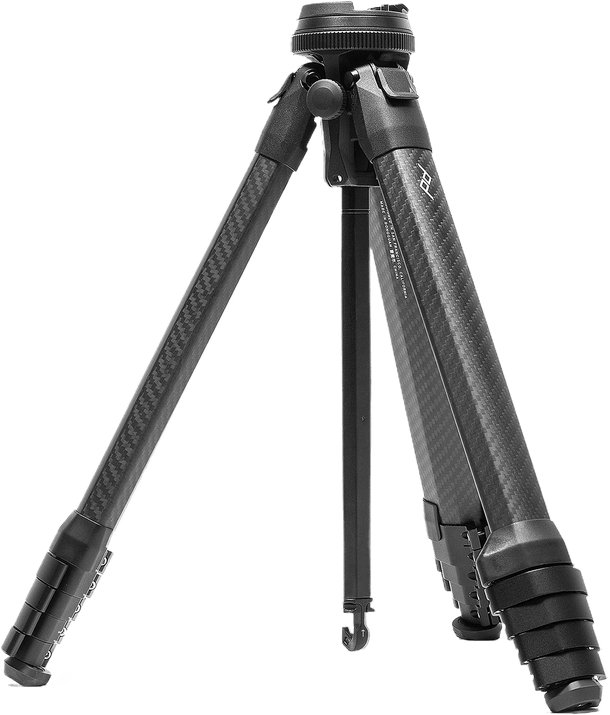
What is the Best Travel Tripod?
Before we look at our choices in detail, here is a summary of all our recommended travel tripods.
- Lightweight and versatile travel tripod with carry case
- Weighs only 2.4 lb / 1.1 kg
- Supports any weight up to 17.6 lb / 8 kg
- Excellent mounting flexibility with aluminum ball head
- Built-in bubble level for precision mounting
- Sturdy and lightweight carbon fiber construction
- Folds down to 38 cm and extends up to 1.5 m
- Supports up to 9.1 kg of gear
- 3-axis gimbal head for smooth panning and tilting
- Quick-release plate for easy mounting and dismounting
- Lightweight aluminum construction
- Compact and foldable for easy transport
- Can extend to a maximum height of 1.47 m
- Supports up to 4 kg of weight
- 360-degree ball head with two independent control knobs
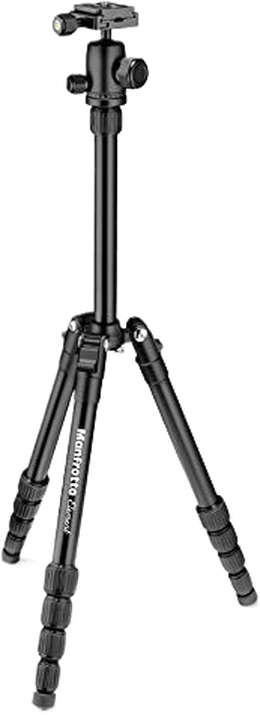
- Lightweight and compact for easy travel
- High-quality build, reliable stability
- 360-degree panoramic head for versatile shots
- Quick-release plate for fast setup
- Maximum height of 1.47 m for tall subjects

- Ultra lightweight yet strong carbon fiber
- 4-section legs adjustable to 25, 50, and 80 degreeangles
- Twist locks for fast, secure setup
- Removable center column
- Supports up to 15 kg of weight
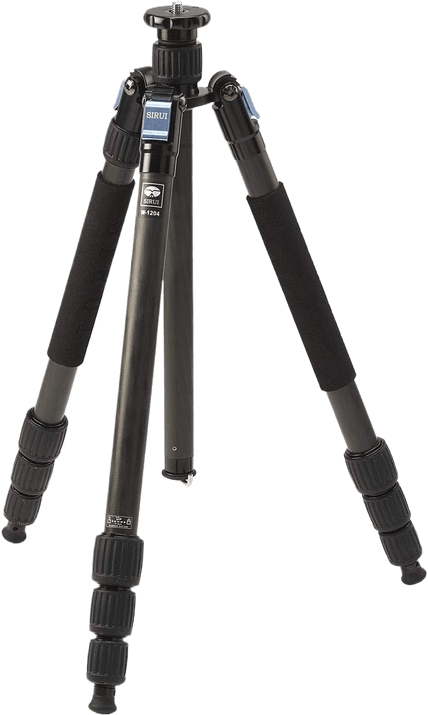
- Lightweight and compact design
- Smooth fluid video head
- Quick-release plate for fast transitions
- Fully adjustable tripod legs
- Includes carrying case and shoulder strap
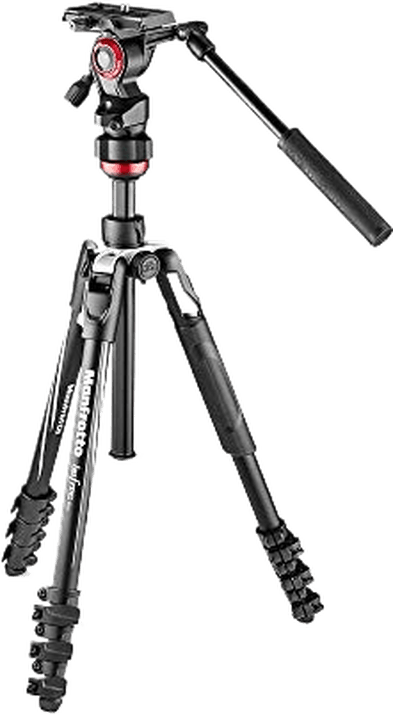
- Ultra-lightweight and sturdy carbon fiber construction
- Ball head design for easy, fast adjustments
- 4-section legs with quick-release leg locks
- Maximum height of 1.61 m
- Maximum load capacity of 10 kg
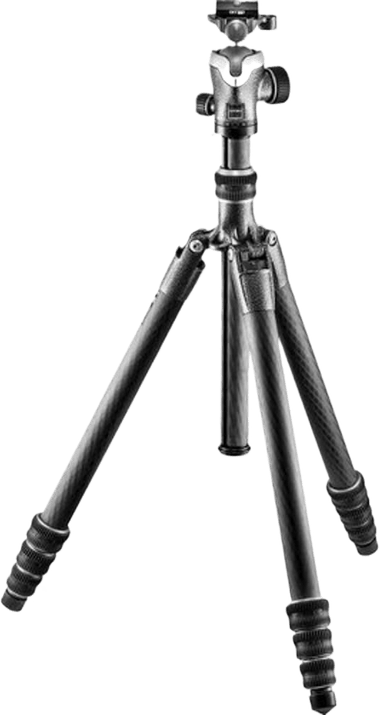
- Lightweight and portable
- Fully adjustable for desired angle
- Universal phone clip for mobile phones
- Durable and solid construction
- Non-slip rubber feet for stability
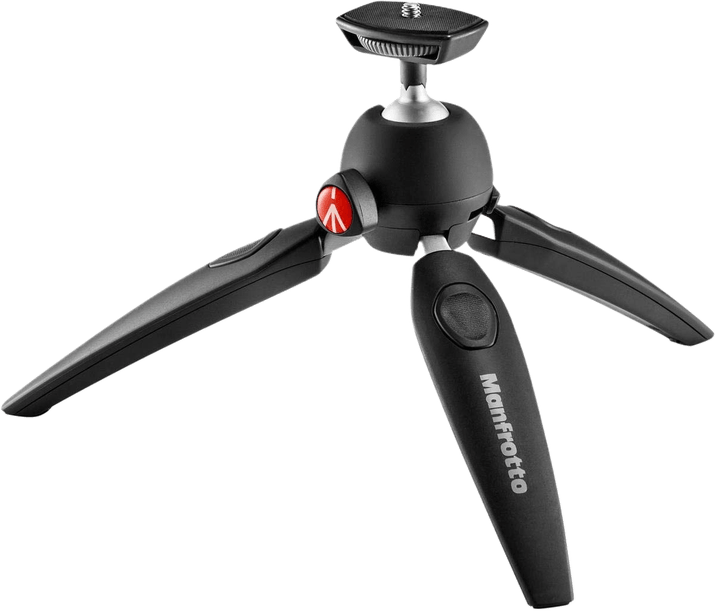
- Lightweight and compact
- Stable and durable
- Quick-release leg locks
- Multi-angle center column
- Adjustable height range
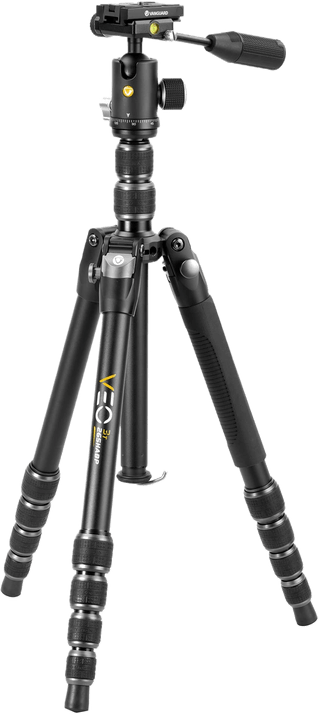
Now let’s look in more detail at our recommendations for the best travel tripod in 2023.
1. K&F Concept Lightweight Travel Tripod
The K&F Concept Lightweight Travel Tripod has to be our top recommendation. It’s a lightweight tripod that’s durable and reliable. You can take it with you on trip after trip and it will last the distance.
Weighing just 2.4 lb / 1.1 kg, it won’t add too much heft to your travel pack. And even though it’s a lightweight tripod, it can still support cameras weighing up to 17.6 lb / 8 kg. That’s enough for full frame cameras or even medium format cameras.
Travel photographers will also appreciate the wide working height range. You can set it up at any point between 64.1 inch / 1.6 m and 20.4 inch / 52 cm. And it folds down to 15.3 inch / 39 cm when you need to pack it away.
Flip locks make adjusting the height quick and easy. And you get a carry case included, making it even easier to travel with this tripod. And a quick-release plate helps you mount and dismount your camera.
It comes with a ball head as standard. The wide range of tilting motion gives you excellent mounting flexibility. And the head has a panning base, which is helpful when shooting landscapes or panoramas. It also has a built-in bubble level to help keep your camera level.
It’s hard to find fault with the K&F Concept Lightweight Travel Tripod . We’re confident about putting it in the No.1 spot on the list. And it’s an absolute bargain for the price.

2. Peak Design Travel Tripod
The revolutionary Travel Tripod is the newest addition to Peak Design ’s lineup. We know Peak Design from its camera bags , carrier straps, and belt holster systems.
Now, they’ve added a travel tripod that’s turning everyone’s heads. What makes it so unique? Quite a few things, actually.
First of all, it’s a real travel tripod. It folds down to under 15.5 inches. This is amazing because it extends to 60 inches when in use. That is more than enough for most travel photography .
There are also two options you can get this tripod in. The one listed above is carbon fiber, which weighs only 2.81 lbs. But they have an aluminum version that weighs 3.44 lbs.
The aluminum version is manageable and it weighs similar to other travel tripods. The carbon fiber version is stiffer and lighter but is more expensive.
As a travel tripod, it has a few advantages. It’s Arca-Swiss compatible. It has a single ring to adjust the head, which is also an intuitive and compact ball head. And it has four leg extenders. This offers you more versatility when choosing the height of the Peak Design Travel Tripod .
3. Benro TSL08AN00: Lightweight Aluminum Travel Tripod
The Benro Slim is a reliable option for photographers on a budget. It is the best affordable travel tripod that still comes from a reputable brand,
At 2.6 pounds, this tripod fits into the travel category. And a weight hook will help negate some of the negatives of using such a light tripod.
The tripod has four leg sections with twist locks. Each leg can be set to one of three angles for more height options. This allows the tripod to extend from 15.7 inches to about 57 inches. You can also reverse the center column for the most height flexibility.
The tripod also includes a ball head with a bubble level .
So what is the reason for the low price? The Benro Slim doesn’t fold down as small as the others on the list without reverse folding legs. This means a faster setup while taking up about four more inches of space in your bag.
The Benro Slim , like the BeFree, also has one of the lower capacities on the list with an 8.8-pound limit. And the under 3-pound weight could mean the tripod isn’t as sturdy as some of the pricier options.
4. Manfrotto Element Traveller Tripod Kit w/Ball Head
The Element Traveler from is made especially for travel photographers . Manfrotto is known for great tripods, and this is no exception. It’s a versatile tripod that allows you to move around without feeling weighed down.
Even though the tripod’s weight is barely 2.5 pounds, the load capacity is a lot higher. It will allow you to hold up to 8.8 pounds. That’s enough for a large professional DSLR and a super-telephoto lens .
The folded length of 13 inches is relatively small. You can shoot from a height of 14 inches up to 53 inches. This is excellent for landscape photography .
The other feature that photographers will enjoy with the Element Traveler is the aluminum ball head with an independent lock. This makes up-down shoots for food photography or product photography very simple.
5. Sirui W-1204 Carbon Fiber Tripod
The Sirui W-1204 is one of the few brands offering waterproof tripods. This makes it one of the best options for a hardcore outdoor photographer .
The tripod has a sealing system. If you shoot in the rain or place the legs in shallow water, the twist locks will still work.
The feet complete the outdoor design. You just unscrew the interchangeable feet to switch from rubber to spiked. The leg sections are held in place using twist locks to reach a maximum height of 65 inches.
This Sirui also has the highest weight capacity of any of the tripods on this list. It supports up to 33 pounds of gear while only weighing 3.1 pounds.
A counterweight hook adds even more stability to the tripod. The legs fold around the center column for a more compact folded measurement.
It stands at 19.3 inches when folded, with only four leg sections. With a height of only 5.7 inches and a removable leg that you can use as a monopod , the Sirui W-1204 gets points for versatility.
6. Manfrotto Befree: Professional Video Tripod for Travel
This Manfrotto Befree tripod is one of the few that use level locks instead of the twist type. Weighing a little over 3 pounds, this tripod folds down to a little over 16 inches.
You can adjust the legs on the Befree to three different angles. This allows the tripod to reach as low as 13.4 inches and as high as 56.7 inches.
The Befree’s compact design, versatile height, and flip locks make this one of the best tripods for travel photographers. And that’s all at a very reasonable price.
Like other 3-pound travel tripods, this tripod can be a bit susceptible to wind. Unfortunately, there is no counterweight hook to support it.
The capacity is 8.8 pounds, so it’s not designed for the biggest telephoto lenses . The 56.7-inch height limit will also be a sticking point for tall photographers.
But for the price, the Manfrotto Befree offers quality and portability.
7. Gitzo Carbon Fiber Tripod with Ball Head
This Gitzo tripod is the juggernaut of travel tripods. It will hold up to 22 pounds, making it one of the sturdiest tripods on our list.
This allows you to use heavy camera equipment . That’s perfect for destination weddings or sports photography . The extra weight-bearing design will help with added accessories like microphones , lights, or flash units .
It comes with a high-quality ball head. As far as tripods go, this one is lightweight, weighing only 3.2 pounds. The most significant benefit I found is the small center column. This lets you get close to the ground for low-angle shots.
For these reasons, this Gitzo is expensive compared to the others on our list. But it’s worth the money. It has a simple design and construction that makes it easy to extend and shrink.
8. Manfrotto PIXI Evo
The Manfrotto PIXI Evo is unique in this selection of tripods. We all know Manfrotto for making excellent tripods. Whether large and sturdy or small and portable, it’s the go-to company. Their other best travel tripod options on our list are for photographers shooting up high.
Eye-level vantage points aren’t the only way photographers want to capture scenes. Sometimes they want to get low for a different perspective. The Manfrotto PIXI Evo offers just that.
This tabletop tripod is small. And it will fit in the small accessory pouches of your backpack or your coat pocket.
You might not expect it to handle DSLR camera systems . But it will hold a weight of 5.5 pounds. This is more than enough to support a full frame DSLR body with a telephoto lens.
Using it couldn’t be easier. Flip out the legs and you’re good to go. The PIXI Evo doesn’t offer you much versatility. But it is the most compact and lightest of our travel tripod picks.
It’s perfect for selfies and vlogging , as it offers two different leg angles along with adjustable two-section legs.
9. Vanguard VEO3T265HABP Aluminum Travel Tripod
The Vanguard VEO ’s reversing center column allows you to shoot as low as 16 inches from the ground or as tall as 57 inches. This is perfect if you need to get down low for macro shots ? You can also adjust each of the twist-lock legs at three different angles.
Despite the versatility, this Vanguard tripod weighs only 4 pounds. It can handle three times its own weight with a 13.2-pound capacity. When folded, the tripod fits in a space of less than 16 inches.
A counterweight hook helps add more stability to the lightweight tripod. With a tripod ball head included, the camera’s position is easy to adjust.
The VEO is designed for quick setup with the central column system. The four legs are also easy to adjust because of twist-lock legs.
There are some downsides, though. It doesn’t include spiked feet, which you can get for a higher price. It also doesn’t have the versatility of using one leg as a monopod. But for the price, the Vanguard VEO ‘s feature list is rather tough to beat.
Buyer’s Guide for the Best Travel Tripods
Tripods can have a varying list of features. And some features are more important when you want to travel with your tripod. Read on to learn what makes a tripod perfect for travel.
What to Look for When Buying the Best Travel Tripod
Tripods are necessary for low-light and long-exposure shots . This is why a travel photographer must carry them around. But there’s a problem with lightweight tripods. The lighter a tripod is, the less stable it tends to be.
That doesn’t mean your travel tripod is going to dump your camera in the dirt. But there are a few features that you should look for when choosing the best travel tripod for you.
A Travel Tripod with Counterweight Hooks
Adding a simple hook to the bottom of the tripod’s center column may not seem like a big deal. But this tiny feature allows travel tripods to be sturdier, no matter the travel conditions.
If you can add weight to the tripod, such as your camera bag , you add more stability without sacrificing portability. These counterweights will help your travel tripod stay put in windy conditions.
A Travel Tripod with Adjustable-Leg Flip Locks
You can adjust tripod legs through either twist locks or lever locks.
Twist locks are slimmer. But if you don’t twist them tight enough, they could unlock. Flip locks will add more bulk and tend to take longer to set up. On the other hand, you can trust them to stay locked.
After using a monopod with twist locks that kept sliding mid shoot, flip locks are my preference.
A Versatile Travel Tripod
Travel tripods are even more portable when they do double duty, so you don’t have to bring multiple ones with you.
If you want to use both a tripod and a monopod , look for a two-in-one that converts to a monopod.
If you shoot macro or low to the ground, check the tripod’s minimum and maximum height. And look one with a versatile height range. You’ll save yourself from bringing a tabletop tripod for low-angle photos.
A Portable Travel Tripod
Whenever you buy a tripod, pay attention to the weight specifications. This is especially true for travel tripods.
One is how much weight the travel tripod can hold. Ensure that your heaviest camera body, lens, and accessories fit within those parameters. The tripod with a higher weight capacity will be sturdier even if you only need half the listed weight limit.
The second detail to consider is the weight of the tripod itself. That’s how much you’ll be adding to your bag’s weight on a hike or in your luggage.
A carbon fiber tripod is lightweight and can hold a lot of gear. But it’s also more pricey than an aluminum one.
A Travel Tripod with a Sturdy Build
Plan on hiking with a tripod? Look for other outdoor-friendly features besides the lightweight feature.
Retractable feet spikes can help make the tripod a bit sturdier on grass and dirt.
Waterproof tripods are a bit harder to find. But they can survive taking pictures in the rain or standing in the surf .
A Travel Tripod with a Quick-Release Plate
Don’t miss capturing a moment because you have to fiddle with getting your camera off your tripod. Look for a travel tripod that includes a quick-release plate.
Also, watch for small design changes that help you set up your gear faster. Unfolding each of the three leg sections takes longer than just unfolding one center column, for example.
Conclusion: The Best Travel Tripod
The K&F Concept Lightweight Travel Tripod is our choice for the best travel Tripod. It is lightweight, durable, and has a wide range of features that make it the perfect travel companion.
It is also highly adjustable and has a unique design that allows for easy setup and breakdown. With its adjustable legs and quick-release plate, it is the perfect tripod for capturing any moment on the go.
The leading authority in photography and camera gear.
Become a better photographer.
12.9 Million
Annual Readers
Newsletter Subscribers
Featured Photographers
Photography Guides & Gear Reviews

Best Heavy Duty Tripod Stand for Heavy Camera & Lenses
Need to support a heavy camera + lens? To get the sharpest photo, you need to choose a heavy-duty tripod that can support the weight. Here are the best ones.
Camera Gear Guides | Tripod & Monopod Guides | By Greg Cromie
If you shoot landscape, sports, astrophotography, or wildlife photography, you definitely need a heavy-duty camera tripod.
A sturdy tripod can be the difference between a sharp image and a blurred one, particularly if your camera or lens is heavy.
Despite the emergence of lighter mirrorless cameras, long telephoto lenses are still heavy and require heavy-duty tripods with a larger maximum load capacity.
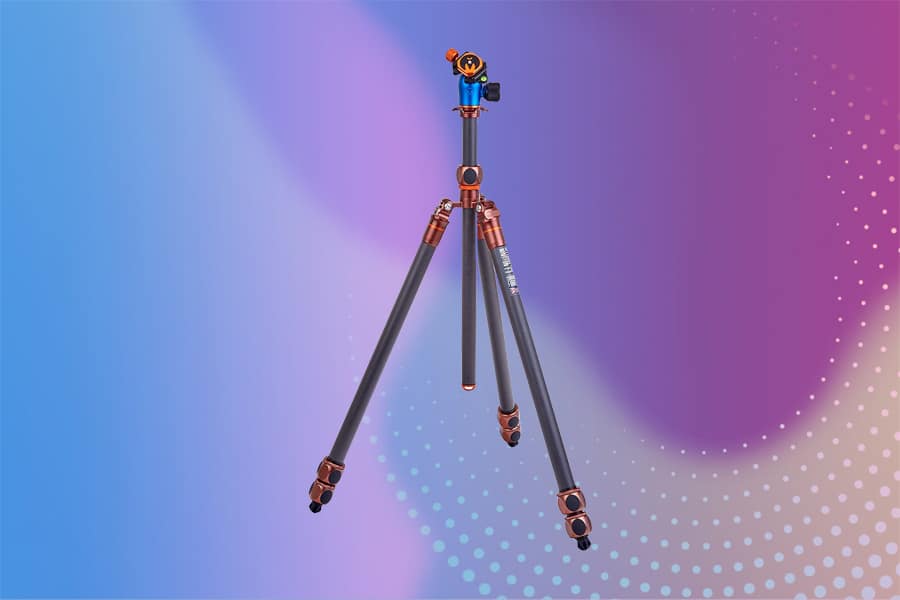
Super strong, stable and packed full of features. Great value for money with included ball head and monopod convertibility.
In this guide, you’ll discover various affordable aluminum and carbon fiber tripods that are strong enough to support heavy camera + lens setups.
Remember – with tripods, you get what you pay for – a heavy lens or camera usually means it’s expensive, so don’t skimp on tripod quality unless you want an expensive disaster!
Let’s take a look at the top recommendations.
Table of Contents
4 Best Value Heavy Duty Tripods in 2024
1. 3 legged thing winston 2.0 carbon fiber tripod with ball head.
See More Reviews
- Insane 88 lb(40kg) maximum load capacity
- Excellent stability
- Converts to a tabletop tripod
- Removable legs convert to monopod/boom
- Parallel locking
- Carrying case with shoulder strap
- No accessories thread on crown
- No safety mechanism for quick release
The 3 Legged Thing Winston 2.0 heavy duty camera tripod is one of the most stable heavy-duty tripods that’s also surprisingly lightweight and portable too.
It features a height range from a minimum of 5.7″ (146 mm) to a maximum height of 76.4″ (1.94 m). The max height is one of the tallest available from a full-sized tripod with a compact design.
It has a neat and compact folded length of 24″ (612mm) and weighs only 4.51lb(2.05 kg), making it super portable for photographers on the go. This is a decent weight for a tripod that can support super heavy lenses.
If you’re shooting long exposures with a large DSLR body and heavy lenses, the 3 Legged Thing Winston will handle evertthing with impressive stability.
It can support up to 88lb! (40kg) and hold as steady as you need, thanks to the parallel locking mechanism.
All three legs are removable and convert to a monopod or boom arm. 3 Legged Thing has a range of feet and metal spikes available to replace the legs and create a stable tabletop tripod system.
The center column is telescopic to provide optimal reach and height adjustment, although extending it fully will obviously bring some stability issues depending on the load and the surface on which it’s placed.
It’s hard to beat the Winston when looking for the best heavy-duty tripod – 3 Legged Thing really know what they’re doing when it comes to tripods. You should also check out the Charles 2.0.
- Best tripods for spotting scopes
2. Mactrem Heavy Duty Aluminium Tripod with 360 Degree Ball Head
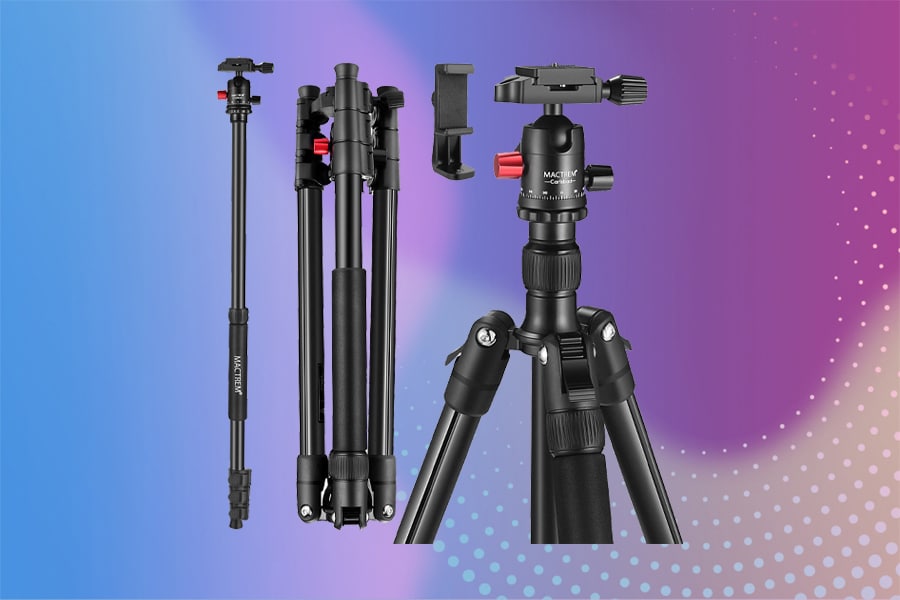
- 33 lbs(14.9kg) maximum load
- Budget-friendly
- Lightweight tripod at 2.9lbs (1.32kg)
- 90-degree tilting ball head
- A little short
If you’re on a budget, the Mactrem Heavy Duty Aluminium Tripod with 360 Degree Ball Head is for you.
The Mactrem is a lightweight and compact tripod that will support a hefty camera and lens kit on uneven ground. The tripod is lightweight at just 2.9lbs (1.32kg), allowing you to transport it anywhere you go.
This aluminum tripod features a folded length of 17.5″ (44.45cm), a minimum height of 21.5″ (54.6cm), and a maximum height of 62.5″ (158.75cm). While not the tallest max height, it’s a great value tripod for supporting heavier landscape photography cameras and for general portrait photography work.
Among its list of features, the Mactrem tripod is extremely rigid and includes an Arca-swiss compatible Quick Release Plate, flip locks, leg sections, removable monopod, and legs that fold up to 180-degrees.
The center column flips in just a few seconds to hang your camera upside down for low-angle photography and macro photography.
It’s one of the best budget-conscious aluminum tripods with a surprisingly good weight capacity.
3. Gitzo GT2532 Mountaineer Series 2 Carbon Fiber Tripod
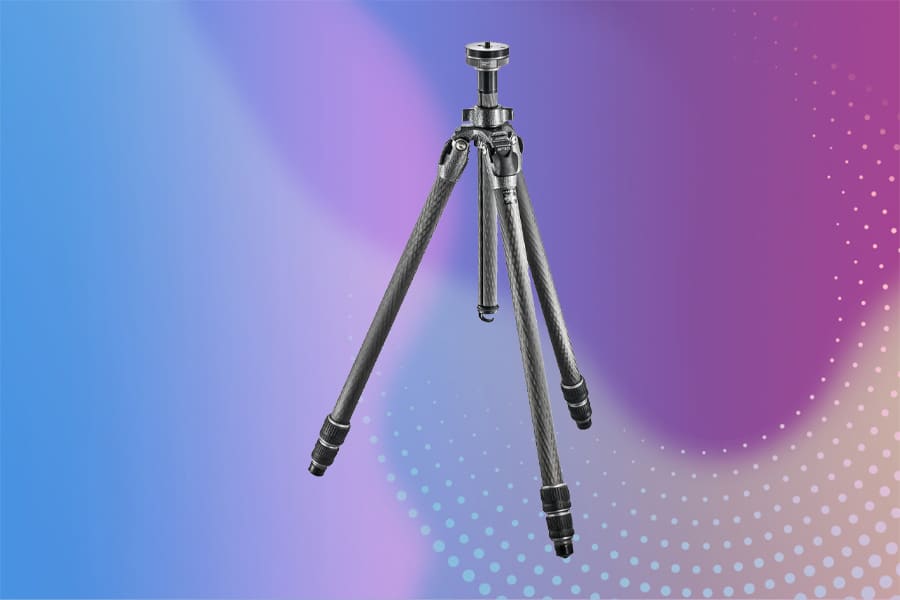
- Supports up to 39lbs (17.6kg)
- Lightweight tripod at 3.7lbs(1.68kg)
- Reversible center column
- Wider legs with twist locks
- Legs only – no ball head
The Gitzo GT2532 Mountaineer Series 2 Carbon Fiber Tripod is a brilliant example of the quality and precision engineering you can expect from a brand leader in the tripod space.
Constructed from carbon eXact, this tripod is one of the most stable for large camera/lens combos and effortlessly supports 39lbs(17.6kg). The Gitzo is the best tripod for heavy lenses that assures enhanced stability for your heavy lenses and DSLR with a battery grip.
All this from a tripod that weighs 3.7lbs(1.68kg) and has a folded length of 25.59″ (65cm).
The Gitzo GT2532 Mountaineer has a minimum height of 6.3″ (16cm) thanks to the reversible center column, making low-angle shots for macro photography are a breeze.
The maximum height is 166cm making the Gitzo ideal for studio and landscape work when a full extension is often preferable.
A good value ball head to pair with the tripod is the Induro Tripods BHL2S – a durable and sturdy ball head with an Arca-Swiss style quick-release system and smooth 360-degree panning action.
4. Induro CLT203 No.2 Stealth Carbon Fiber Tripod
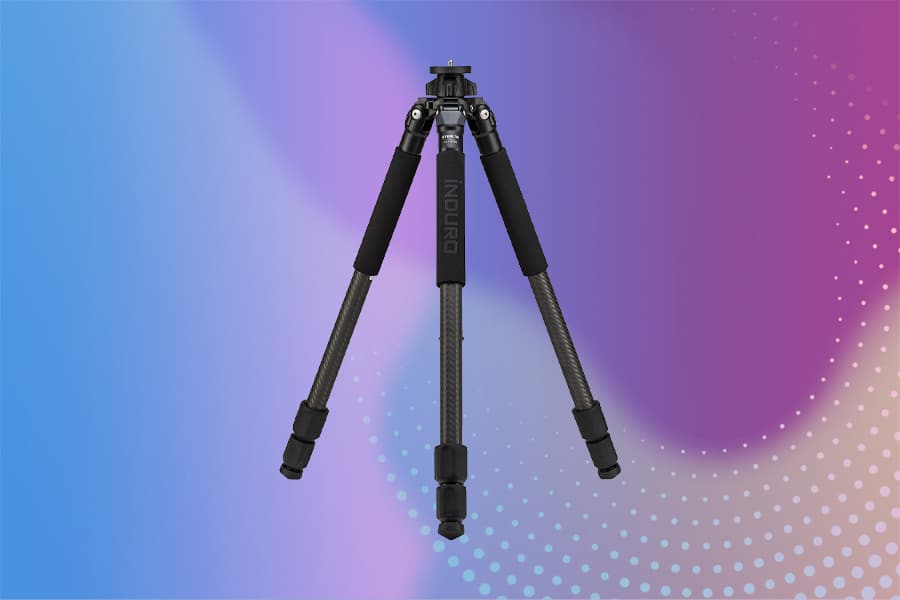
- 35.3 lb (16 kg) load capacity
- Carbon Fibre
- Twist Locks
- Sturdy center column lock
- Centre column not removable
The Induro CLT203 No.2 Stealth Carbon Fiber Tripod is a durable and super stable heavy tripod for your DSLR kit. Each of the carbon fiber legs features 3-sections with twisting locks for quick setup and takedown.
It makes our heavy-duty tripod guide due to its enhanced stability and useful 35.3 lb(16 kg) load capacity.
The Induro tripod has a folded length of 24.61″ (62.5cm) and weighs just 3.48lb (1.58kg), allowing you to strap it to any camera backpack when out and about adventuring.
It’s a flexible arrangement with legs that lock at three leg angles, a minimum height of 14.76″ (37.5cm), and a max height of 63″ (160cm).
Induro also develops durable tripod heads such as the aforementioned Induro Tripods BHL2S Ball Head that features an Arca-Swiss style quick-release system and smooth 360-degree panning action.
How to Choose a Heavy-Duty Tripod
When you’re shopping for a stable heavy duty tripod for cameras to support the weight of your heavy camera + lens photography setup, there are several things to consider.
In the guide below, professional landscape and astrophotographer Matthew Saville gives us his advice on making the right decision.
1) Twist Lock vs. Lever Lock
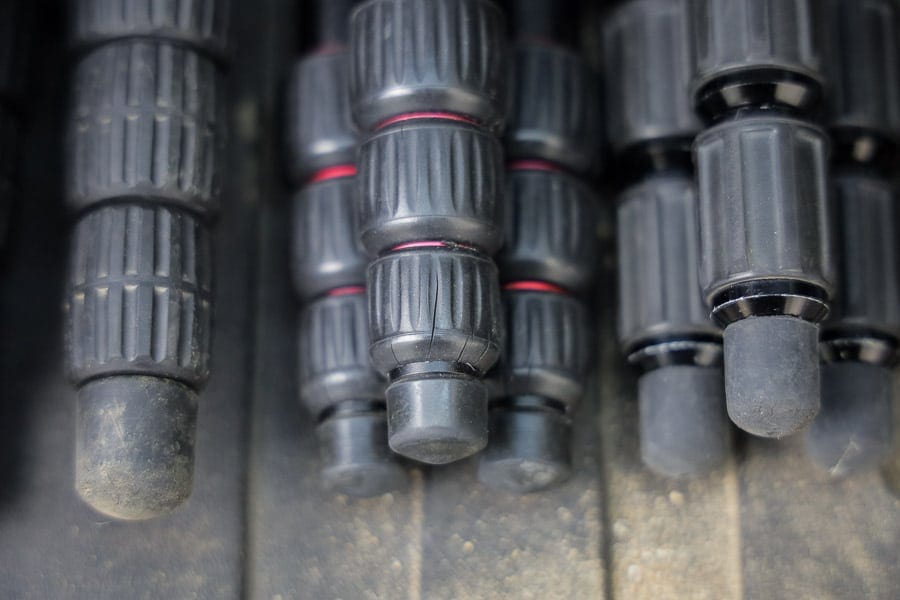
An assortment of Slik and Giottos tripod legs with twist-lock leg joints with rubber feet
One of the most strongly debated aspects of tripod design is twist-lock leg joints vs. lever-lock (flip locks).
In my opinion, this is a matter of preference. Both have advantages and disadvantages. Both can be very strong and reliable, and both can have incidents of total failure.
The biggest deciding factor between these opposite scenarios lies with the quality of the tripod itself .
Lever-lock leg joints generally never have issues with the lower legs getting twisted and jammed, which is a very nice plus in favour of lever-lock design.
However, lever-locks only “pinch” the tripod leg in one place where the lever is, and therefore if a lever-lock does fail on one or more legs, it may cause the immediate crashing of your entire tripod, instead of a slow slipping that might give you an extra second or two to grab your camera.
Twist-lock leg joints, on the other hand, use friction adjustment and clamp the whole tripod leg to make the leg stiffer overall .
They can still fail, of course, by simply not being fully tightened or by actual mechanical failure with a full load capacity. Either way, if they do fail, they usually slip slowly instead of collapsing instantly.
Any kind of tripod leg lock failure is bad though and can happen in just a couple of seconds. Therefore, the best thing you can do is buy a good quality tripod and make sure your legs are truly locked before you attach your camera.
2) Number of Tripod Leg Sections
The more leg sections a tripod has, the more flex it will have, making it hard to precisely frame a shot with heavier DSLR cameras and heavy lenses. It can even cause blur in the images, so it’s all the more important when shopping for a heavy-duty tripod.
Remember: one more leg lock per leg is three more points of potential failure.
A tripod that has just three or four leg sections (two or three locks) per leg is optimal to enhance stability but typically has a longer folded length. Tripods that have four locks, or five leg sections per leg, are usually a massive compromise on rigidity. Avoid them at all costs!
Thankfully, most tripod brands offer more than one option. Only a few brands offer nothing but 5-section legs, as they brand themselves as a maker of compact travel tripods.
Ironically, their tripods are actually bigger and heavier than many other travel tripods.
3) Leg Lock Materials
Both twist-lock and lever-lock tripod leg joints can be made of cheap quality plastic, high-quality plastic, or even metal. As you might imagine, cheap plastic lever-locks can easily break…
However, the problems with twist-locks are almost equally bad: the thin plastic shims and locking spacers in a twist-lock leg can fail and/or jam, causing both long-term frustration and abrupt complete failure.
Keep in mind that your tripod must carry your DSLR and heavy lenses at max height and full load capacity.
Simply put, avoid cheap plastic materials. Stick with name-brand options that have a long track record of surviving years of abuse by the types of photographers who use their tripods daily.
4) Tripod Center Columns
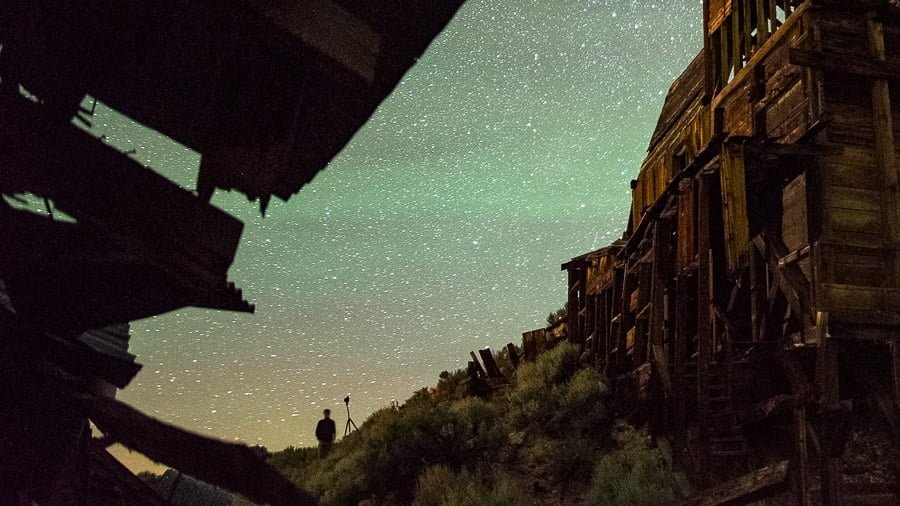
I only ever extend my center column when conditions are extremely calm and when the composition absolutely requires it
Avoid using a center column as much as possible. A center column is only a good idea when you absolutely need extra height, once in a while.
Your every day, most-used tripod should be tall enough that you can use it at eye level with the center column down.
Never use a tripod with a double-jointed center column or a “permanently up” center column. Simply put, a center column is too much of a compromise for both your image sharpness and the actual safety of your camera, and there are better options out there for lightweight travel tripods that don’t require such a compromise.
5) Tripod Leg Material: Carbon Fiber vs. Aluminum
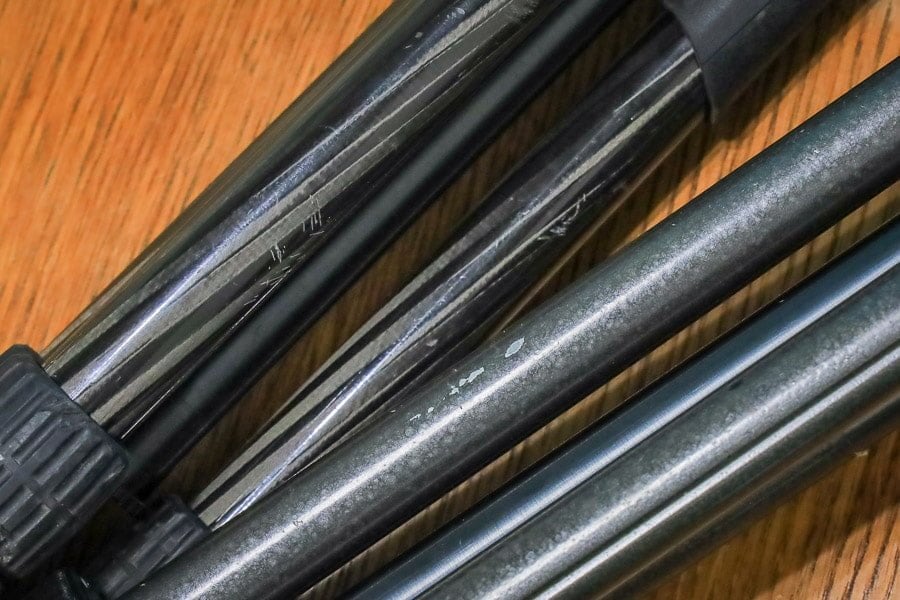
Carbon Fiber is lighter and stiffer than aluminum. However, aluminum is both more affordable and in some cases even more durable.
As far as tripod leg materials are concerned, the carbon fiber vs aluminium tripod debate rages on! In truth though, both materials have certain advantages.
Aluminum is affordable and quite indestructible when it comes to absorbing general scratches and dings.
Carbon fiber, on the other hand, is not only lighter but also stiffer and less prone to that “vibrato” that legs can get in windy conditions.
I will say this: I would rather have a name-brand, sturdy, stiff aluminum tripod than a wobbly, cheap generic brand carbon fiber tripod.
I have seen too many “basic” carbon fiber tripods utterly fall apart, or become very wobbly with a full load capacity.
While I do recommend carbon fiber for anyone who has over $300 to spend and is looking for a lightweight, strong tripod, if you’re on a budget, I would stick with the name brands even if it means getting an aluminum version instead of carbon one.
Name Brands such as Manfrotto and Slik both offer similar versions of their tripods in carbon and aluminum.
6) Tripod Leg and Head Grip Rubber Material
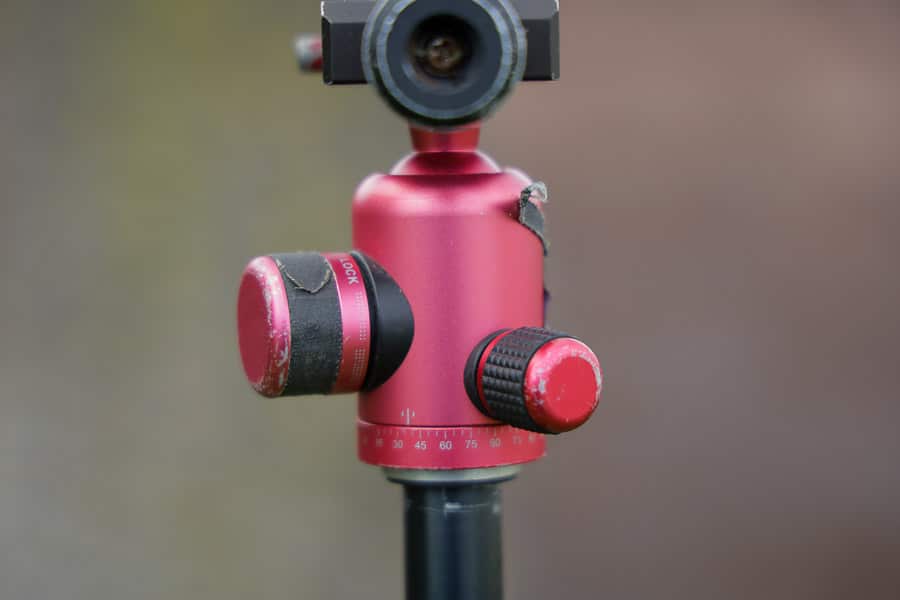
Giottos ball head: One locking knob lost its rubber after just a few months, hence the gaff tape. The other is cracking too.
If you ever leave your tripod in the sun for too long, (let alone in a hot car trunk for even just a few hours!), you may ruin the grip rubber on the leg locks and/or the tripod head’s locking knobs.
In fact, on literally all of the non-name-brand camera tripods I’ve ever tested, these rubber parts eventually “melt” and start slipping, (making it impossible to safely lock them) …or they’ll dry out and crack and fall off completely.

The cheaper the tripod brand, the sooner the grip rubber will crack or melt, such as on this “fake” Giottos tripod from eBay.
Only the best brands seem to have rubber parts that stand the test of time. My personal favourite? Any tripod brand that has all-metal knobs and lock grips!
These brands include (most) FLM tripods and heads, almost all Oben ball-type heads, and a few other brands that make heavy-duty tripods.
7) Tripod Size & Weight
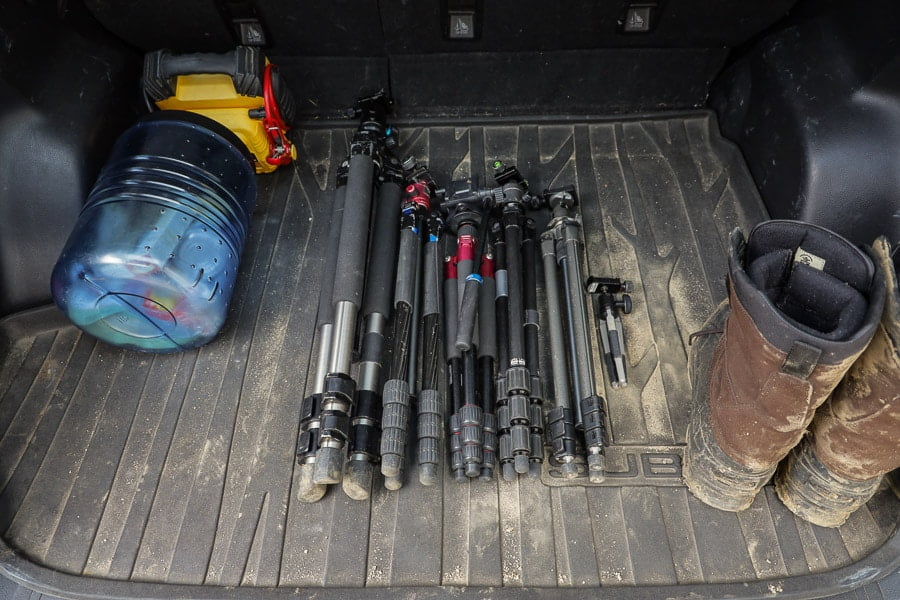
All shapes and sizes: just a small part of my tripod collection, including Slik, Giottos, and Manfrotto tripods
In case it isn’t already apparent, tripods of all weights and sizes can be useful. As a dedicated landscape and adventure/travel photographer, I’m a firm believer that there is no perfect size/weight tripod for everything that a serious photographer may do.
Your best first investment is likely to be a relatively medium-weight, tall tripod. It should be light enough so you don’t feel inclined to leave it at home, yet tall and strong enough that it can handle your biggest camera and lens without difficulty.
If you put a lot of wear-and-tear on your tripod almost daily, such as shooting on the beach with saltwater and sand repeatedly getting on your tripod leg locks, you may want to consider getting a big, heavy-duty tripod – one that can just be rinsed off under a shower or spigot afterwards, to clean off salt residue and other nasty stuff.
How heavy should a tripod be? Most DSLR tripods weigh less than 10 lbs, and most travel tripods weigh less than 5 lbs. The weight you choose should reflect how you plan to use it – hiking up a mountain will require something lightweight, for example.
If you’re wanting to make your tripod heavier when shooting on unstable ground or high winds, you can usually hang your camera bag from a hook under the center column if there is one.
By their nature, heavy-duty camera tripods are usually heavier and bulkier than other models, so this will help you keep a stable shot in adverse conditions. They will also support a heavier load capacity, especially when shooting on uneven surfaces.
8) Tripod Height
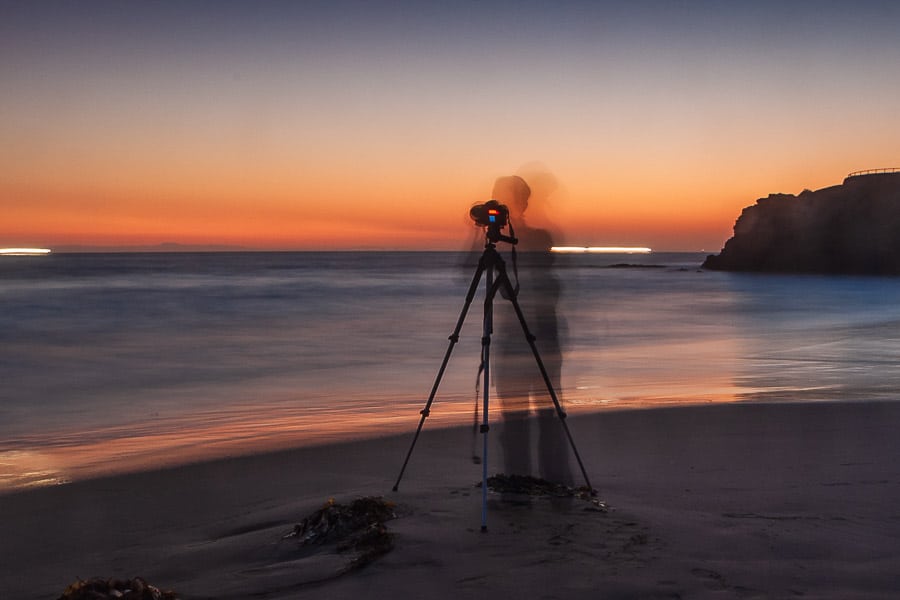
Your most-used tripod should reach eye level without the center column extended, such as this Manfrotto 190X Pro.
My best advice for choosing a stable tripod is to make sure you get one that reaches your eye level, preferably without using the center column.
If your camera doesn’t have an articulated LCD that allows you to look at it without hunching over such as the Nikon D750, then even a few inches to the max height can make a world of difference and save you some major back pain in the long run.
9) Tripod Feet
Tripod feet are another consideration when choosing a heavy-duty tripod. There are a few basic designs, each with various advantages.
i) Rubber-tipped feet are friendlier to your floor if you ever use the tripod indoors and especially on tile or wooden floors.
ii) Some tripods offer metal spiked feet, for really gripping outdoor surfaces, from soft dirt to hard rock.
Many tripod brands now offer retractable spikes, meaning you can screw the foot one way to have a rubber foot, or screw it another way to expose a metal spike.
However, on cheaper brand tripods, this is just another thing to go wrong- eventually, the rubber feet will fall off and you’ll be left with just the spikes. This is just another reason to get a good quality tripod, even if it only comes with rubber feet, or if metal spiked feet are an aftermarket accessory.
iii) Some tripods offer specialty feet, such as sharp claws for really grabbing rocks or to minimize sinking in sand and snow. (Really Right Stuff makes these; watch out though – they’re razor-sharp!)
10) How do I choose a tripod head?
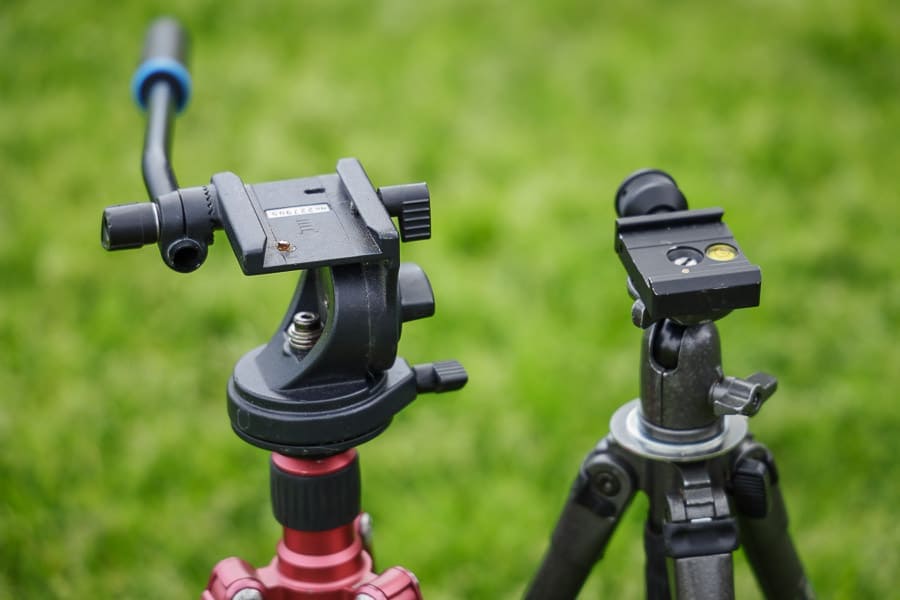
Left: Benro Video (3-way) head. Right: Slik Mini Ballhead (1 locking knob only)
While many heavy-duty tripods do come with both a set of “legs” and a “head” together, some of the best choices might be sold as legs only, without a head.
You don’t necessarily have to buy tripod heads and legs separately, but let’s discuss the different types of heads so that you can make sure to buy what’s right for your type of photography.
Ball heads are simple: One knob loosens and tightens the entire thing, allowing you to freely compose your frame with much flexibility.
The better tripod heads do offer separate locking knobs for side-to-side panning motion, and possibly even an additional knob to adjust the overall tension of the main locking knob.
I recommend looking for a tripod head with both a main locking knob/lever and a separate panning lock.
- 3-Way Panning Head
The other most common type of head is the 3-way panning head. These heads allow you to separately control the angles of your camera, to more carefully compose your shot. They’re usually a little bigger and more cumbersome than ball-type heads, but they offer better precision that can be very useful.
Many 3-way heads also offer a large panning arm, for smoothly panning your camera up, down, left, or right when recording video. It’s an ideal feature for shooting with heavy lenses too.
If you’re a run-and-gun type of photographer, however, we do recommend heads for their speed and portability.
- Gimbal & Nodal Heads
Lastly, for the truly enormous telephoto lenses, and for panoramic stitching, nodal and gimbal heads offer a unique benefit – they allow you to freely move your camera around while keeping it perfectly balanced, and/or keeping it over the nodal point of the lens which makes panoramic stitching almost effortless.
These types of heads are usually the biggest and most expensive, however, so I don’t recommend them as your very first investment.
11) Tripod Head Quick Release System
Thankfully we can keep this simple: Arca-Swiss is the universal clamp system for photography, and your best bet is to adopt it.
Arca-Swiss is based on a 2 piece mechanism, with a ‘plate’ attached to a camera or a lens, and a ‘mounting base’ or a ‘clamp’, where the plate gets attached and secured.
With Arca-Swiss, you can freely swap most camera plates and tripod head clamps, making it very convenient to use multiple tripods and just leave the plate attached to your camera.
Arca-Swiss also offers L-brackets, which allow for quick vertical mounting of your camera.
There are other, proprietary tripod quick release plate systems, and the smaller ones should be avoided as they just won’t support much more than a GoPro or small point & shoot camera .
Manfrotto has two different proprietary quick release plate systems, both of which are very sturdy, one made for photographers and the other is quite universal for videographers. However, unless you’re a serious videographer, I recommend sticking with Arca-Swiss.
12) Bubble Levels
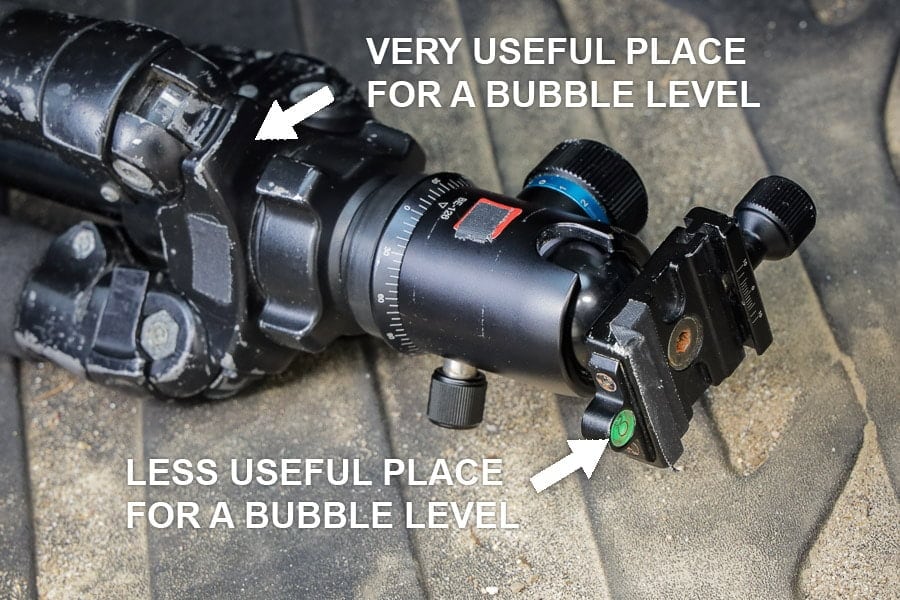
Not enough tripods have a bubble level in the “perfect” spot.
Most cameras have digital levels these days, so why would you need a bubble level on your tripod itself?
A perfectly level tripod can be helpful for creating perfectly level panoramas very quickly, instead of having to re-level the camera for every single frame of a pano.
For this, ignore most bubble levels that are placed randomly around the ball head; they’re not nearly as useful as having a bubble level on the tripod base itself.
13) Tripod Cost, Budget & Value for Money
As the saying goes, “buy the expensive option once, and it will only hurt your wallet once. Buy the cheap option, and it may hurt twice, or more…”
In other words, when setting your budget for a tripod , you should consider the long-term cost. A tripod that breaks after just 1 year, but costs more than 1/3 the price of a tripod that lasts 3-5+ years, is simply not a good value.
So, if you can’t afford a good tripod right away, just keep saving up .
Having said that, while saving for your more expensive tripod, there are numerous options you can purchase in the meantime at very affordable prices. It won’t be wasted money in the long run, because the tripod will become a backup or secondary tripod if you ever save up for a nicer one.
Final Words
Buying a sturdy tripod that’s strong enough to handle your heavy camera and long telephoto lens needn’t be so complicated.
Despite the length of this guide, your decision really only boils down to tripod quality (read buyer reviews on Amazon), maximum load capacity, and your intended use.
The best tripod is a personal choice based on the kind of photography you wish to shoot and where you want to shoot it.
Investing in big-name brands may make the best sense to you if you plan to use the tripod frequently, but the lesser-known brands introduced in this guide are great value for money too.
Happy shooting!
You'll Also Like These:
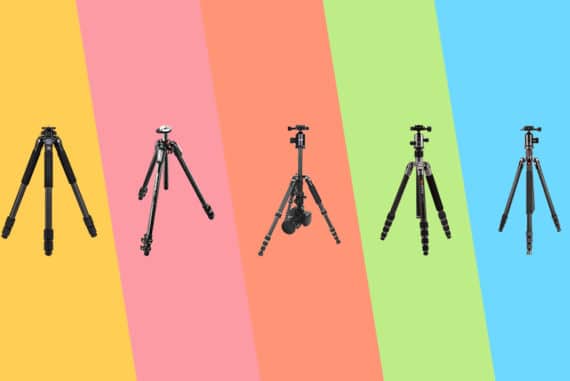
I’m a Melbourne-based street photographer and blogger. I love to travel to Japan to photograph and document its dynamic people and culture.
Thanks for checking out my latest guide. If you have any questions or comments please leave them here and I will get right back to you. Cheers. G
Leave a Comment Cancel Reply
👋 WELCOME TO SHOTKIT!

🔥 Popular NOW:

Unlock the EXACT blueprint to capture breathtaking iPhone photos!
Shotkit may earn a commission on affiliate links. Learn more.
Best Tripod for Heavy Lenses

Whether you regularly shoot with a large lens or you’re looking for the most versatile tripod, finding the best tripod for heavy lenses isn’t an easy feat. There are so many options out there and various factors to consider.
In this article, we take a look at the best tripods out there for those who have a heavier rig to work with . Whether you’re an absolute beginner or someone looking for a more premium option, we’ve got you covered with our comprehensive list!

Best Tripod for Heavy Lenses:
When you buy through links on our site, we may earn a commission at no cost to you. We evaluate products independently . Commissions do not affect our evaluations. As an Amazon Associate, we earn from qualifying purchases.
1. Manfrotto MK190xPro4

The MK190xPro4 is a durable tripod with a high load capacity and useful features.
Manfrotto are well-known makers of premium tripods. One of their best heavy-duty models is the Manfrotto MK190XPRO4 . This durable tripod certainly can’t be considered a budget option, but it is the best tripod for heavy lenses and large cameras.
The MK190 can carry 13.2lbs/6kg. This is more than enough to cope with a large DSLR camera with a heavy telephoto lens, for example. The legs also extend up to a maximum of 68.1 inches/173cm giving excellent versatility in the positioning of your camera and how you use it.

This tripod also features a quick power lock system, meaning you can unclip the legs and extend them in a matter of seconds. Building on the functionality, the head also has a quick-release plate system so you can attach your camera with ease. You also get pan and tilt functionality thanks to a retractable handle on the head. This makes it ideal for cinematic videos and tracking subjects. This is an excellent tripod and can easily offer a stable platform for larger camera/lens setups.
2. Benro Mach 3

The Benro Mach 3 is a great mix of durability and utility with a great load capacity.
Benro is another popular tripod manufacturer. The Benro Mach 3 is one of their best tripods for heavy lenses. This tripod offers a great combination of compactness and durability. It weighs just 4.5lbs/2kg yet has an amazing load capacity of 35.3lbs/16kg. There probably isn’t a camera/lens combination that comes close to this!
Despite being a compact tripod, its three legs can still be extended from 14 inches/35cm to a maximum of 69.7 inches/177cm. This gives you great flexibility in your tripod setup. We also like the twist-lock mechanisms of the legs. To extend them, simply twist the locking mechanism and tighten them up when you’re happy with the length.

The head has a simple universal tripod mount that should be compatible with any camera or lens. It also features screw-in rubber feet to provide extra stability on uneven surfaces. Alternatively, you can make use of the stainless steel spiked feet if you want to push the tripod into softer ground. Made from carbon fiber, this tripod is also incredibly durable for outdoor use.
3. MeFOTO Globetrotter

The Globetrotter has a high carrying capacity and excellent lock mechanisms.
The MeFOTO GlobeTrotter tripod is another fantastic model that has a heavy-duty build that can support large lenses. The frame and legs are made from carbon fiber which makes it robust but also lightweight at just 3.7lbs/1670g. It is also highly compact as the legs fold up inversely.
The head offers a 360-degree panning action and it can also be tilted. It also has a simple connection so you can quickly attach your camera. The head is highly secure, and you should not notice any sagging when the camera is locked. We also like the twist mechanism of the legs. Each leg extends into four sections, and these can be quickly unlocked with a simple twist of your hand. Two of the legs can also be used in an independent position so you can use the tripod at different angles.

For extension, this tripod has a height range of 16-64 inches/41-163cm. Finally, in terms of weight capacity, this tripod can carry up to 26.4lbs/11kg. There should be no issue here with any large DSLR and heavy lens combination.
4. Gitzo Lightweight Series 1 Traveler

The Series 1 Traveler offers the ultimate in quality and design with a great load capacity.
The Gitzo Lightweight Series 1 Traveler is one of the most durable and well-built tripods you will find. However, it comes with a large price tag. This is certainly not a beginner tripod, but for those who will make regular use of it.
It is made from lightweight carbon fiber including the ball head. The extension tubes are also made from carbon fiber which makes the legs durable and provides excellent stability. Each leg can be extended three times and they use a simple and effective G-lock leg system.

For carrying large lenses the Series 1 Traveler has a maximum load capacity of 22lbs/10kg. The carbon fiber head should also help keep any heavy-duty lens stable without any rogue movement. The ball head can be detached easily using the included safety pin. You can then attach another compatible head if you wish. This is a premium tripod, but it is one of the best you will find for heavy lenses, and it will last for years too.
5. Neewer Professional Heavy Duty Tripod 76-inch

This Neewer Tripod is easy to use and gives great stability.
Moving on to a slightly cheaper model, the Neewer Professional Heavy Duty Tripod offers excellent features at a cheaper price compared to the models above. It still isn’t the cheapest available, but it makes for a great beginner tripod for those just getting into photography.
The legs and head are made from aluminum which makes the tripod lightweight and strong. Also, the legs can be extended to a maximum height of 85 inches/193cm which makes it one of the tallest tripods on this list. It is not the most compact design when folded, but the legs do fold and extend easily.

We also like the ball-head attachment. This allows for fluid movement and great control over your angles . You can rotate the head 360-degrees and tilt it using the panning handle. The locking mechanism for the head and the plate are also simple to use and keep your camera secure. There is also a spirit bubble on the head that ensures you can align your camera properly for horizon shots, for example. Finally, it can carry a maximum load of 26.5lbs/12kg.
6. Manfrotto 055 Aluminum 3-Section Tripod

The Manfrotto 055 is a versatile tripod with excellent features and utility.
If you still want a Manfrotto tripod but don’t want to spend a fortune, the Manfrotto 055 could be an excellent option. This is the best tripod for heavy lenses for travel photos and use on the go. This is because it is compact and the legs fold up neatly to reduce the required storage space.
The legs can be extended three times, although it does use the older G-clamp system for locking the legs. Although this is slower, it will still keep the legs secure. The complete aluminum design makes the tripod lightweight but strong.

For movement, the head has a center column, so you can rotate it however, it does not have any tilt functionality. The center column can be extended though, which can improve the maximum height of the tripod. For load capacity, the Manfrotto 055 can support 19.84lbs/9kg.
7. ZOMEI Aluminum Portable Tripod

This ZOMEI tripod is perfect for those starting out in photography.
Our last pick is the ZOMEI Aluminum Portable Tripod . This is our top budget option and is excellent for beginners who simply want to experiment with a tripod. For this budget price, you get a compact and durable tripod that has a maximum load capacity of 26.5lbs/12kg.
The leg tubes are made from aluminum, and it also has a simple ball head attachment. This is only a basic ball head, but it still allows for 360-degree panning, and tilting actions. It also secures easily using a simple twist dial.

We also like that this tripod can be converted into a monopod by using the removable center column. Each leg can also be extended 4 times, and the legs use a convenient twist-lock mechanism.
Which Tripod for Heavy Lenses is Right for You?
As you can see, there are a wide range of heavy-duty tripods available. Which you choose depends on exactly what you want to achieve with your tripod and your circumstance. For example, if you simply want a cheap but durable tripod for your travels, something like the ZOMEI Aluminum Portable Tripod is a good option.
Alternatively, if you want the ultimate in quality and durability, premium options like the Manfrotto MK190XPRO4 or the Gitzo Lightweight Series 1 Traveler make for great investments. Whichever you choose, it is advisable to check the maximum load capacity, and the tripod mount system, to make sure your camera and lens are compatible.
Disclosure/Disclaimer : As an Amazon Associate, we earn from qualifying purchases. Certain content was provided "as is" from Amazon and is subject to change or removal at any time. Product prices and availability: Amazon prices are updated daily or are accurate as of the date/time indicated and are subject to change. Any price and availability information displayed on Amazon.com at the time of purchase will apply to the purchase of this product.
A seasoned content creator at PhotoWorkout, Paul merges his love for traveling and photography to craft insightful articles. With a solid grasp of Adobe Lightroom and Photoshop, he enjoys testing new photo software, apps, and gear. His background in web development further enriches his photography endeavors. Connect with him on LinkedIn .
Leave a Comment Cancel Reply
Your email address will not be published. Required fields are marked *
Save my name and email in this browser to see the comment immediatley and edit it if needed. You can clear your browser data at any time.
Notify me via e-mail if anyone answers my comment.
Subscribe to our weekly newsletter. We won't send you spam. Unsubscribe at any time.
Best travel tripods 2024: the top lightweight tripods to buy
These are the best travel tripods – compact and lightweight enough to squeeze into a backpack, suitcase or even a pocket

As any travel photographer will tell you, stability is everything. It may seem to be mostly about location, composition, and what kind of camera you take on the road with you, but once you’ve found your perfect shot, you need to keep steady.
If you’re planning creative shots or any kind of long exposure or repeated photography – such as landscape photography around sunset, time-lapses, or astrophotography – then a tripod is absolutely essential. Cue the best travel tripod.
You're not off the hook even if you're just planning to go on holiday with a smartphone. Though increasingly capable, smartphones’ cameras are still rather limited if you handhold them. You’ll be seriously surprised how much extra quality and creativity you can achieve by using a small tripod and a phone clamp.
So in our buying guide, we've included options for keeping smartphones steady as well as custom-made travel tripods for the best travel cameras , DSLR , mirrorless , and compact cameras .
The best travel tripods you can buy today:
Why you can trust T3 Our expert reviewers spend hours testing and comparing products and services so you can choose the best for you. Find out more about how we test .

1. Vanguard VEO 235AB Tripod
Specifications, reasons to buy, reasons to avoid.
If you're after a reasonably heavy duty tripod for a DSLR or mirrorless camera using large lenses, look no further than this relatively lightweight tripod from Vanguard. This is a brand that tends to use aluminium, or for even more money, carbon fibre, but it usually stops short of providing full-length tripods. This design, weighing about 1.5 kg, is just 38 cm when folded, but reaches only 147 cm when it’s fully extended. So it's probably not the best choice if you’re a six-footer, though for most photographers it will provide more than enough height. The twist-and-lock legs are easy to extend and pack-up while moving, and the ball-head offers plenty of movement.

2. Manfrotto MKBFRTA4BK-BH Befree Advanced Tripod
This Italian-made tripod is clearly aimed at semi-pro landscape and astrophotographers who need to travel. With ‘M-lock’ lever legs rather than twist-legs and a ball head, this aluminium-crafted travel tripod has three four-section legs and a tough central column. Those legs unfurl easily enough, and lock into place, and each leg can pan through 180°. In fact, the legs actually go backwards on themselves, reducing the footprint for packing it in a suitcase. It weighs 1.5kg, and has a quick-release ball-head, though it takes some time getting to know it, so practice before you head outside in the dark. It’s a bit of a specialist tripod, but it’s worth its weight.
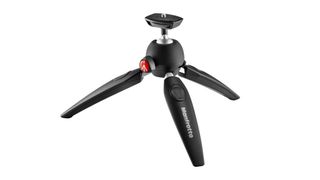
3. Manfrotto PIXI Evo Tripod
There are few travel tripods around that can support absolutely any kind of camera. The core tripod is small, pocket-sized, and weighs just 260g. It has a standard quarter-inch thread adapter, so can be used natively with any DSLR, mirrorless or compact camera. It also comes in two separately available configurations; one with a smartphone clamp fitted on the top, and one with a GoPro /action camera-compatible module. However you decide to use it, rest assured that it’s easily strong enough to cope with anything. It's also very easy to position. Pressing one button loosens the ball head, so you can find your exact position, while releasing the button locks it in place. Clever stuff, but although the camera can tilt to a full 90°, the angle of elevation is limited; you can’t shoot anything above you, for example.
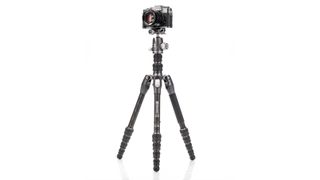
4. Benro Rhino FRHN05CVX20 travel tripod
The Benro Rhino FRHN05CVX20 travel tripod is strong and sturdy, yet at the same time lightweight due to a carbon fibre leg construction. This premium-feel travel tripod has a further trick up its sleeve – one of its legs can be removed to transform it into a portable monopod. A carbon fibre construction, as opposed to the more affordable aluminium, inevitably means this premium look and feel tripod also comes with premium-ish price tag. It also needs a short period of familiarisation with its myriad features before becoming operationally competent.
- Benro Rhino FRHN05CVX20 travel tripod review
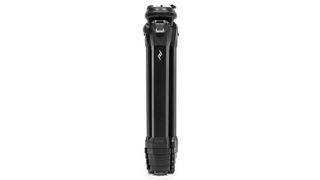
5. Peak Design Travel Tripod
The Peak Design Travel Tripod is really expensive, but it's also the neatest travel tripod around, no doubt about that, and it’s also one of the lightest. The aluminium version has a high-end build, a very neat and compact design, and some excellent unexpected features – chief of which is that smartphone adapter – but it’s not immeasurably better, performance-wise, than a much more affordable travel tripod. Still, though, if money is no object and you want the most premium travel tripod experience, then this is the travel tripod for you.
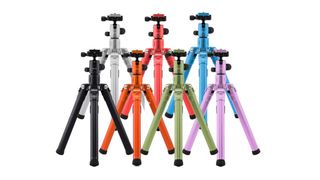
6. MeFoto RoadTrip Air Tripod
Reasonably large tripods are all about design, specifically how long the leg sections are when completely unfurled, and how small they are when packed up and ready to be put in a suitcase. The MeFoto RoadTrip Air is clever on all counts, reaching loftier heights than most travel tripods manage while being exceptionally small when packed away. It does all this by having an extra section in each leg, five parts rather than the standard four parts, though that doesn't add any instability. Weighing just over a kilo, the MeFoto RoadTrip Air attempts to go for another market altogether by suggesting that the central column and the included smartphone clamp (and Bluetooth remote) can be used as a selfie stick. Clever stuff, but that’s probably a different market.
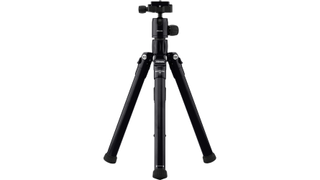
7. MeFoto BackPacker Air Tripod
Known for its brightly coloured travel tripods, MeFoto has here produced an excellent product for owners of action cameras, mirrorless cameras and smartphones who want a ‘proper’ tripod capable of significant height. At its core is HyperLock, three five-section legs and a central column (which also detaches to act as a separate selfie stick) that extend – by just a twist – from a compact 26.5cm to a whopping 151cm. However, it’s at its most stable at 110cm before its central column is extended, so photographers should look at this as an emergency tripod for travel rather than as a ‘main’ tripod. Also in the box is a adjusting ball head, a screw-on mount for a smartphone, and even a wireless Bluetooth remote for taking selfies and super-stable shots.
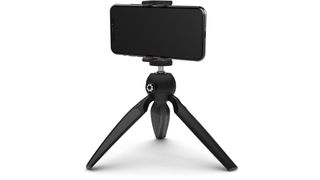
8. Joby HandyPod
Sometimes you just want a small, pocket-friendly, but steady and capable tripod for occasional shots. Cue the HandyPod, a simple aluminium tripod that will perform almost any task well. Any camera or smartphone mount can be attached thanks to a standard tripod thread, and once attached that device can swing through 360° on the HandyPod’s ball head. That ball head can be locked in position using a simple push-button mechanism, and while the legs’ rubber pads add stability, the HandyPod has a dedicated handgrip so can be used off the ground for panning video shots. Also available is the HandyPod Mobile package, which adds Joby’s GripTight One GorillaPod universal mount for smartphones.
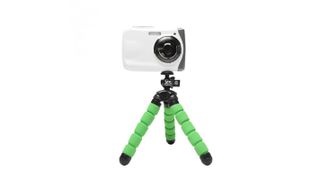
9. XSories Deluxe Tripod
Here’s a great example of the kind of commodity tripod that dominates the market, and yet this particular one is exceptionally good at what he does. Firstly, it weighs almost nothing, clocking in at just 65g. It's also very slim, so can easily fit into a trouser pocket or jacket pocket. On top is a small ball head for flexibility, and a standard quarter-inch tripod thread that attaches to any compact camera, or any cheap smartphone clamp that can be had for a few quid. In practice, it's halfway between a bendy, Joby-style tripod and a rigid design. Although it can be used as a standard straight-legged tripod, there is easily enough give in the legs to wrap round something, such as a fence post or a tree branch. Don't bet on putting too much weight on the XSories Deluxe, but if you have a small camera, or phone ( and a separate screw-on clamp ), it does the job very nicely.
How to choose the best travel tripod
The travel tripod market is split to serve the kind of device you’re using, of course. For phones, it's largely a commodity market, because the tripod and the clamp that keeps your phone in place don't have to bear much weight. Consequently, these types of tripods can cost just a few quid and are easy to travel with.
Lightweight designs are what the rest of the market aims for, with tripods designed for DSLR and mirrorless cameras much larger, but often manufactured from very lightweight materials. Consequently, they can be expensive. In fact, at the top end of the market, just shaving a few grams of the weight usually explains the high price.
Happily, in-between cheap smartphone designs and expensive top-end configurations for expensive cameras, there are a fleet of smaller, tougher travel tripods that are good for all kinds of equipment and scenarios. Amazon is usually the best place to head for travel tripods, as you can get hold of highly-rated products for sometimes a fraction of the high street price.
Get the T3 newsletter!
All the best features, news, tips and great deals to help you live a better life through technology
Jamie is a freelance journalist, copywriter and author with 20 years' experience. He's written journalism for over 50 publications and websites and, when he's not writing, spending most of his time travelling – putting the latest travel tech through its paces.

This portable iPhone stand is perfect for hands-free FaceTime calls and impromptu dance videos
By Mat Gallagher Published 6 April 24
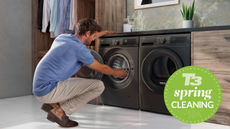
If you spend more time thinking about cleaning than actually doing it, this tool is for you
By Lizzie Wilmot Published 6 April 24
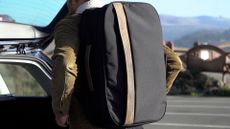
The best travel backpacks for everything from weekends away and business trips to backpacking and hiking
By Jamie Carter Last updated 20 December 23

This heavyweight USB-C power bank with a MagSafe wireless charging pad is ideal for home, office and travel with electronics
By Jamie Carter Published 9 March 22
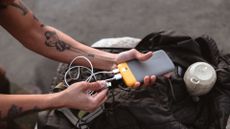
Whether you’re travelling, commuting or in the office, the best power banks keep your smartphone, laptop and everything recharged and ready to use
By Jamie Carter Last updated 15 March 24
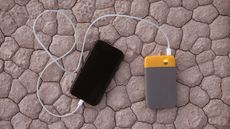
Travel-friendly and fuss-free USB-C power bank for recharging laptops, smartphones and more
By Jamie Carter Last updated 9 March 22

We showcase a selection of the best gifts and presents for photographers, for every budget
By Gavin Stoker Last updated 7 December 23

Want to print your photos but don't know where to start? We're here to help you decide…
By Gavin Stoker Published 6 January 22

Want to print high-quality photos at home? Here's how!

The best photo printing services will make preserving your memories a cinch
By Sarah Griffiths Last updated 4 January 23
Useful links
- When is the next Prime Day?
- Best 5G phones
- Best VPN services
- Best laptops
- Best smartphones
- Best mattresses
- Best phone deals
- Best mattress deals
- Best TV deals
- Discount codes
7 Best Tripods for Heavy Lenses for Photographers
By Tati Taylor 16 days ago, Tripods
What should be the payload of a tripod for heavy lenses?
If you are into nature, sports, or astrophotography, you should use a tripod for heavy lenses. Since such genres require long distances, you need a special tripod to hold such lenses. With a durable tripod, you'll get accurate images when shooting in low light and at long exposure. Besides, tripods make it easier to shoot panorama images.
Top 10 Tripods for Heavy Lenses
- Manfrotto MT 190X Pro 4 - The best overall choice
- Benro Mach 3 - Best variability
- Neewer Professional Video Tripod - Affordable pro-level model
- Gitzo Lightweight Systematic Ser.5 - Premium ultra-durable tripod
- Leo 2.0 Travel - Compact carbon tripod
- MeFOTO GlobeTrotter Classic - Good for traveling
- Induro GIT305L No. 3 - Hi-stable model
High-quality tripods are available in different price ranges depending on the materials and design. You should make the choice based on your preferences and budget. If you have a full-frame camera or a long lens (over 300mm), it’s worth looking for a more expensive and sturdy tripod for heavy lens.
1. Manfrotto MT 190X Pro 4 – Our Choice
Max Height : 63 in | Min Height : 3.1 in | Leg Sections : 4 | Payload : 15.4 lb | Weight : 4.5 lbs
- ✚ 4 adjustable legs
- ✚ Rotating bubble level
- ✚ Quick Power Lock system
- ✚ Easy Link plug
- ✚ UNI Safety payload
- — Head costs extra
Manfrotto manufactures premium tripods for heavy lenses that meet Italian quality standards. The MT 190X Pro 4 is their best all-around model that passes all the tests. The device stands out with a quick-lock system that allows you to detach the legs and extend them in seconds with one hand.
The tripod is easy to set up and has a convenient connector for accessories, such as LED light.
You can use the column at various angles and put the legs almost horizontally to support the camera. If you’re looking for a combination of build quality, portability, and load capacity, you should consider one of the best Manfrotto tripods .
2. Benro Mach 3 Series
Max Height : 70.47 in | Min Height : 16.14 in | Leg Sections : 3 | Payload : 35.3 lb | Weight : 5.2 lbs
- ✚ Well designed and inexpensive
- ✚ Adjustable twist locks
- ✚ High load capacity
- ✚ Interchangeable screw-in rubber feet
- ✚ Universal head mount
- — Folded length
- — Low height
The Benro Mach 3 series includes the best tripods for heavy lenses that combine compactness and durability. Due to a versatile head, the tripod is compatible with most cameras. It stands out with screw-in rubber feet, which allows it to remain stable on uneven surfaces. Moreover, it has retractable legs with stainless steel spikes for softer ground.
The maximum working height of a central column provides the best eye-level shooting experience. Locking swivel mechanisms helps you lock the legs quickly and securely. The Mach 3 is a stable and durable mid-range tripod for beginners and photographers on a budget. However, the device might be a bit heavy and bulky.
3. Neewer Heavy Duty Professional Video Tripod
Max Height : 76 in | Min Height : 33.5 in | Leg Sections : 3 | Payload : 26.5 lb | Weight : 12.9 lbs
- ✚ Fluid drag head
- ✚ Efficient shock absorption
- ✚ 70 to 90˚ vertically adjustment
- ✚ Knob can be locked by rotating 1/4 turn
- ✚ Mid-level spreader
- — Too long even when folded
- — Lack of the retractable central column
Neewer has an attachable ball head, which provides smooth movement and control over any shooting angles. You can rotate it 360 degrees and tilt it with the pan control. With the simple locking mechanism, you can keep the camera safe. A bubble level makes it easier to take horizon shots.
The tripod supports a maximum load of 26.5 pounds. Its legs can be extended up to 85 inches, being one of the highest tripods on the list. Though it doesn’t have a compact design, you can fold its legs for convenience.
The Neewer Professional heavy-duty tripod offers advanced features at a lower price compared to the models above. Though it’s not the cheapest tripod available, it still works great for those looking to get professional photo or video equipment at an affordable price.
4. Gitzo Lightweight Systematic Ser.5
Max Height : 61.42 in | Min Height : 3.94 in | Leg Sections : 4 | Payload : 92.61 lb | Weight : 6.2 lbs
- ✚ Carbon eXact tubing
- ✚ Easy Link attachment thread
- ✚ Premium long-lasting design
- ✚ Comes with photo/video accessories
- ✚ Low ground/safety payload settings
- — High-priced
- — Lack of a head and central column
The Gitzo Lightweight Systematic Series is the most durable high-quality tripod that comes at a high price tag. It is made of lightweight carbon fiber, including plate and extension tubes. Its legs are strong and provide excellent stability with a simple and effective G-lock system.
Due to the material, it is one of the most stable tripods for heavy cameras and lenses. It can easily hold a heavy camera while providing enhanced stability thanks to a battery grip.
Though this tripod for heavy camera lenses is pretty expensive, it has great value for the money due to its lightweight, compactness, and load capacity. If you’re looking for a device for regular use, pick this model as it will last for many years.
5. Leo 2.0 Travel
Max Height : 54.3 in | Min Height : 4.9 in | Leg Sections : 5 | Payload : 66 lb | Weight : 3.35 lbs
- ✚ Additional legs with spikes
- ✚ Twist-lock locking mechanism
- ✚ Removable 2-section column
- ✚ Bubble level
- ✚ Comes with a carrying bag
- — Less resistant to vibration
- — Pretty low height
The Leo 2.0 Travel Tripod released by 3 Legged Thing stands out with a futuristic carbon design. It features detachable legs that give it maximum support. You can adjust its legs at three different angles. They can hold 22 pounds when they are 80 degrees off-center. What’s more, it allows users to use each leg as a monopod of up to 40 inches high. You can combine one of the legs with the central column to make a 55.7" monopod.
The Leo has a unique design with a central reversible column that can be flipped for shooting at a low angle, which makes it perfect for macro photography . While its weight is 3 pounds, the tripod can hold 20 times its weight. It’s pretty compact when folded. If you’re a blogger or traveler looking for an inexpensive and durable tripod, this model is your choice.
6. MeFOTO GlobeTrotter Classic
Max Height : 62.2 in | Min Height : 16.1 in | Leg Sections : 5 | Payload : 26.4 lb | Weight : 4.59 lbs
- ✚ 5 retractable leg sections
- ✚ Monopod and bag included
- ✚ Multiple colors
- ✚ Twist Lock with anti-rotation system
- ✚ Spring-loaded recessed hook
- — Only 2 leg angles
- — Heavy for its size
The MeFOTO Classic is a lightweight tripod for heavy lens. You can fold it and pack it into a backpack since the legs can be flipped in opposite directions. Besides, you can attach the legs of the stand to the base by snapping them on at the ends, thus achieving the stability needed during shooting.
The tripod can be used as a monopod. It supports most types of cameras. The quick-release tripod plate allows for 360-degree panning. You can fix tripod legs independently of each other at two different angles.
7. Induro GIT305L No. 3
Max Height : 58.46 in | Min Height : 7.3 in | Leg Sections : 5 | Payload : 55.12 lbs | Weight : 2.2 lbs
- ✚ Heavy-duty construction
- ✚ Versatility option
- ✚ Includes carrying case
- — Expensive and bulky
- — No central column
One of the standout features of the Induro GIT305L is its heavy-duty construction. It's designed to support even the most hefty camera and lens combinations, providing stability and a sturdy base for your equipment. The carbon fiber material used in its build ensures durability without adding unnecessary weight.
I particularly appreciate the versatility of this tripod. The reversible center column allows for low-level shots, which can be a game-changer for certain creative compositions. The ability to angle the legs in three different positions also comes in handy when dealing with uneven terrain.
How to Choose the Best Tripod for Heavy Lenses?
To choose the best tripod for heavy lenses, you should consider devices that support the weights of your camera and lens. Other requirements don’t differ from those for basic tripods.
Load capacity is the first aspect to consider when looking for a tripod. It defines whether it will be able to hold the weight of your photo or video camera, long focal length lenses, such as lenses for wildlife photography and other accessories you need during shooting. Your ideal tripod should support at least 1.5 times the weight of the heaviest lens and camera kit.
The material determines the durability and weight of the tripod. It affects its portability and the maximum load capacity. The two main materials are aluminum and carbon.
Aluminum is a durable, lightweight, and cheap metal with a good load capacity. Due to its great characteristics, it is a widely used material. However, it is not weather-resistant. It will heat up in hot weather and cool down in a cold one.
Carbon fiber is extremely lightweight, weather-resistant, strong, and flexible, which makes it a great choice for high-quality tripods. Unlike aluminum, it’s more expensive. It is a perfect material for creating durable ultra-light tripods.
The tripod head helps hold the camera system securely and control its movements. Even though some tripods include heads, you have to buy the one separately in most cases. When choosing the tripod head, make sure it is compatible with the tripod and can handle the same load.
The ball and pan-and-tilt heads are the most common, they support 3-way panning. The ball heads are easy to use and set up. They work great for beginners who want to shoot action scenes when it’s necessary to move the camera constantly and quickly. However, they are less convenient when it comes to using a large camera.
Triangular heads are reliable and allow you to perform accurate motion adjustments. You can configure the head on each axis independently. Unlike ball heads, they are quite bulky.
The height (length) can be regular and folded. You should buy a tripod that is perfect for your height. Tall tripods are usually adjustable. The minimum working height is important if you want to shoot from ground level.
Some tripods allow you to spread their legs at a wide angle. Some models allow you to remove the center post and reinsert it upside down to lower the camera to ground level.
The central column is the only stand in the center of the tripod that allows you to reduce or increase the height of the camera. By increasing the height of the central column, you might make the tripod less stable. Most experienced photographers say that center-stand tripods don’t allow to improve the image quality.
- Top tripods for heavy lenses
- Manfrotto MT 190X Pro 4
- Benro Mach 3
- Neewer Professional Video tripod
- Gitzo Lightweight Systematic Ser.5
- Leo 2.0 Travel
- MeFOTO GlobeTrotter Classic
- Induro GIT305L No. 3
- Buyer’s guide
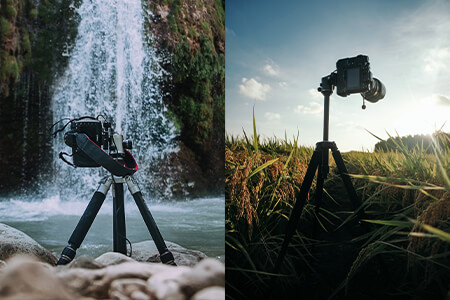
- Video Editing Services
- Virtual Staging Services
- Outsource Photo Editing
- Retouching Tips
- Photo Editing Freebies
- Free Raw Images for Retouching
- Free Photoshop Actions
- Free Lightroom Presets
- Affiliate Program
- Privacy Policy
- Cookie Policy

Best Tripods for Heavy Lenses For 2024
Share this article:
Stability is vital when capturing the perfect photo, and that’s just not possible without a tripod. For those who like to bring out the heavy lenses, not just any tripod will do.
A heavy lens and a cheap, plastic tripod are like oil and vinegar – they do not mix. It’s essential to purchase a tripod that can accommodate the types of photos you want to take and support the heavy camera equipment you want to use.
As you’ll see below, the Manfrotto 190XPro4 Tripod is our favorite model for checking all these boxes. Read on to discover what else we liked as we take a look at the best tripods for heavy lenses.
Our best tripod for heavy lenses At A Glance
- Manfrotto 190XPro4 Tripod
- Benro Rhino Carbon Fibre Three Series Tripod
- Peak Design Travel Tripod
- Neewer Camera Tripod With Rotatable Center Column
- 3 Legged Thing Leo 2.0 Carbon Fiber Ultra-Compact Travel Tripod
The Best Tripods for Heavy Lenses To Buy
1. manfrotto 190xpro4 tripod.
Best overall tripod for heavy lenses
Brand : Manfrotto | Max Load : 22 pounds | Weight : 4.51 pounds | Max Height : 5.75 feet | Material : Aluminum | Leg Sections : 4 | Feet: Pads
Click For Latest Price
The Manfrotto 190XPro4 is a tripod that prides itself on being able to capture any shot you can imagine. The column system can adjust up to 90° from vertical, and the tripod legs can lay almost flat and still support the camera.
The beauty of the Manfrotto 190XPro4 is that you don’t even have to remove your camera before switching orientations. Each tripod leg adjusts and locks independently, and the power lock holds your heavy lenses securely in place.
This ease of setup means it won’t take you much time to line up and capture that perfect photo. The tripod also comes with an easy link connector so you can quickly attach any accessories you may need to enhance your shot.
At less than five pounds, this tripod’s lightweight aluminum doesn’t add a significant amount of weight to your gear. When you’re done with the job, the Manfrotto 190XPro4 holds up flat to maximize portability.
Manfrotto is known to build each of their products to rigid Italian quality standards that go the distance and hold up in any situation.
- 90° column swivel
- Lightweight
- Durable and sturdy design
- Bubble to ensure the tripod is level
- Secure locking feature
- Still bulky when folded up
2. Benro Rhino Carbon Fibre Three Series Tripod
Most robust tripod for heavy lenses
Brand : Benro | Max Load : 44 pounds | Weight : 6 pounds | Max Height : 5.75 feet | Material : Carbon Fiber | Leg Sections : 4 | Feet: Spiked Feet
The Benro Rhino Tripod gets its name from its robust design.
This tripod stands securely with spiked feet that, along with its weight, give it a firm foundation. Thick leg diameters only add to the stability. The carbon fiber material is just one more nod to the durability of this model.
The Benro Rhino stands a respectable 5.75 feet tall at its maximum height. The automatic leg angle adjustment feature makes changing leg angles as easy as pushing a button.
Combining one of the detachable legs with the center column allows for easy conversion from a tripod to a monopod. This allows for further flexibility and mobility.
A reverse folding design makes the Benro Rhino portable enough to carry. However, at just over two feet long when collapsed, it won’t quite fit into most backpacks.
- Strong and robust design
- Good maximum height
- Spiked feet
- Adjustable to monopod
- Less portable than other tripods
- Center column does not pivot
3. Peak Design Travel Tripod
Best compact tripod for heavy lenses
Brand : Peak Design | Max Load : 20 pounds | Weight : Carbon: 2.81 pounds / Aluminum 3.30 pounds | Max Height : 5 feet | Material : Carbon Fiber or Aluminum | Leg Sections: 5 | Feet: Pads
The Peak Design Travel Tripod is the result of four years of careful engineering.
The tripod is lightweight whether you opt for the aluminum or the carbon fiber model, but the carbon fiber model is a good half a pound lighter. This decrease in weight amounts to a hefty price increase, though.
The Peak Design Travel Tripod really shines when it comes to compatibility, folding up nicely to the diameter of a water bottle (and not a whole lot longer than one). This compact size does not compromise the tripod’s other essential features.
When fully extended, the Peak Design stands five feet tall for capturing shots while standing. Furthermore, a camera with a heavy lens is no match for the tripod’s 20-pound weight limit.
This tripod is designed for any environment and is fast to set up and tear down. It has plenty of room for optional accessories and is even compatible with mobile devices.
- Compact and portable design
- Ultra-lightweight
- Phone mount included
- Available in two different materials
- A little on the short side
- Carbon fiber is quite expensive
4. Neewer Camera Tripod with Rotatable Center Column
Best budget tripod for heavy lenses
Brand : Neewer | Max Load : 26.5 pounds | Weight : 4.40 pounds | Max Height : 6.25 feet | Material : Aluminum Alloy | Leg Sections: 3 | Feet: Pads
The Neewer Camera Tripod has many features of a high-end tripod without the hefty price tag. Coming in at an acceptable price range, this Neewer model is something even the most casual photographers can consider.
This tripod can extend all the way to 6.25 feet thanks to its movable center column. When you don’t need the height, the center column can fold down 90° and rotates 360° on its axis for stellar panoramic shots. The ball head also rotates 360° for even more flexibility.
The tripod legs adjust to three different angles for flexible shooting. In addition, the legs can detach for use as a monopod or as alpenstock to get to those tough to reach locations.
Not to be outdone by other models, the Neewer Camera Tripod handles a max load of 26.5 pounds to support your heavy lenses. At less than four and a half pounds, the tripod itself is still light enough to carry around with ease.
- Great price
- 360° rotation feature
- Legs detach to be used as a monopod
- Stands tall at over six feet
- Bubble level
- Aluminum alloy lacks some durability
5. 3 Legged Thing Leo 2.0 Carbon Fiber Ultra-Compact Travel Tripod
Supports the heaviest load
Brand : 3 Legged Thing | Max Load : 66 pounds | Weight : 3.30 pounds | Max Height : 4.5 feet | Material : Carbon Fiber | Leg Sections: 5 | Feet: Pads
Looking a bit like something out of Star Wars, 3 Legged Thing’s Leo 2.0 Travel Tripod has a sleek, futuristic design with thick legs for ultimate support.
Standing straight and true, the 3 Legged Thing supports an insane 66 pounds of weight. Even the heaviest lens can’t compare to that. The legs can adjust to three different angles and still support 22 pounds when they are 80° out from the center.
The carbon fiber frame is one of the most robust lightweight materials out there and is impressive to see on a tripod in this price range. At just over three pounds, it can hold 20 times its own weight.
All three legs are detachable for versatility and can be used as booms. The entire assembly does fold up pretty nicely for its size for portability.
This model is available as a tripod only or for a little more can be purchased as a kit with a ball head and a choice of two colorways.
- Incredible 66-pound maximum load
- Designed to fold down for travel
- Legs are detachable
- Heavy-duty carbon fiber material
- Only extends to 4.5 feet at maximum height
- Clamps can be a pain to tighten
What To Look For When Buying a Tripod for Heavy Lenses
Maximum load.
It goes without saying that you’ll want a tripod that can support the weight of whatever heavy lens(es) you prefer to use. Don’t forget to factor in the weight of your camera when checking out the various tripod models.
Leg Sections and Angles
When buying a tripod for heavy lenses, you’ll want to make sure the legs are robust enough to support your camera setup. Even if the tripod is rated for a solid max load, cheap or thin legs may not stand up to the test of time.
Tripod legs typically come with anywhere between two and five sections. These sections offer the benefits of flexibility and portability by making the tripod that much more collapsable. More segments are usually better, but it can make setup a longer process if the tripod doesn’t have features to accommodate that.
Most tripods have leg angle adjustments to allow for shots at different heights by increasing the angle. It’s also possible to adjust the angle of just one or two legs in order to work your way into tight spaces but still have the leg support you need for stability.
Folded Length
It’s important to think about how you’re going to get your tripod out to the area you want to shoot. Some tripods fold up really nicely for the sake of portability and can even fit into a backpack. These designs usually have legs that fold upwards, which also helps protect the head.
Each of the models on our list comes with a head to attach your camera to. However, some tripods do not. Tripod heads usually range from just a pan-tilt to a full range of movement with a ball head.
Tripods should allow for the removal and replacement of heads as needed for different projects.
Maximum Height
No one wants to be hunched way over while trying to capture that perfect shot. Having a maximum height that accommodates your physical stature can make all the difference, especially when you need to focus for long periods of time.
Tripod Feet
A tripod that tips over isn’t helping anyone. Tripod feet play a huge role in keeping a tripod upright and stable.
Rubber feet work great indoors on carpet, wood, and tile but can also function to some extent in nature. Spiked feet are best at gripping softer soil outdoors and providing extra stability.
Center Column
A center column can add some serious height to your tripod but can raise the center of gravity. Models like the Manfrotto 190XPro4 have a rotating center column that can be used to capture photos at many different angles.
Aluminum and carbon fiber are the two most common tripod materials out there. They each have their pros and cons.
Aluminum is a cheaper material but is known to weigh more. On the other hand, carbon fiber weighs less but is more durable and is better equipped to handle vibration. There can be a considerable price difference between the two materials, as seen on the Peak Design Travel Tripod.
Is a heavier tripod better?
An interesting question, one that depends on the scenario you’re using the tripod in. A heavier tripod means more weight to carry, and that weight often factors into a bulkier design. This can make a tripod difficult to manage or travel with.
Having a tripod with more weight can be a huge benefit. However, more weight means a lower center of gravity, which amounts to more stability and better quality shots. Heavier tripods also hold up better in poor weather and can save your rig from falling over or worse.
For all-around camera and tripod usage, the Manfrotto 190XPro4 stands out as a clear winner.
Although an aluminum material, it supports up to 22-pounds of weight which is more than enough to accommodate most camera and heavy lens combinations. Some tripods can handle more weight, but those lead to unnecessary bulkiness.
The Manfrotto 190XPro4 has an insane amount of flexibility and range with its leg angles and rotatable center column. If you can dream up a shot, it’s likely that this tripod can adjust to capture it.
With a maximum height of nearly six feet, there shouldn’t be much stooping going on while capturing great photos. Rubber feet hold nicely to hard surfaces but do well in outdoor environments as well.
This tripod is easy to set up, tear down, and collapse well enough to not be too awkward to take with you.
If the Manfrotto 190XPro4 doesn’t float your boat, one of the other tripods on this list will likely accommodate your needs.
About Noah Zelvis
Noah is a content writer who has had a love of all things astronomy for as long as he can remember. When not reaching for the stars, you’ll likely find Noah traveling or running.

The Best Tripods for DSLR Cameras
T o unleash the full potential of your DSLR camera, you need the right equipment. A well-chosen tripod is an indispensable tool that offers stability, precision, and versatility. From lightweight options for travelers to durable professional-grade models, there’s a DSLR tripod for everyone.
When buying a tripod for a DSLR camera, there are a few things you must prioritize. Along with the camera, lenses and accessories can also be bulky. Therefore, the load capacity of the tripod is a primary concern. Weight and portability are also essential factors, especially if you are a traveler or mobile photographer.
Let’s look at some of the best tripods for DSLR cameras available today.
Our Preferred Tripods for DSLR Cameras in 2023
Vanguard alta pro 2+ 263ap, joby gorillapod slr zoom, benro system goplus travel fgp18a, gitzo gt3542 series 3, sirui w-2204, manfrotto 190 aluminum 4-section, really right stuff tvc-24l series 2 mk2.
Enhanced Creativity and Convenience for DSLRs
The Vanguard Alta Pro 2+ 263AP tripod is a robust and versatile option for DSLR camera users. It offers secure support for heavy DSLRs, lenses, and accessories, while its innovative design allows photographers to effortlessly position their cameras from unique angles, enabling them to explore creative compositions and capture stunning shots.
- Non-slip TPU grips and angled rubber feet
- Maximum extended height of 69 inches
- Suspension Loop for counterweights
- Alta SF Spiked Feet compatible
- Limited load capacity
The 263AP model of the Alta Pro 2+ is one of the latest tripods in Vanguard’s Alta Pro range that meets the requirements of DSLR users. With its robust aluminum construction and 11lb load capacity, it can securely hold most DSLRs along with your lens and other accessories.
The Alta Pro 2+ also offers DSLR versatile camera positioning options. The Multi-Angle Center Column System allows you to adjust from -90 to +90 degrees with 15-degree stops. This feature lets photographers capture shots from unique perspectives and explore different compositions. You can also adapt the tripod to any terrain. Its leg angle selector offers 20, 40, 60, and 80 degrees for optimal stability.
The Alta PH-32 3-way fluid panhead offers ergonomic precision and enhanced control with two telescopic handles. One enables smooth 360-degree panning, while the other provides a -30 to +90-degree tilt range for versatility. It also incorporates a bubble level for precise alignment and is equipped with an Arca-type quick-release system featuring a safety pin and a QS-60 V2 quick shoe for convenient camera attachment.
Affordability and Convenience
You'll achieve stable and creative shots with the Joby GorillaPod SLR Zoom Kit. Its flexible legs allow you to position the tripod securely on various surfaces for convenience and unique shooting possibilities. It's also lightweight and easily packed, making it a great choice for traveling DSLR enthusiasts.
- Easily packed
- Lightweight yet sturdy
- Outstanding grip
- No height adjustment
For a lightweight and portable option that comes with an affordable price tag, the Joby GorillaPod SLR Zoom Kit is an excellent choice. It’s easily packed and can support a DSLR camera and lens up to 6.6lbs in weight. With over two dozen flexible TPE leg joints, it’s strong enough to hold a telephoto lens, and you can bend the legs into any position. With the convenience of tree branches, fence posts, or railings as stable support options, you'll never experience a shaky shot.
The GorillaPod SLR Zoom Tripod and Ballhead Bundle offer you easy maneuverability and precise positioning with 360-degree panning. Switching between landscape and portrait modes is simple and fast while fine-tuning your compositions is a cinch. You can also swap mounting options easily with the quick-release plate and its standard ¼-inch 20 tripod mount and â -inch adapter.
Mighty Macro Moments
The Benro System GoPlus Travel tripod (FGP18A model) is an excellent companion for DSLR photographers looking to excel in macro photography. Its ability to achieve low-angle shots and provide versatile positioning options enables photographers to precisely capture the delicate nuances and intricate features of small subjects.
- High quality padded tripod carry case
- Can use one leg as a monopod
- Maximum height of 65 inches
- 180-degree center column
- Spiked feet included
- Ball head not included
The Benro System GoPlus Travel tripod (FGP18A model) is a durable and stable choice for DSLR users. It features robust, sturdy aluminum tubing and incorporates machined aluminum and magnesium alloy components. These ingredients give the tripod a good balance of strength and weight. Additionally, with its impressive 30.9lbs load capacity, it can handle professional-level DSLRs, telephoto lenses, and heavy accessories.
The 180-degree center column provides extensive positioning options. These include vertical, horizontal, and inverted positions. This flexibility lets you shoot at low angles, perfect for capturing macro subjects. You can achieve unique ground-level perspectives without straining yourself or your gear.
The quick leg-lock system improves stability and allows for rapid setup and adjustments compared to traditional mechanisms. This system is also resistant to dust and debris that can interfere with the smooth operation of the locks. The tripod's innovative design also lets you fold the legs in the opposite direction, wrapping around the center column. This design makes it more transportable and ensures you can easily take it wherever your DSLR adventures take you.
Triumphant Telephoto-Lens Handling
The Gitzo GT3542 Mountaineer Series 3 tripod is a first-rate and premium choice for DSLR photographers using telephoto lenses. With its revolutionary Carbon Exact tubes that offer exceptional stiffness and stability, this tripod provides the ideal support for capturing sharp and clear images, even with heavy lenses up to 400mm. Its innovative design ensures reliability and precision, making it a top choice for professional photographers seeking optimal performance in long-range DSLR photography.
- Rapid center column is easily removed
- Reversible column
- Removable feet
- Carbon eXact tubes
- No head included
- Very expensive
The Gitzo GT3542 Mountaineer Series 3 tripod is built for stability. Revolutionary Carbon Exact tubes with optimized fiber composition, including High Modulus carbon fiber in narrower sections, enhance stiffness to maximize rigidity and image stability.
It’s a premium choice for advanced DSLR amateurs and professionals and ideal for bulky telephoto lenses up to 400mm. It has an impressive load capacity of 55lbs, weighs just 4lbs, and extends to a maximum of 64 inches. This tripod can take even the biggest DSLR and is as stiff as a vault door, yet it’s also lightweight and folds down to a compact 21 inches, making it a first-rate choice for trailblazing DSLR photographers.
This redesigned Mountaineer model offers enhanced rigidity on its predecessors. Its four-section legs are secure and protected from debris thanks to its G-Lock Ultra twist locks and O-Ring seal. The redesigned top spider evenly distributes weight, and the column lock fixes the center column firmly in place. Additionally, the large selectors and integrated springs allow you to adjust the leg angles to 23, 55, or 83 degrees with speed, and you can increase stability further by adding weight to the stabilizer hook.
The Ideal DSLR Tripod for All-Weather Photography
The Sirui w-2204 is a lightweight, robust carbon-fiber tripod with exceptional stability and a waterproof design. With its reliable construction and ability to repel water, it is an ideal choice for DSLR photographers seeking a versatile and durable tripod that can handle challenging conditions.
- Cold weather grips
- Transport bag with strap
- Second mounting plate for monopod
- Bubble level
- Compatible with any standard head
Of the four tripods available in this range, the Sirui w-2204 is the larger carbon-fiber model. Despite weighing only 3.7lbs, this tripod offers robust and solid construction. Yet, it doesn’t budge in howling winds, has a load capacity of nearly 40lbs, and can reach dizzying heights of almost 71 inches. Your DSLR, bulky lenses, and any accessories are perfectly secure on this excellent tripod.
The twist locks on the legs need some familiarization, and it's essential to ensure you tighten them properly to prevent slipping. Yet, once secure, they provide a stable and reliable grip. Furthermore, the tripod utilizes a ratchet-lock system for securing the legs at different angles. It combines a manual lever and a spring-loaded lock for added security and ease of use. This combination allows for quick and straightforward one-handed releases while ensuring a secure and stable setup. There’s also a stabilization hook in the center column, and you can change out the rubber feet for the included steel spikes for added traction.
It’s also one of the few waterproof tripods on the market. It’s protected in various aquatic environments, including shallow water, inclement weather, near waterfalls, or on boats exposed to sea spray. However, you should exercise caution with prolonged exposure to salt water, and submerging the tripod is not recommended.
Entry-Level Versatility and Convenience
The Manfrotto 190 Aluminum 4-Section tripod is an excellent choice for those seeking an entry-level option that offers exceptional value. Its compact size, ease of transportation, and user-friendly features provide a reliable and versatile solution for photographers looking to explore tripod versatility.
- Easy to use
- Aesthetically pleasing
- Convenient Quick Power Lock System
- Rotating bubble level
- Horizontal column positioning
Manfrotto has always been about good value, and its 190 series of tripods offer exactly that. The Manfrotto 190 Aluminum 4-Section is one of the best in the series and is a great entry-level option thanks to its ease of use. It has a load capacity of 15.4lbs and reaches a maximum height of 63 inches. Despite this capacity, it can still take a bulky DSLR and a telephoto lens up to 300mm. It’s also very compact when folded down. Its folded length of 19.2 inches and its 4.6lbs of weight make it relatively easy to transport and carry.
The MT190 tripods have a spring-loaded lever for quick adjustment of leg angles. In addition, the QPL leg locks minimize noise and vibration when opening and closing them. This feature allows for efficient and discreet adjustments to the tripod's height and leg positioning. They also enable the simultaneous opening and closing of all locks for convenience and efficiency.
The Manfrotto 190 Aluminum 4-Section tripod offers versatile functionality with its rapid center column that you can position horizontally using Manfrotto's 90-degree Column feature. It allows for close-to-the-ground macro work and the attachment of flexible arms for holding lights or reflectors. The tripod also includes rubber leg warmers and a rotating bubble level.
A Terrific Tripod for Travelers
The RRS TVC-24L Series 2 Mark II is a premium carbon-fiber tripod that combines compactness and a lightweight design, making it an excellent choice for travel photographers. Its portability and durability make it a reliable companion for capturing memorable moments when taking your DSLR on faraway adventures.
- Very sturdy
- Excellent build quality
- Compact and lightweight
The RRS TVC-24L Series 2 Mark II is a premium, carbon fiber, 4-leg section tripod. It’s relatively small and only reaches a maximum height of about 50 inches. Yet, it folds down to a more compact size than larger tripods, and with a weight of just 3.4lbs, it’s a good travel option. However, the center column is missing to facilitate weight reduction and improve stability. You do have the choice to add one, which you need to purchase separately. However, despite the absence of a center column, it has an impressive load capacity of 40lbs, making it suitable for DSLRs, large lenses, and heavy accessories.
It’s an unassuming piece of equipment and offers a simple user experience. However, its larger-than-normal tubes provide excellent stiffness, while meticulous attention to detail in construction results in superior usability and durability. These include smooth edges, precise fitting of parts, and anodization enhancing the aluminum. It also boasts top-tier twist lock leg mechanisms that offer a satisfying feel and secure locking with a quick turn. Furthermore, the mechanisms feature a rubber gasket to keep out dirt and water.
What You Should Consider Before Buying a Tripod for a DSLR in 2023
Load capacity is one of the most important things to consider. Most tripods, especially professional-grade ones, will easily cover the weight of a bulky DSLR, a substantial telephoto lens, and other accessories, like an external flash. Of course, like any tripod, you need to consider other factors when searching for the right one for you.
Research how stable the tripod is. Its weight and ease of portability are also significant. Sturdy construction is essential because it is, after all, supporting some expensive equipment. Think about the versatility of the leg locks and how high you can extend the center column. Or you may even have an interest in how low it can go. This aspect is crucial if you like to delve into the world of macro photography. The Benro System GoPlus Travel FGP18A tripod is an excellent choice for getting down to ground level. However, another consideration is price. If you’re on a budget, you won’t want to splash out on a premium tripod. In that case, you could consider something like the JOBY GorillaPod SLR Zoom. It’s a sturdy tripod, perfect for travelers, and it won’t cost a pretty penny.
However, another tripod suitable for DSLRs that comes at a decent price point is the Vanguard Alta Pro 2+ 263AP. It checks most of the boxes that need checking and offers excellent value for such a revered tripod. But you will need to consider its maximum load capacity. If everything adds up, it’s a top-notch choice.
This article may contain affiliate links that Microsoft and/or the publisher may receive a commission from if you buy a product or service through those links.
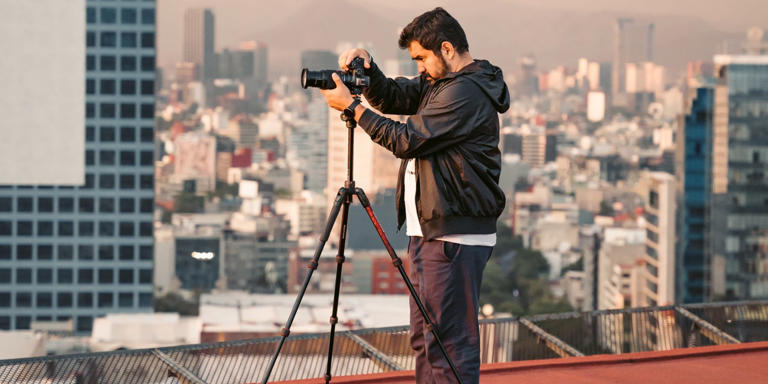
- Moscow Tourism
- Moscow Hotels
- Moscow Bed and Breakfast
- Moscow Vacation Rentals
- Flights to Moscow
- Moscow Restaurants
- Things to Do in Moscow
- Moscow Travel Forum
- Moscow Photos
- All Moscow Hotels
- Moscow Hotel Deals
- Things to Do
- Restaurants
- Vacation Rentals
- Travel Stories
- Rental Cars
- Add a Place
- Travel Forum
- Travelers' Choice
- Help Center
Tripods for solo travel photos - Moscow Forum
- Europe
- Russia
- Central Russia
- Moscow
Tripods for solo travel photos
- United States Forums
- Europe Forums
- Canada Forums
- Asia Forums
- Central America Forums
- Africa Forums
- Caribbean Forums
- Mexico Forums
- South Pacific Forums
- South America Forums
- Middle East Forums
- Honeymoons and Romance
- Business Travel
- Train Travel
- Traveling With Disabilities
- Tripadvisor Support
- Solo Travel
- Bargain Travel
- Timeshares / Vacation Rentals
- Central Russia forums
- Moscow forum

// at popular tourist locations such as red square, st.basil cathedral, et.
This topic has been closed to new posts due to inactivity.
- SIM card. Russian SIM cards, do they still work in the UK? 3:07 pm
- Train Booking Moscow to St. Peter Mar 29, 2024
- Union Pay debit card Mar 27, 2024
- Russian trying to book a hotel in Jerusalem Mar 14, 2024
- Dual Citizen Arrested in Russia Mar 12, 2024
- about clothes Feb 27, 2024
- NOTE - border crossing from Finland into Russia closed Feb 09, 2024
- Snow boots in Red Square Feb 04, 2024
- Travelling to Moscow & Murmansk with toddle in winter Feb 02, 2024
- Anyone traveling from London to Moscow this week ? Jan 27, 2024
- Booking accommodation Jan 11, 2024
- Traveling friends (Designers preferred) :) Jan 05, 2024
- Are shops and things closed during Christmas and New Week ? Dec 15, 2023
- Traveling to Eastern Russia Nov 17, 2023
- Moscow to St Petersburg train or air?? 32 replies
- New Sapsan Express Train from Moscow to St Petersburg 18 replies
- New year's in moscow 8 replies
- Hop on Hop Off Bus Tour 5 replies
- How do you purchase Bolshoi Ballet tickets at a great price? 2 replies
- Select-a-room.com Are they legitimate? 3 replies
- Weather Moscow and St. petersburg in May 8 replies
- Night train to St Petersburg 3 replies
- ATM Access 12 replies
- Visa needed if on layover at Moscow Airport??????? 15 replies
- Where can I get initial answers to ANY question?
- Moscow Tourism
- Moscow Hotels
- Bed and Breakfast Moscow
- Moscow Holiday Rentals
- Flights to Moscow
- Moscow Restaurants
- Moscow Attractions
- Moscow Travel Forum
- Moscow Photos
- All Moscow Hotels
- Moscow Hotel Deals
- Things to Do
- Restaurants
- Holiday Rentals
- Travel Stories
- Add a Place
- Travel Forum
- Travellers' Choice
- Help Centre
Tripods for solo travel photos - Moscow Forum
- Europe
- Russia
- Central Russia
- Moscow
Tripods for solo travel photos
- United Kingdom Forums
- United States Forums
- Europe Forums
- Canada Forums
- Asia Forums
- Central America Forums
- Africa Forums
- Caribbean Forums
- Mexico Forums
- South Pacific Forums
- South America Forums
- Middle East Forums
- Honeymoons and Romance
- Business Travel
- Train Travel
- Traveling With Disabilities
- Tripadvisor Support
- Solo Travel
- Bargain Travel
- Timeshares / Holiday Rentals
- Central Russia forums
- Moscow forum

// at popular tourist locations such as red square, st.basil cathedral, et.
This topic has been closed to new posts due to inactivity.
- SIM card. Russian SIM cards, do they still work in the UK? 20:07
- Train Booking Moscow to St. Peter 29 March 2024
- Union Pay debit card 27 March 2024
- Russian trying to book a hotel in Jerusalem 14 March 2024
- Dual Citizen Arrested in Russia 12 March 2024
- about clothes 27 February 2024
- NOTE - border crossing from Finland into Russia closed 09 February 2024
- Snow boots in Red Square 04 February 2024
- Travelling to Moscow & Murmansk with toddle in winter 02 February 2024
- Anyone traveling from London to Moscow this week ? 27 January 2024
- Booking accommodation 11 January 2024
- Traveling friends (Designers preferred) :) 05 January 2024
- Are shops and things closed during Christmas and New Week ? 15 December 2023
- Traveling to Eastern Russia 17 November 2023
- Moscow to St Petersburg train or air?? 32 replies
- How do you purchase Bolshoi Ballet tickets at a great price? 2 replies
- Just Go Russia Tour Company 43 replies
- Moscow 2013 World Athletics 5 replies
- 3 days in Moscow - Where to stay and what to do? 7 replies
- The Sleeper Train St Petersburg > Moscow 13 replies
- Select-a-room.com Are they legitimate? 3 replies
- New Sapsan Express Train from Moscow to St Petersburg 18 replies
- Best area to stay in Moscow 29 replies
- Moscow New Years Eve for 2011/2012 6 replies
- Where can I get initial answers to ANY question?
- Making web photographs
- about.alfredklomp.com
- photo.alfredklomp.com
- www.alfredklomp.com
Articles, essays, misc
- Collector's books
- Russian fakes
- Guide to flea markets
- Goirle and Krasnogorsk
- Introduction to the Soviet system
- Introduction to KMZ
- My beef with LOMOgraphy
- Russian factory logos
- Moscow 1980 olympic models
- Rangefinder adjustment
- Film scanner?
- British importer TOE
- Strange combos
- Some production figures
- Homebuilt panoramic camera
Non-Russian
- ActionSampler
- Agfa Optima 1535
- Bilora Bella
- Carl Zeiss Werramatic | samples
- Diana toy camera
- Ikoflex-IIa
- Nippon AR-4392FH
- Voigtländer Bessa-L | samples
- Nikon F50 | repair
- Yashica-635
- Yashica Electro 35
- Radioactive FEDs?
- LOMO Lubitel-2 | manual
- LOMO Lubitel-166U | manual
- LOMO Voskhod
Zenit series
- FS-12 | manual
- Fotokomplekt
- Zenit-E | parts | repair | manual
- Zenit-EM | manual
- Zenit-TTL | manual
- Zenit brochure
Zorki series
- Zorki-S | repair | repair (2)
Misc Russian
- Horizon-202 | samples
- Horizont manual
- Siluet Elektro manual | dutch
- Shkolnik manual
- Smena 8M | manual
- Smena SL | manual
- Start | snaiper
- Universal viewfinder
- Leitz VIOOH viewfinder
Light meters
- Leningrad-7 | manual
- Leningrad-8 manual
- Sverdlovsk-4 | manual
The Zeiss Ikon Ikoflex IIa
This page is no longer actively maintained. ( Pardon? )
I would have probably never bothered with this camera if I hadn't inherited it from an uncle. If you've read some of my other TLR (twin lens reflex) articles, you'll know that I'm not a big fan of TLRs, mainly because of their impossible viewfinder system with the reversed image and their fairly limited system possibilities. But that's just my taste in cameras. Other photographers have learned to love the viewfinder system and the all-in-one functionality, and why let my personal preferences get in the way of a good review?
History of the Ikoflex
I don't know a lot about Zeiss, and especially not about the Ikoflex, so I'm going to keep this section short and not pretend to know things I don't. You can find the complete story at numerous other web sources; see the links at the bottom of this page.
Zeiss Ikon made the Ikoflex series of TLRs between the early 1930's till the late 1950's in various models and classes. The idea seemed to be that Zeiss Ikon wanted to compete with Franke & Heidecke's Rolleicord. If you look at the shared features of the Rolleicords and the Ikoflex IIa, their functional similarity is obvious. The Rolleicord had a 75mm f/3.5 Xenar lens; the IIa had an 75mm f/3.5 Tessar. The Rolleicord didn't have a self timer; neither did the IIa. The Rolleicord had knob wind instead of the Rolleiflex's crank; so did the IIa. The Rolleicord didn't have a self-cocking shutter, neither did the IIa. And so on. If I owned a Rolleicord I'd put the cameras back to back and organise a shootout, but since I don't, I'm going to have to drop further investigation.
Pity for Zeiss, but they never really succeeded in pushing Rollei off the market. And that's by a long shot. I blame it on Zeiss not getting all the details as right as professional photographers wanted them to be, but for the casual user, that shouldn't be a deal breaker.
A closer look
If you take the Ikoflex IIa in your hands, you notice that it's fairly small. It beats my Yashica-635 in terms of width, height and length. When put next to a Lubitel-2 , both have appproximately the same length and width, but the IIa is much taller. For 35mm you'd call this a big camera, but for 6x6 it's definitely small. That means it's very portable, and if you have an ever-ready case for it, you can wear it around your neck reporter-style without problem.
If you become familiar with the IIa, you'll notice that it's a somewhat unimaginative camera. Oh, it's built like a tank and its quality is out of the question, but the design, the controls, the enormous strips of leatherette, they all make this camera sort of boring. Look at the focusing knob for instance. It's just a big flat round knob with knurled edges, a focusing range, a screw in the middle, and lots of leatherette. Oh, it's a very good boring knob, one of the best boring knobs I've ever seen, but it's totally uninspiring and nothing more than purely functional. That goes for all of the knobs, for the lens assembly, and for the whole camera for that matter. This camera was designed by a structural engineer behind a drawing board who had more eye for function than for flair. Some niceties were thrown in here and there to make it more palatable; for instance the Zeiss Ikon symbol on the viewfinder hood or the decidedly strange U-shaped rim around the taking lens, but it's all not as persuasive as the stylish design of the Rolleicord.
This camera is very well built. Everything is metal, the finishing is excellent, and you can feel that it was put together by skilled technicians. But is it rugged? Probably it is, but the black paint and the simplistic design don't betray it. This is a camera that screams "caring amateur use". This in contrast to the Rolleicords, that always had an image of being very tough. Combine that with their greater appeal, and you have the world's preference towards them.
The viewing lens is a Teronar 75mm f/3,5; the taking lens is a Zeiss Opton Tessar 75mm f/3,5 in a Compur-Rapid shutter with a range of 1s–1/500s + B. This is for my camera; your mileage may vary. I've never heard about the Teronar (it's just the viewing lens anyway), but the Tessar is, of course, a very famous design with numerous outstanding properties. This one is T coated, so not your average four lenser – which probably explains the IIa's enduring popularity as a user camera.
I haven't shot film so far with my Ikoflex (but am planning to), so the bit where I relate about image quality is on hold.
The shutter
The shutter may be the trickiest part of this camera. There are a number of things you need to be aware of before using it. First, never set the shutter speed with a cocked shutter. At least, that seems to be the rule. I read on the Internet somewhere that you can over-strain the spring for 1/500s if you cock your shutter first and then set speeds. At first I didn't even know the IIa had 1/500s, because the figure is so far off the scale that you have to move the shutter speed lever unnaturally far to reach it, so the story about the separate spring is probably true. Second, the shutter will only fire under the right circumstances. It will refuse duty when the shutter is uncocked, or the viewfinder hood is down (physically blocking the exposure button's motion), or the film hasn't been advanced since the last exposure, or you've passed 12 exposures. In practice all this means that it's hard to go wrong with this camera, but also that it's not very intuitive to use. You can't just press the release button and expect it to fire.
The most counter-intuitive feature to understand is the way the shutter reacts when you've passed 12 exposures. Namely, it just blocks and does nothing until you press in the exposure counter with your thumb and rotate it counterclockwise until you reach "1". Then the dial clicks in and the camera is ready for use again. If you don't press in and rotate the counter, it will keep on rotating across the scale forever and ever without clicking in. A nice feature of the blocking mechanism is that it shows a white flag in a window just behind the shutter release when the shutter is blocked, and a red one when it isn't. If you then cock the shutter, you're set to take pictures.
There are three control levers sticking outside the shutter assembly: one is for the aperture, another is for the shutter speed, and the third is to cock the shutter. The aperture and the shutter speed are read out on the "shoulders" of the U-shaped rim around the taking lens.
The big round focusing knob is on the left of the camera, which is a bit impractical at first, but leaves the right hand for picture taking and transporting. The distance scale runs from infinity to 1m, with close-up kits available. The shutter release button is on the upper right hand corner, in a bit of a strange spot from an ergonomic point of view. Much better would have been to place it on the bottom right, like on the Rolleiflex. The film wind knob is on the top back right of the camera, and is pleasant in size and texture. Also on the right is a large X contact (or is it M?). The left of the camera is home to the focusing knob and to two small retractable knobs that are connected to the film spool spindles. Retract them to free the spools and take them out. On the top back of the camera is a round sliding knob that opens the hinged back. On the bottom of the camera is a tripod mount (large German brush, 3/4") and a rudimentary red window with flimsy metal cover plate, that you only use when loading film.
The viewfinder
On top of the camera we find the viewfinder. It's the usual chimney type with metal latches on all sides that collapses to a small package. The whole assembly appears to be attached to the body by only three screws, so perhaps it was removable and could be replaced by a prisma viewfinder. Some investigation shows that prisma finders were indeed available. In collapsed state, you open the viewfinder by sliding a spring-loaded latch on its back to the left. When the viewfinder is open, you can access the magnifying glass by first flipping open the sports viewfinder with the magnifying glass behind it, and then flipping back the metal viewfinder frame. The magnifying glass is best used from a distance, because the enlargement factor is larger. Without glasses, it's possible to oversee the entire image with your eye pressed to the magnifying glass, though it will appear so large that you don't have overview. If you can't afford to look into the waist-level finder, you can flip up the frame on the front and use it as a sports viewfinder. Pity that the ground glass is obscured by the flipped-up frame, so you can't double-check anything quickly. The ground glass itself is a fresnel lens, and fairly dim for today's standards. Don't forget however that fifty years ago they didn't have very sensitive films, so this camera's field of use wouldn't have been low light situations in the first place.
A very nice, but probably uncommon, feature on my camera is the German exposure table to one side of the viewfinder. My uncle, this camera's first owner, bought it either in Germany or Austria, and it seems likely that only cameras sold in those countries were sold with these particular tables. On it you can find rubricised exposure info for 40 ASA film, and some rules of thumb, like the underlined "when strongly overcast, fourfold exposure". This camera dates from the early 1950's when light meters were fairly uncommon, so such a table had its uses.
Loading film
When loading film, make sure that you have an empty spool in the film bay. I once took this camera out on a photographic excursion, only to discover on location that I'd forgotten the extra spool. That's what you get when you only shoot 35mm! As a result I've never actually loaded this camera, so maybe I'm forgetting something, but this is how I think it works. Place a film in the lower film bay by lifting out and locking the knob with spindle. Thread the film into the empty spool in the top bay. Close the camera. While looking through the red window in the base plate, wind the film on to exposure number one. When arrived, rotate the film counter counterclockwise with your thumb to position 1 till it clicks – and you're set. Then take pictures, and enjoy this no-nonsense machine with its high-end lens.
Last modified: Aug 12, 2006

- Search forums
- Native Lenses
Lens advice for Moscow on a budget?
- Thread starter sjducks
- Start date May 10, 2012
Mu-43 Rookie
- May 10, 2012
Sorry for another "what lens" post, but I figured that there are many people who have been in similar situations that can help. I'm leaving for Moscow in the middle of June and am interested in adding a lens to my m43 kit. My gear is still a work in progress, but I have an E-P2 and E-PM1, with the II R kit lens and the Sigma 19mm 2.8. I would like to add another lens to take along with my as I'll be taking photos all over indoors/outdoors, daytime/low light. I am however on a budget and really do not want to spend an excessive amount on this lens. I am interested in the Oly 45, but am not really going to be taking any portraits while there (or elsewhere for that matter). Maybe squeeze in a P14 for the wide angle? Any advice would be fantastic. Thanks much!
forgot to mention that I am looking more for native glass if possible. I also have an OM Zuiko 50/1.8, although I am not sure if it will make the trip with me. Thanks again.
Mu-43 Veteran
p20/1.7 - best choice
Mu-43 Hall of Famer
Both of those focal lengths are covered by your kit zoom, so you should be able to figure out which one you use more - wide-angle or short tele? Or are you generally 'stuck in the middle'? My personal preference would be something wide (particularly indoors and urban shooting), so the obvious budget option would be the 14/2.5. The 12, while expensive (and thus probably out of the question) would actually give you something very different in terms of field of view (extra mm on the wide-angle side mean more than on the tele end). Or even the 9-18 ultra wide zoom, although not everyone likes ultrawides equally. I enjoy them from time to time (I have a 17-40 on my full frame), but 24 is usually wide enough for me.
Mu-43 Regular
I visited Moscow just the other week and would definitely recommend a tele zoom as well. When walking around you will want to zoom in on the wonderful buildings and architectural details, and the 45 (good as it is) will not bring you close enough in my opinion. I shot most of my pictures last week with either a wide angle (I used the 9-18 Oly lens) or tele (the Oly 40-150). Since you mention you do not want to spend too much and maybe only want to add one lens I would suggest the 40-150 in your case, not too expensive and very versatile. Combined with your kit lens you will have a light and small but very usable combo that will give you a lot of picture opportunities. If you can stretch the budget think about the 9-18 as well though, great for interiors! https://www.mu-43.com/f56/moscow-color-b-w-25585/ To give you some idea, most outdoor pictures in my Moscow thread (above) were shot with 40-150, most indoor shots with 9-18 Regardless of your choice, you will have a great time there, wonderful city for a photo trip!
My wife and I went to London, UK, last summer. She was there for two weeks before I got there, and she took along her E-PL1, m.14-42 (mk. I) kit, and the m.40-150. She never complained about any restrictions, with the exception that 14mm wasn't wide enough for a very few architecture shots. I brought my old E-620, 11-22mm and 50mm f/2. It would get to be too much weight for a 10-12 hour day of walking around. I envied the little E-PL1. I would say that if your goal is to enjoy Moscow, and not to earn a profit off your shots, then get the m.40-150mm, a few extra batteries, and a few extra SD cards. It's a very sharp lens for the price, and extra batteries and SD cards are more important than another stop of light.
Just this guy...
Since you don't have a strong idea of what you want I'd go along with the others suggesting the 40-150. It gives you a good general purpose kit. The two zooms and faster normal on two bodies will be very versatile on a tight budget. Fred
Moscow lens Since you already have Oly cameras, I can recommend the 14-150 zoom. Compact, wide range, good quality (no equal to the primes, but plenty good enough). Just traveled to New Zealand and used this lens most of the time. It's $499 at Amazon, perhaps out of your budget but worth a look.
Mu-43 All-Pro
Save your money for your trip. Since you have no idea what you want, it would suggest you don't need a lens at all.
Wide. Wide. Wide. There are many very interesting interiors in Russia. The chapels inside St. Basil's for example. IMHO it takes 24mm equivalent or better to shoot an interior and give an adequate sense of space. My "travel wide" is the 9-18. (Church of the Savior on Spilled Blood in St. Petersburg is another photogenic interior. Don't miss it if you get that far.) Those photogenic interiors are usually pretty dim. I suggest a 5 or 6 section carbon monopod that collapses to around 16" Put a Velbon QHD-41Q or one of the Manfrotto ball heads with the QR2 system on your monopod and you will be a happy low-light shooter. IMHO you have enough longer lenses unless you are a birder.
either kit zoom or 9-18mm
lenshoarder
I would pickup a M39 adapter and buy old Soviet glass while there.
Thanks for all the suggestions fellas, much appreciated! Keep em coming.
Keep em coming. Click to expand...
oldracer said: One more re budget: You could buy a 9-18mm for the trip and sell it when you get home. Click to expand...
I actually have the same dilemma for Italy next year. The Oly 12,f2.0 is way out of my budget. I was probably going to buy the Pany 14,2.5. At < $300. I looked at the Sigma 19,f 2.8, but I didn't think the reviews were overwhelming. I have the EPL1. Type I. Kit lens, and the 40-150 tele-zoom ( love that lens ). I also have the Holga lens ( I actually like this one alot ). So, judging by the responses here, the Pany is the way to go. Thanks.
I am leaning a little more towards wide angle than zoom although the prices for the 40-150mm olympus are pretty cheap now (same goes for the 14mm panasonic). BAKatz, I'm with you...I'd love to get the Oly 12, but it's out of my range as well.
You can always take multiple images and stitch them together rather than buying a wide. I often do handheld panos. The gridded display is very helpful in taking the series.
Similar threads
- Jan 30, 2024
- Feb 1, 2024
- AjaxManifesto
- Jan 4, 2024
- Dec 26, 2023
- Feb 3, 2024
- Panasonic Cameras
Latest threads
- Started by riprof99
- Today at 6:56 PM
- Started by dicky109
- Today at 6:24 PM
- Started by hoodlum
- Yesterday at 2:28 PM
- Started by Aristophanes
- Yesterday at 1:38 PM
- Started by Carpy
- Yesterday at 9:19 AM
- Started by Hayath
- Yesterday at 5:59 AM
- Started by quatchi
- Yesterday at 4:32 AM
- Started by Robert Davidson
- Yesterday at 3:57 AM
- Started by MichaelSewell
- Friday at 3:52 PM
- Replies: 10
- Started by Michael Houston
- Friday at 3:03 PM

IMAGES
VIDEO
COMMENTS
5-section legs - setup time. -. Small pan axis knob. The Benro Rhino FRHN05CVX20 is the smallest of Benro's four new Rhino travel tripods, but we found that it's remarkably stiff for such a compact tripod - and Benro's new VX ball heads and their secondary pan axis just under the camera plate are a triumph.
Learn about about some of the top tripods best suited for your travel photography needs. ... I'm 6'1", need it for hikes/landscapes, and use an A7Riv & A7Riii but sometimes with long lenses (70-200 f/4, 100-400). I know I'm tall, but with flip-out screen of the Sonys, I'm more concerned about the weight of the tripod+head than ...
Legs can be positioned at multiple locking angles or splayed close to the ground for low-angle or close-up travel photography. Weight: 8/10. At 1.5kg / 3.4 lb, the Punks Corey is a lightweight travel tripod for photographers who prefer to travel carry-on only. Its size/weight make it ideal as a backpacking tripod.
Sirui AM124 Carbon Fiber Tripod. $179 at Amazon. Read more. Show more. The Expert: I'm a freelance travel writer and editor who focuses primarily on adventure travel, which means I often take ...
The minimum height of only 3.5 inches (9 cm) is fine for macro work. The tripod weighs only 4.27 lbs (1.94 kg), making it the most lightweight heavy-duty tripod in Gitzo's Series 3 lineup. It has a good load limit of 55 lbs (25 kg) and folds down to 21.6 inches (55 cm). The GT3543LS Series 3 doesn't include a head.
The Feisol CT-3442 is the perfect definition of a super lightweight, heavy-duty tripod. It offers the optimum balance of quality, weight, folded length, load capacity, strength, and price. This is the tripod we recommend to travel bloggers and adventure photographers who shoot with heavy lenses and DSLRs.
Use the links to jump to our full write-ups for more in-depth coverage. Best overall. 1. 3 Legged Thing Punks Brian 2.0. View at Amazon. View at Walmart. View at BHPhoto. The best travel tripod ...
Best for Landscape Photography. Manfrotto Element Traveler Tripod Kit With Ball Head. Lightweight and compact for easy travel. High-quality build, reliable stability. 360-degree panoramic head for versatile shots. Quick-release plate for fast setup. Maximum height of 1.47 m for tall subjects.
1. 3 Legged Thing Winston 2.0 Carbon Fiber Tripod with Ball Head. The 3 Legged Thing Winston 2.0 heavy duty camera tripod is one of the most stable heavy-duty tripods that's also surprisingly lightweight and portable too. It features a height range from a minimum of 5.7″ (146 mm) to a maximum height of 76.4″ (1.94 m).
Leofoto Summit LM-364C. The LM 'Summit' series of 'systematic' tripods from Leofoto extends to 12 different models, varying in height, number of leg sections, and leg tube width. The LM-364C is their 4-section '3-series' size with generous 36mm top leg tubes, included extras like a padded bag and 75mm video bowl, and a large catalog of optional ...
Best Tripod for Heavy Lenses: Manfrotto MK190xPro4. Benro Mach 3. MeFOTO Globetrotter. Gitzo Lightweight Series 1 Traveler. Neewer Professional Heavy Duty Tripod 76-inch. Manfrotto 055 Aluminum 3-Section Tripod. ZOMEI Aluminum Portable Tripod.
Needs a short period of familiarisation. The Benro Rhino FRHN05CVX20 travel tripod is strong and sturdy, yet at the same time lightweight due to a carbon fibre leg construction. This premium-feel ...
This is a very solid piece of kit, suitable for any photographer, and it has a 19.8 lb load capacity. Slik Pro 700 DX Tripod with 700DX 3-Way, Pan-and-Tilt Head. The three-way head is characterized by a simple and straightforward design, but the round quick-release plate is unique in the world of tripod heads.
Compare prices here. Gitzo GT2542 Mountaineer Tripod Series 2. The Gitzo GT2542 Mountaineer is a premier all-purpose travel tripod that is one of the most sturdy you can buy. The tripod features carbon tubing, a top spider design, a G-lock system, a ground-level mechanism, and reaches to a maximum height of 65.75 inches.
Robus RC-8880 Vantage Series 5 Carbon Fiber Tripod ( $599) For those who are looking for an alternative to the high-dollar heavy-duty tripods, with additional features such as a leveling base or Wimberly style Gimbal heads, the Robus RC-8880 Vantage Series 5is one of the best, most affordable values among large, heavy-duty carbon fiber tripods.
Manfrotto MT 190X Pro 4 - The best overall choice. Benro Mach 3 - Best variability. Neewer Professional Video Tripod - Affordable pro-level model. Gitzo Lightweight Systematic Ser.5 - Premium ultra-durable tripod. Leo 2.0 Travel - Compact carbon tripod. MeFOTO GlobeTrotter Classic - Good for traveling.
Our best tripod for heavy lenses At A Glance. Manfrotto 190XPro4 Tripod. Benro Rhino Carbon Fibre Three Series Tripod. Peak Design Travel Tripod. Neewer Camera Tripod With Rotatable Center Column. 3 Legged Thing Leo 2.0 Carbon Fiber Ultra-Compact Travel Tripod.
Best Overall. The Vanguard Alta Pro 2+ 263AP tripod is a robust and versatile option for DSLR camera users. It offers secure support for heavy DSLRs, lenses, and accessories, while its innovative ...
Answer 1 of 3: I'll be traveling to Moscow alone next year and want to bring a tripod with me to take my own travel photos at popular tourist locations such as red square, st.basil cathedral, et. will I have issues with bringing a tripod? My camera is a Sony a7s...
Answer 1 of 3: I'll be traveling to Moscow alone next year and want to bring a tripod with me to take my own travel photos at popular tourist locations such as red square, st.basil cathedral, et. will I have issues with bringing a tripod? My camera is a Sony a7s...
If you look at the shared features of the Rolleicords and the Ikoflex IIa, their functional similarity is obvious. The Rolleicord had a 75mm f/3.5 Xenar lens; the IIa had an 75mm f/3.5 Tessar. The Rolleicord didn't have a self timer; neither did the IIa. The Rolleicord had knob wind instead of the Rolleiflex's crank; so did the IIa.
Sorry for another "what lens" post, but I figured that there are many people who have been in similar situations that can help. I'm leaving for Moscow in the middle of June and am interested in adding a lens to my m43 kit. My gear is still a work in progress, but I have an E-P2 and E-PM1...